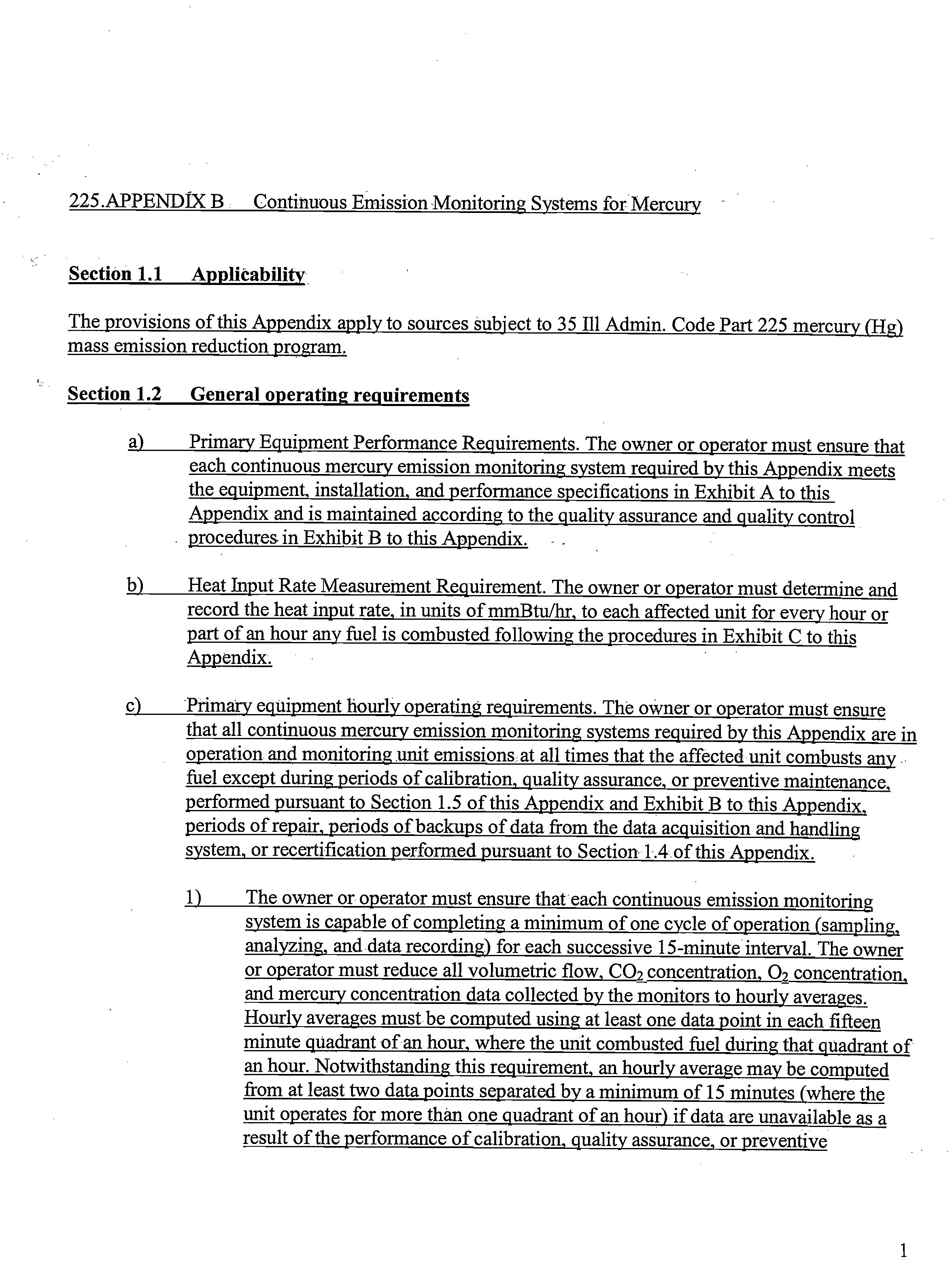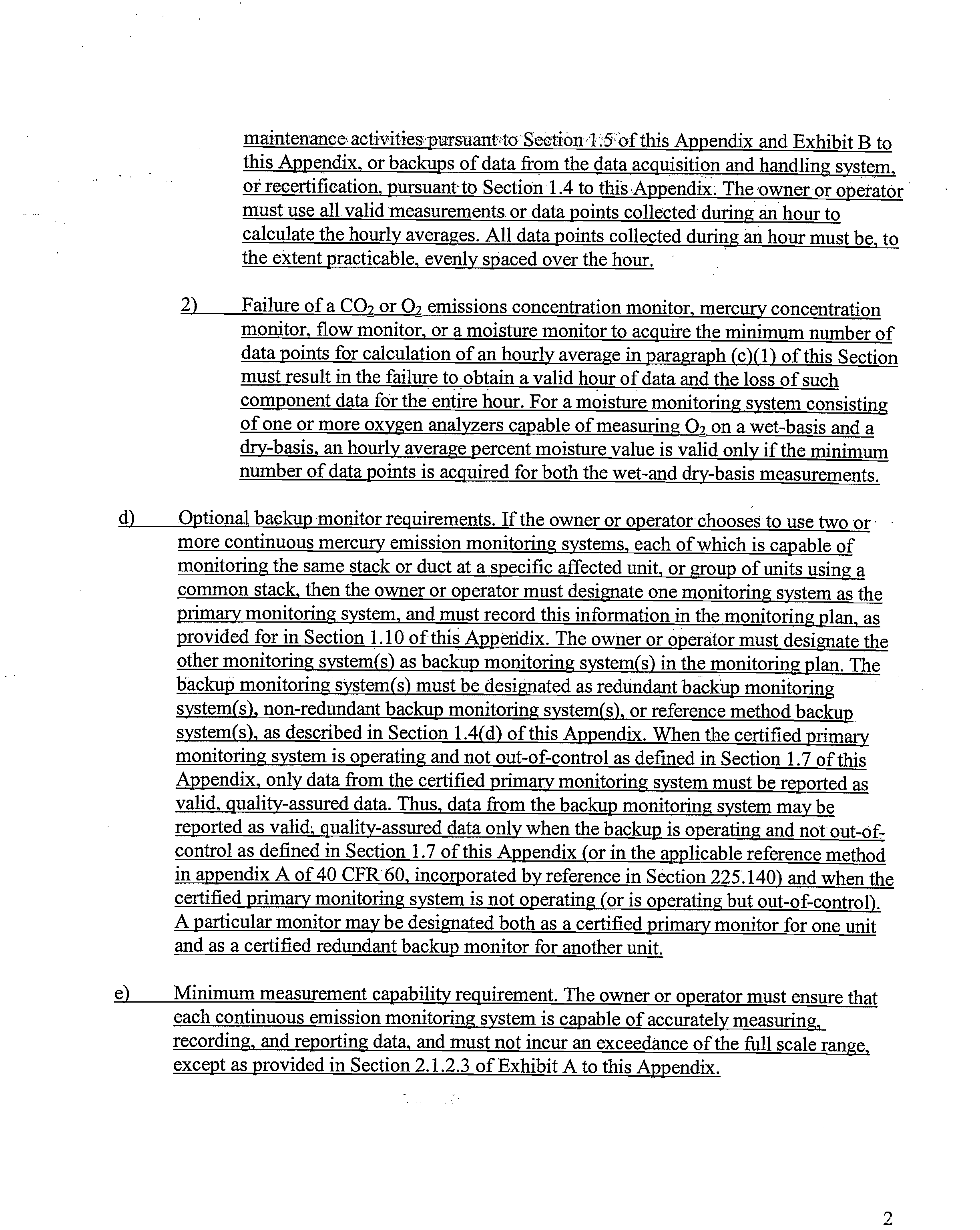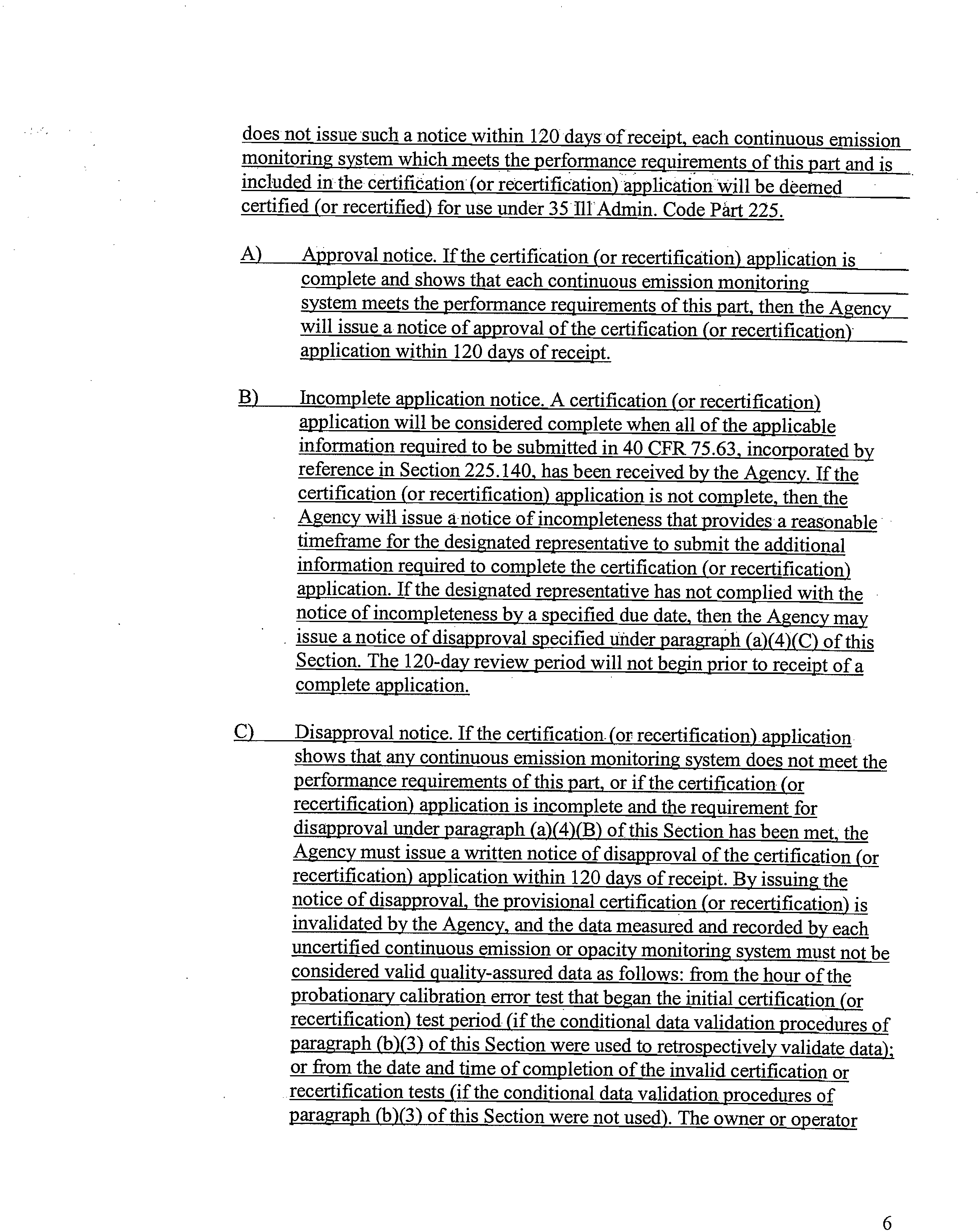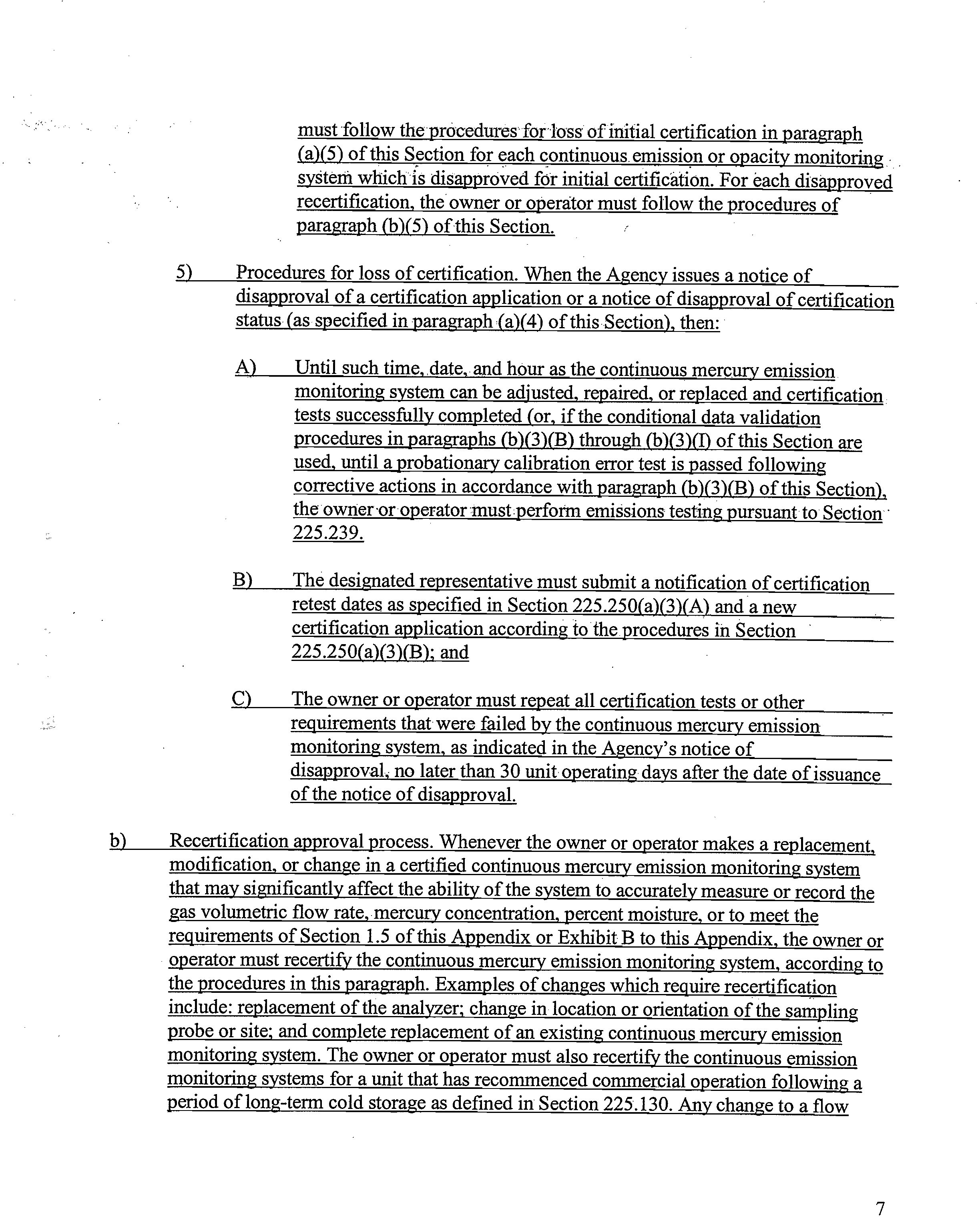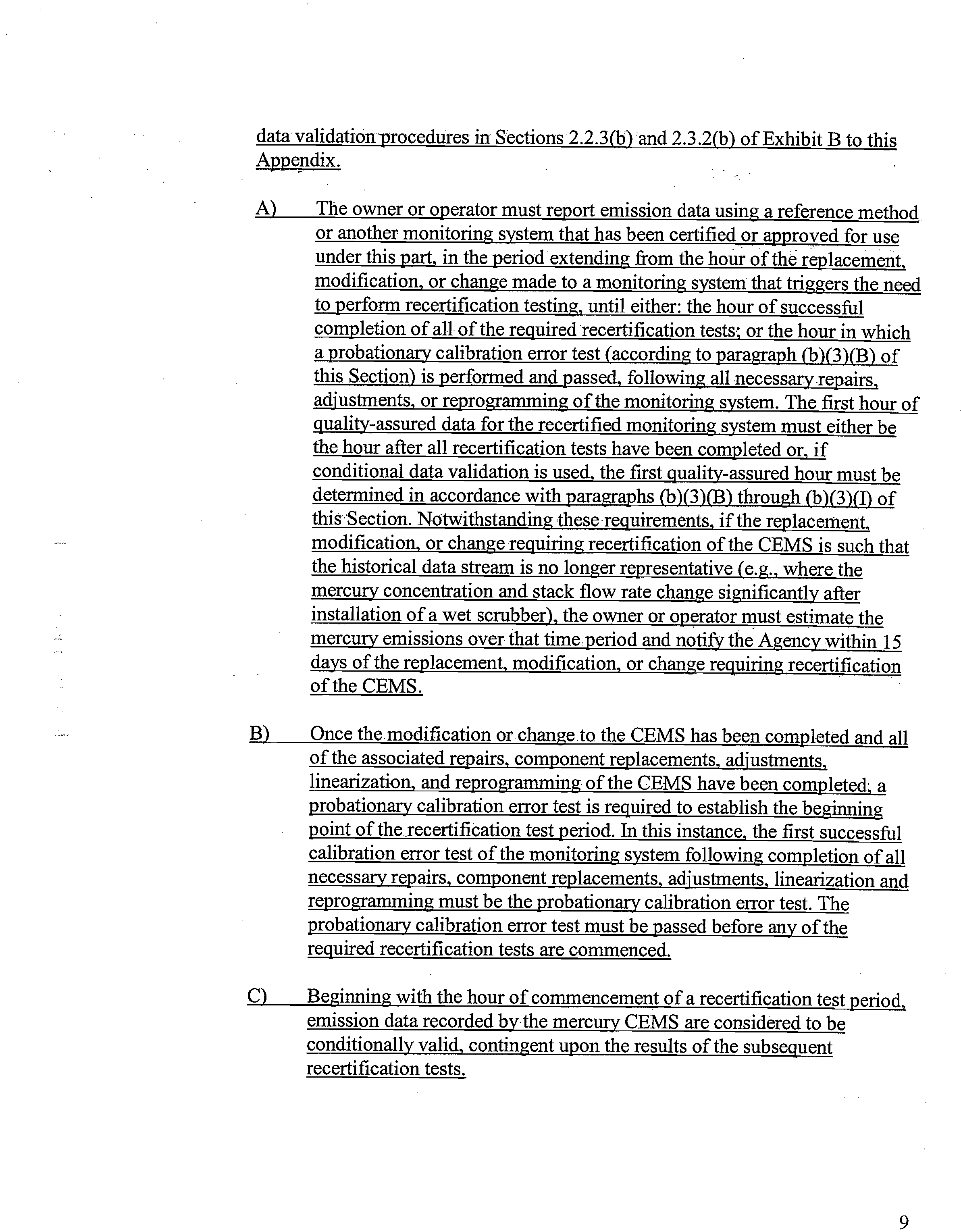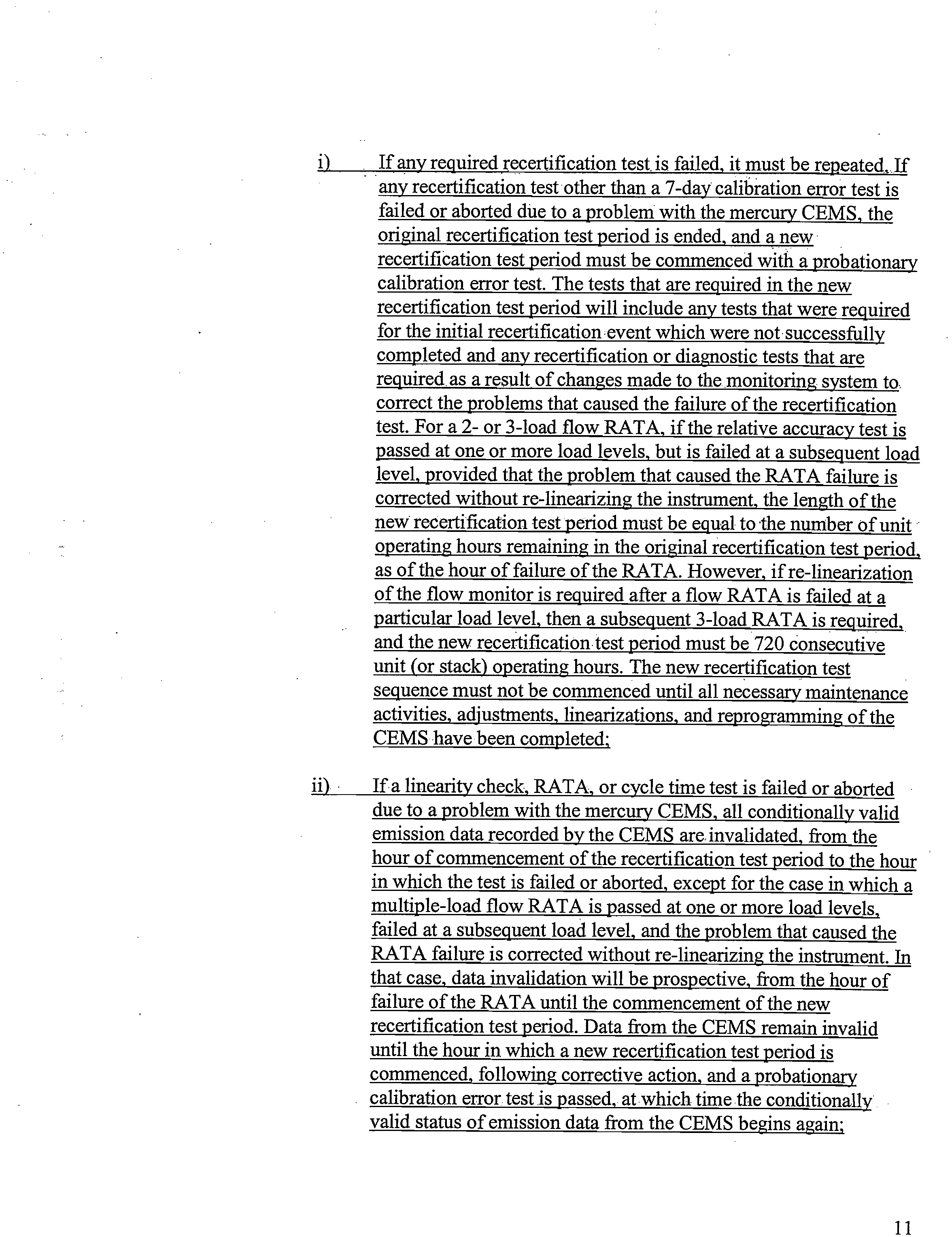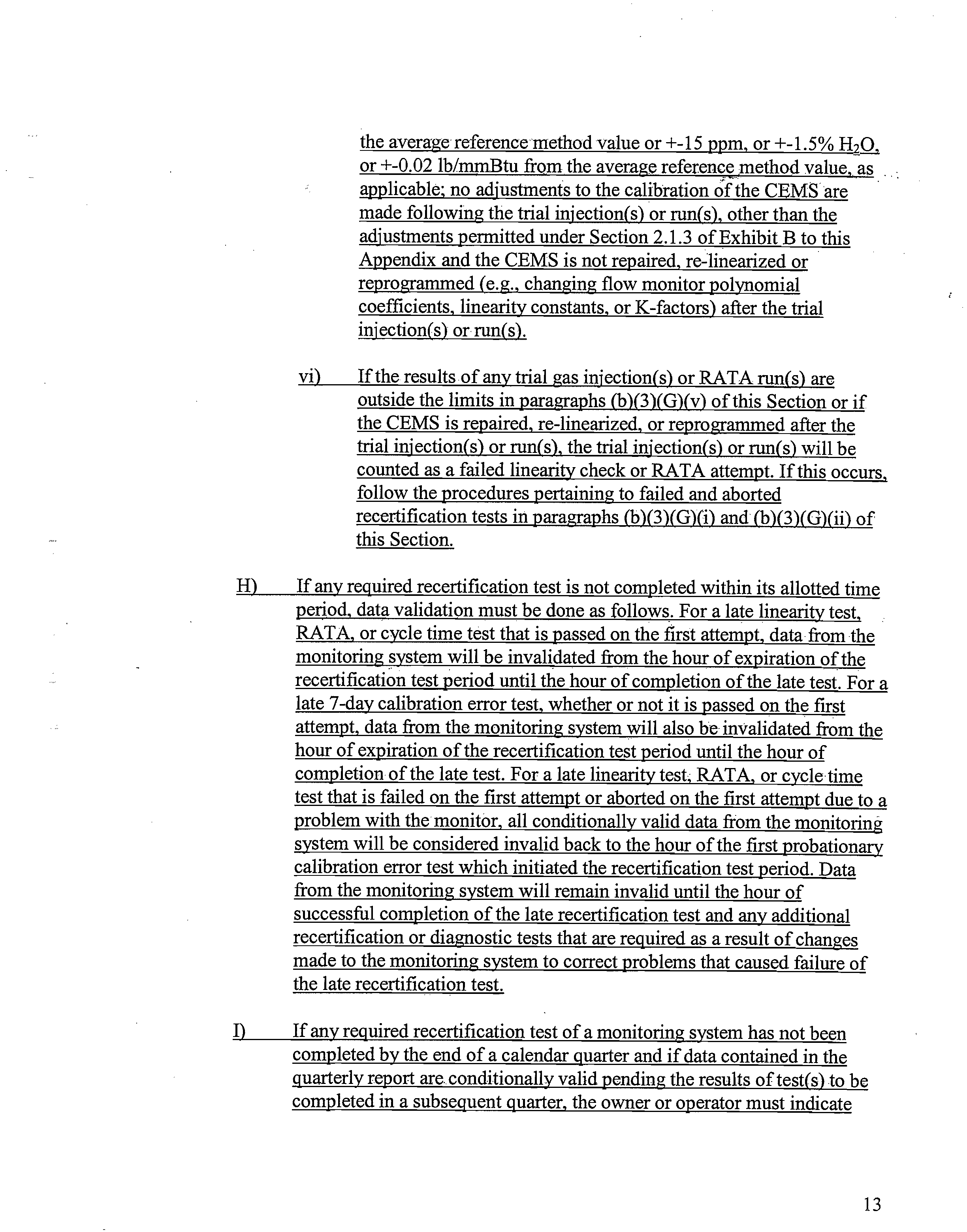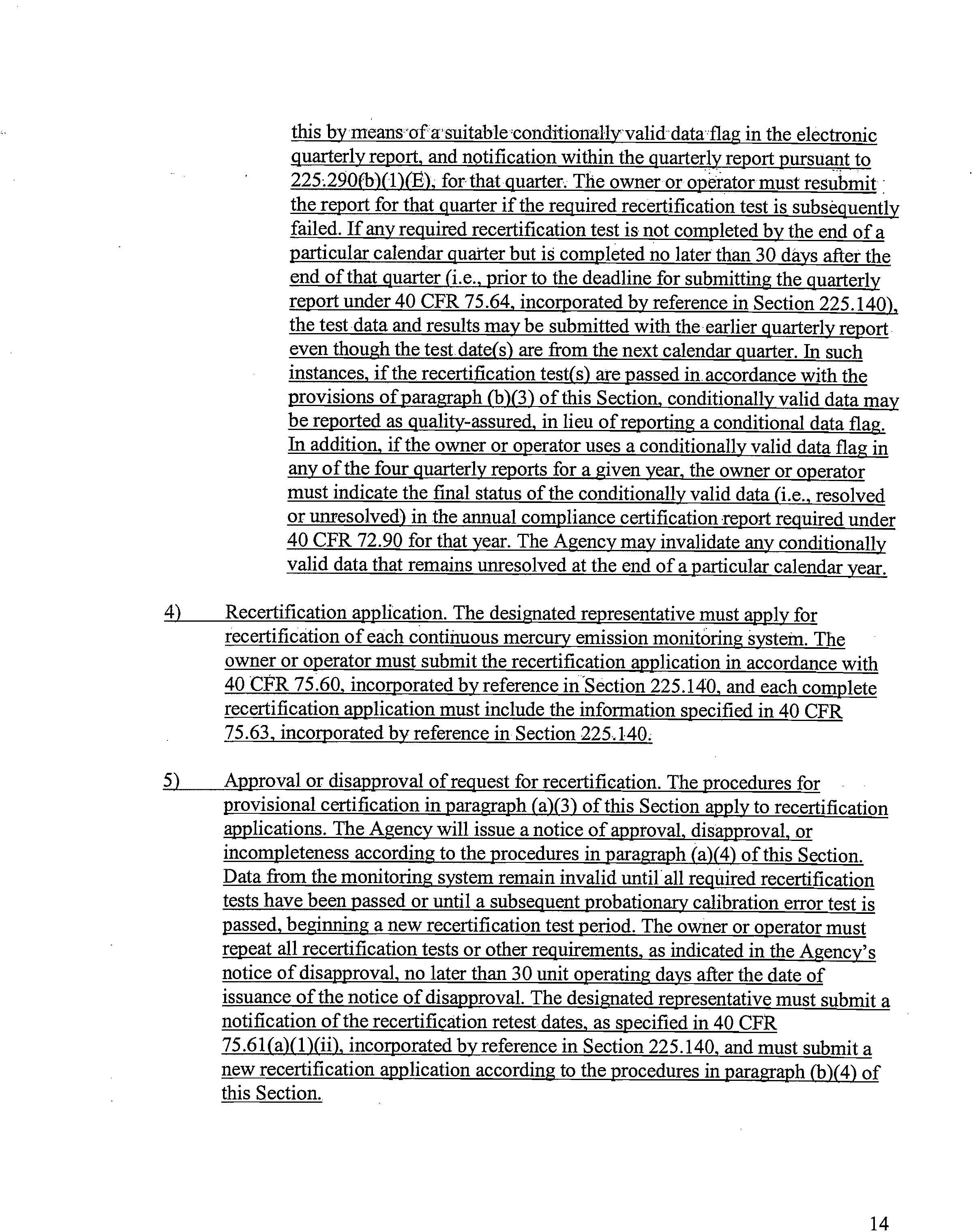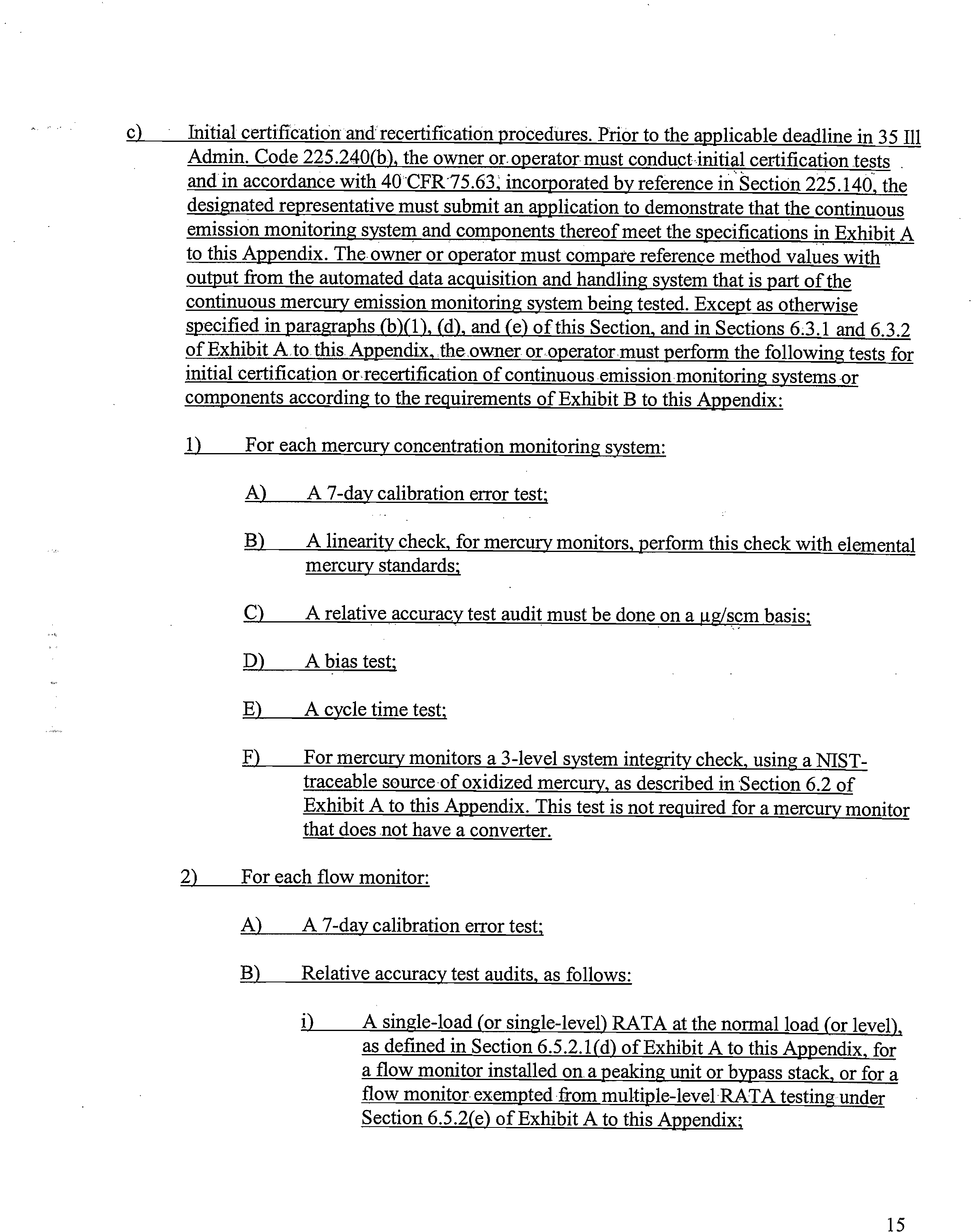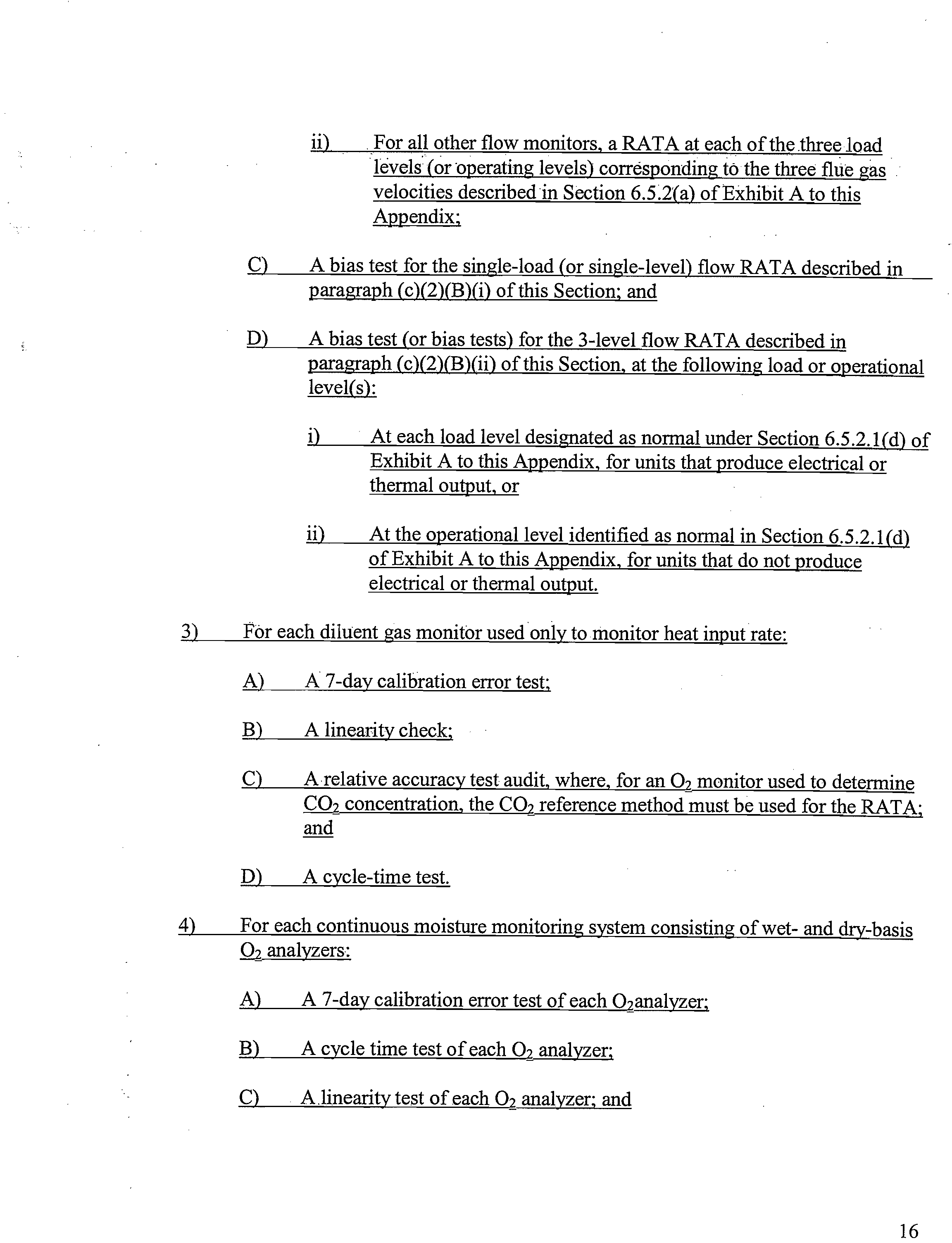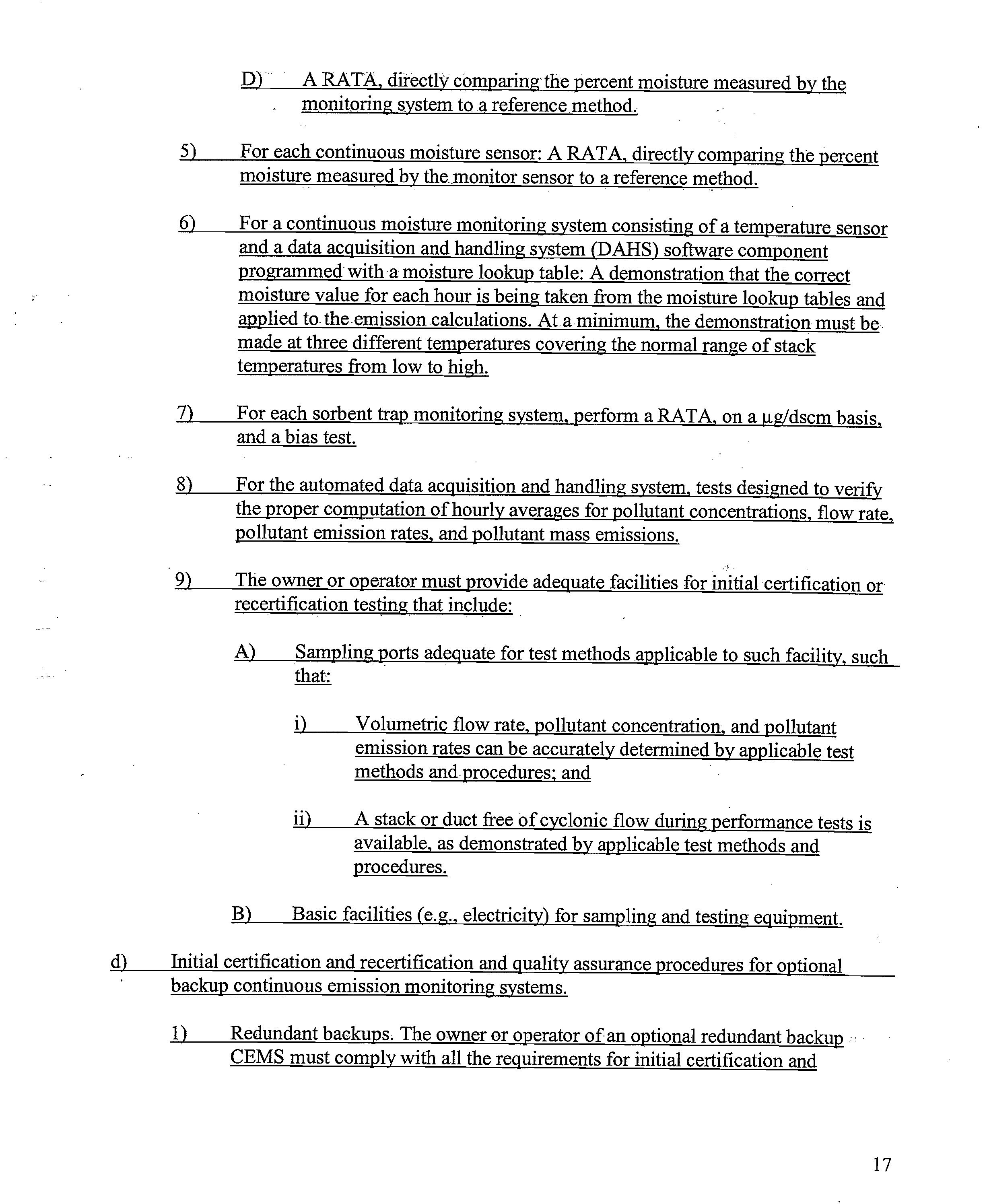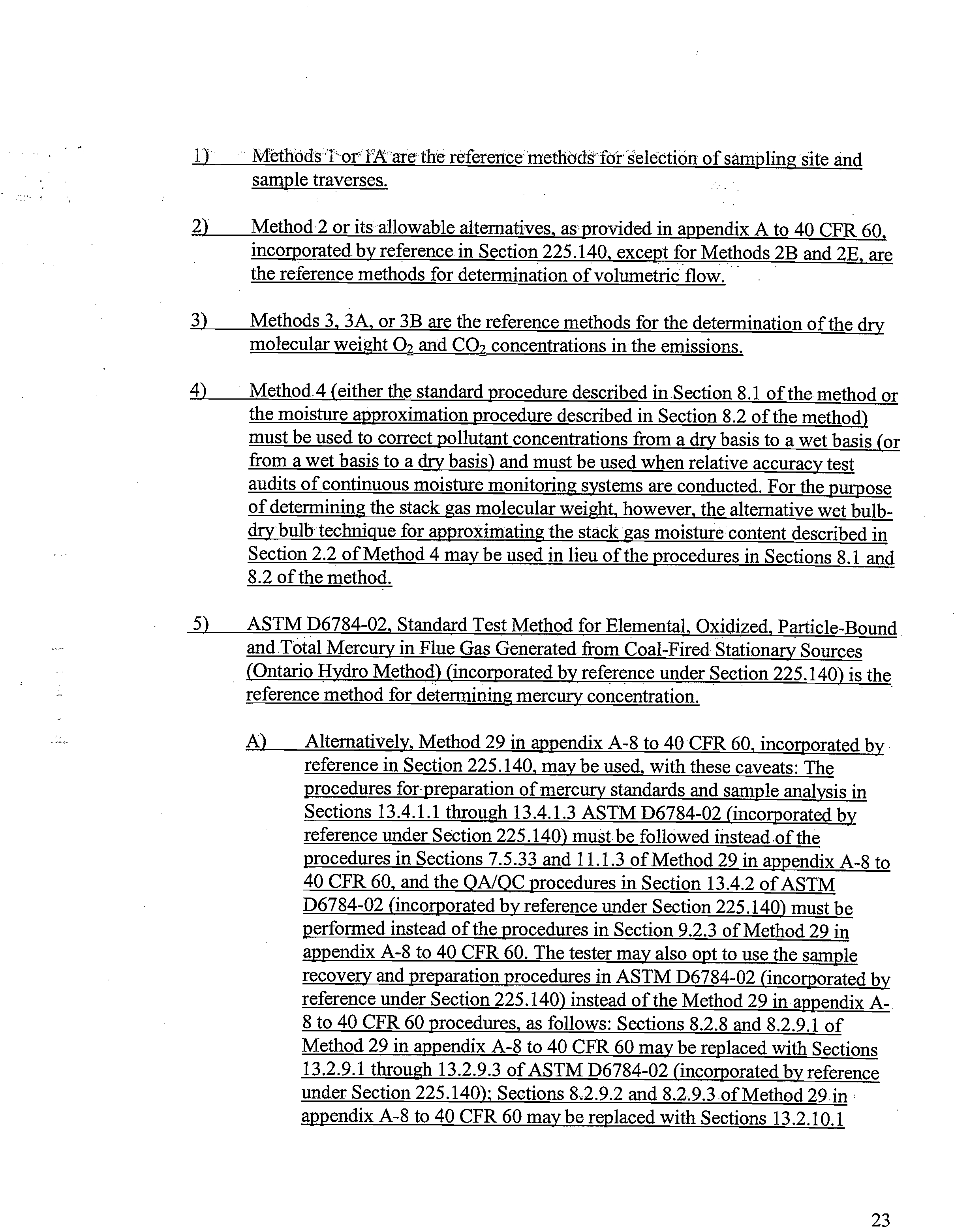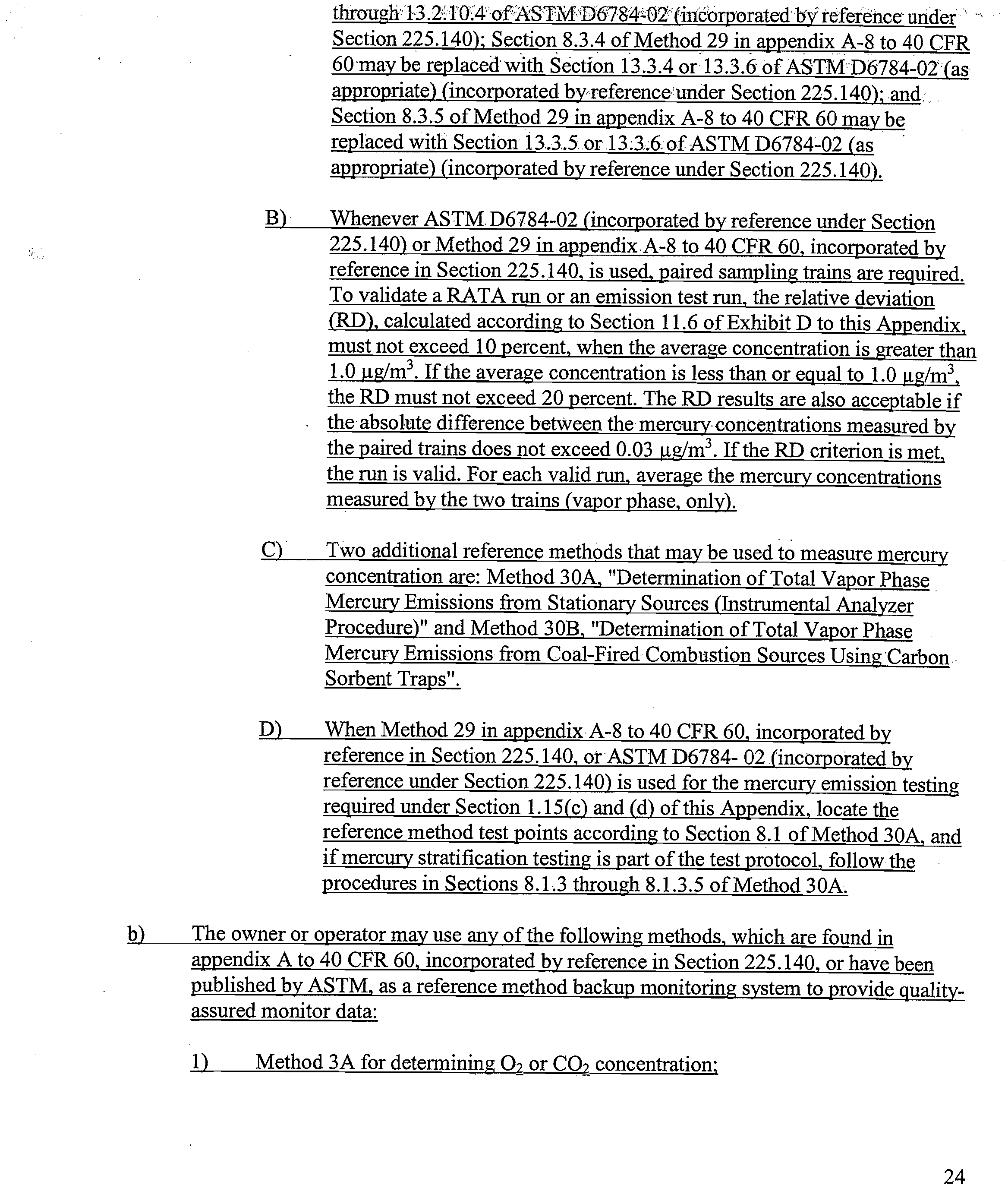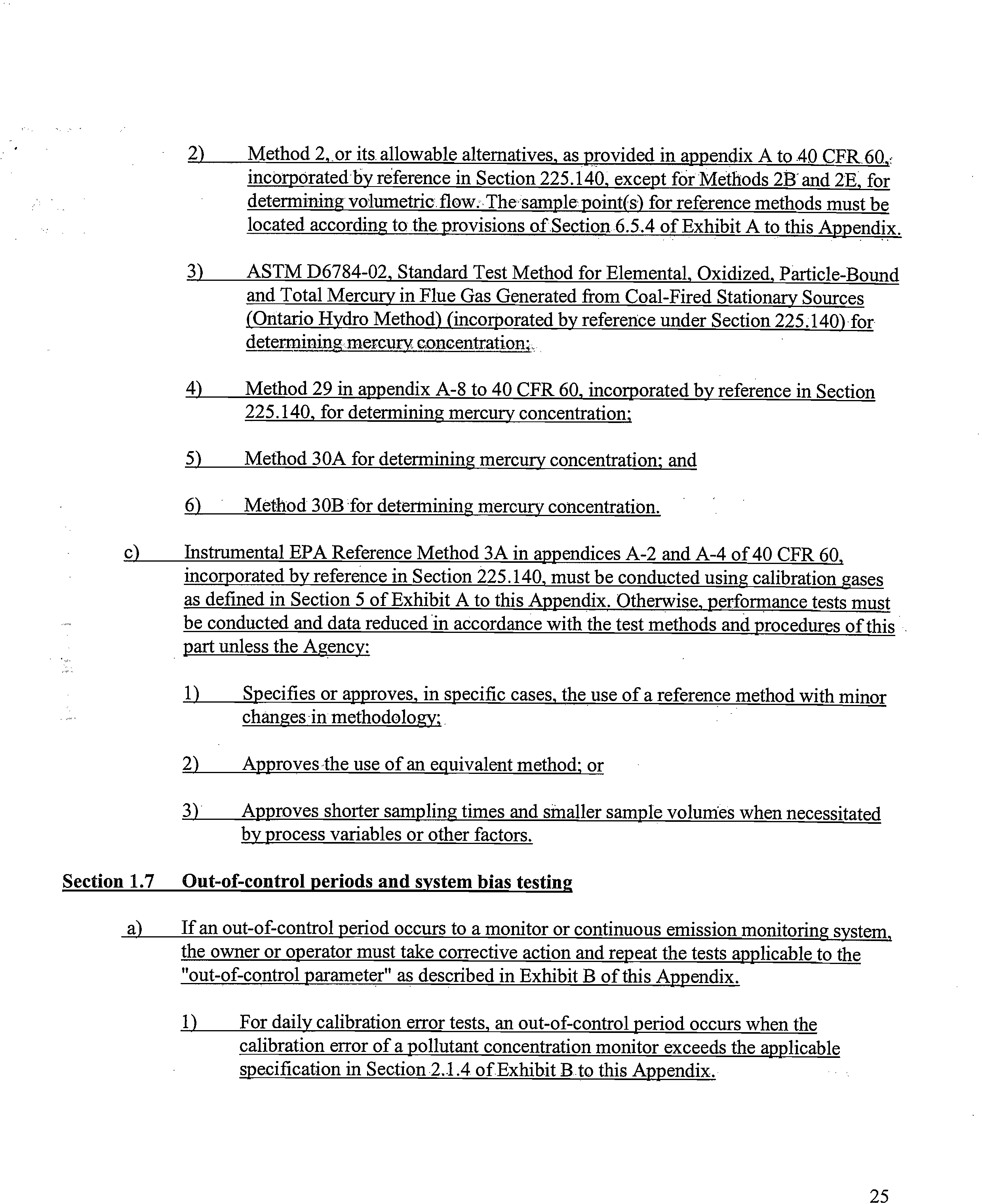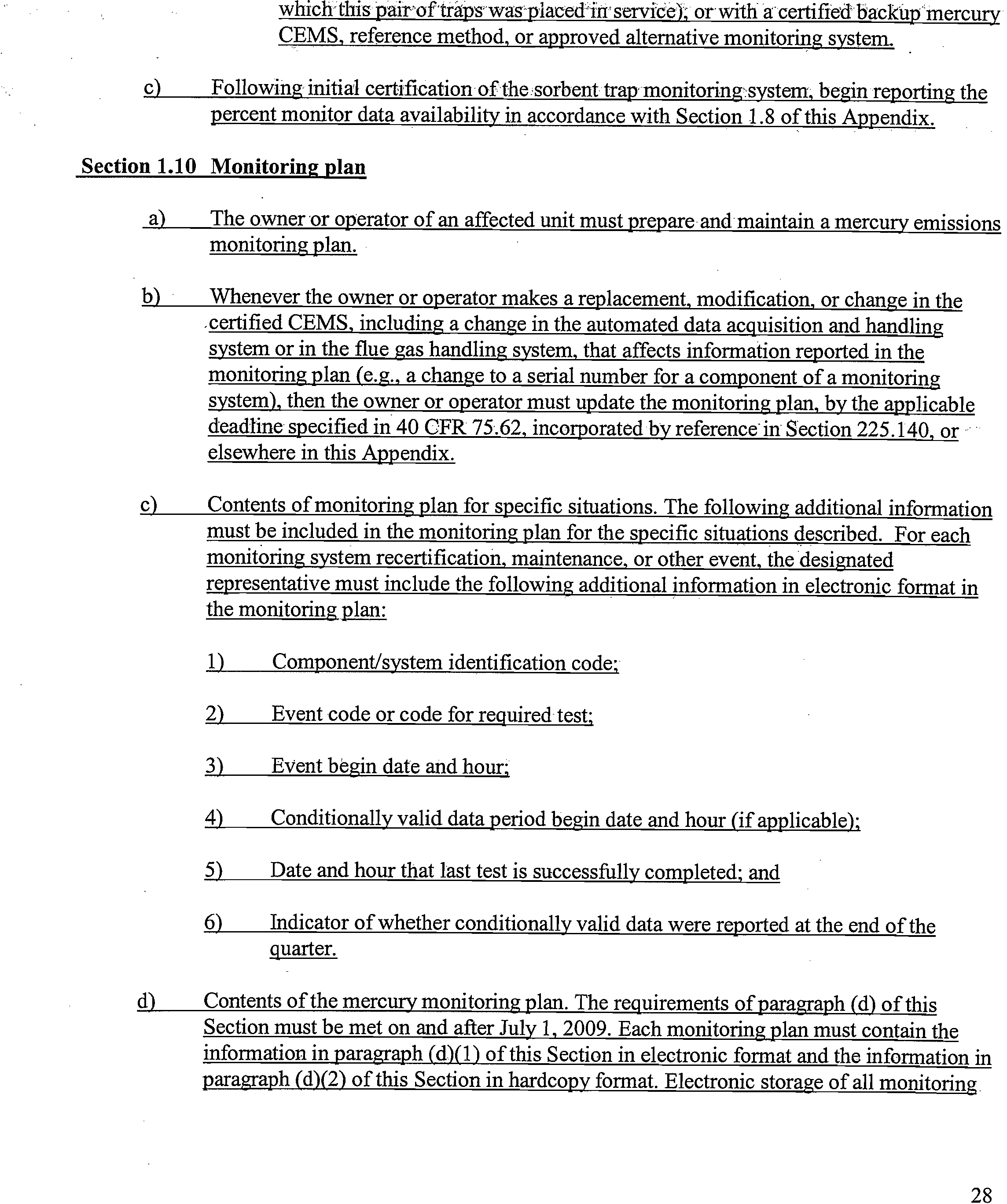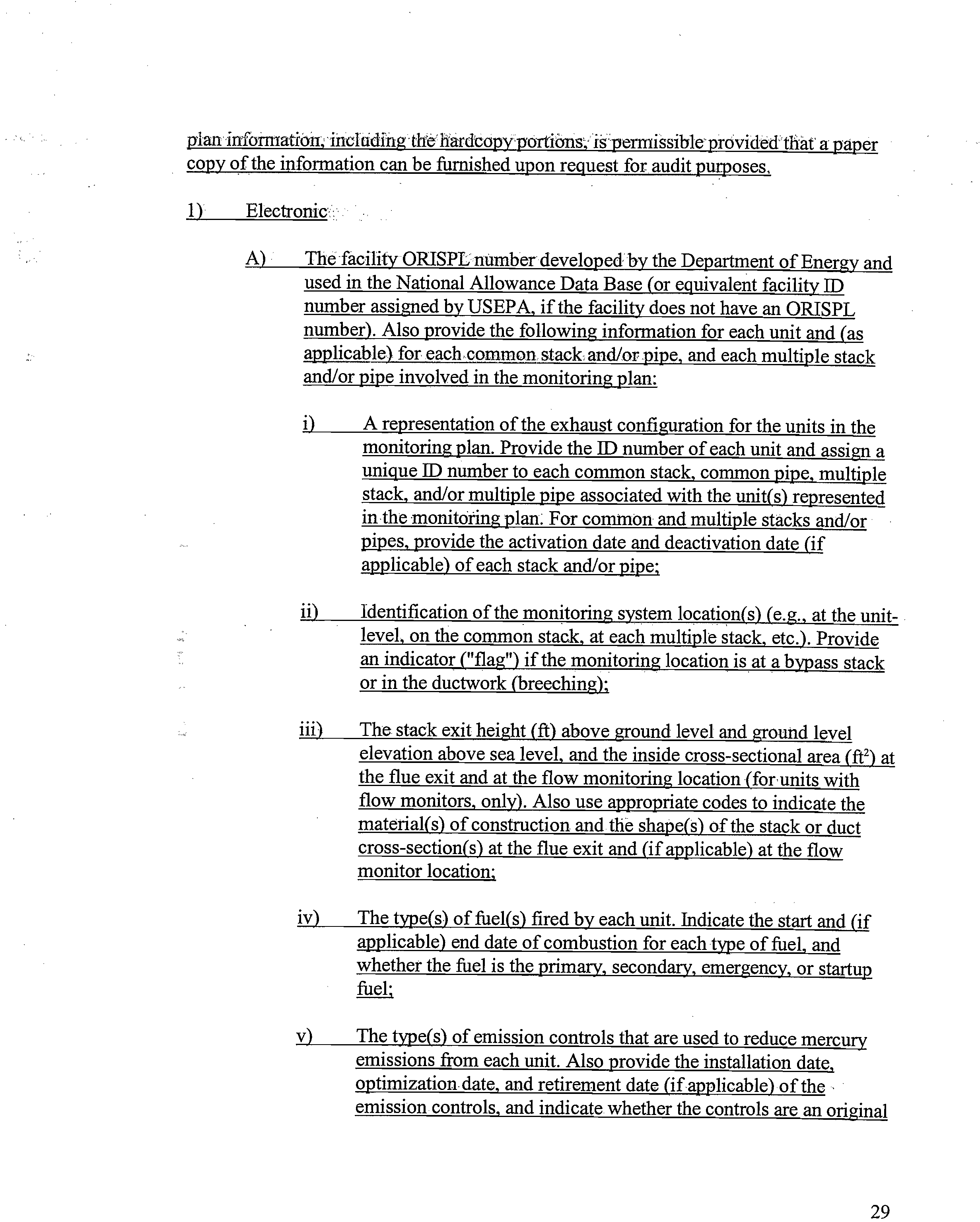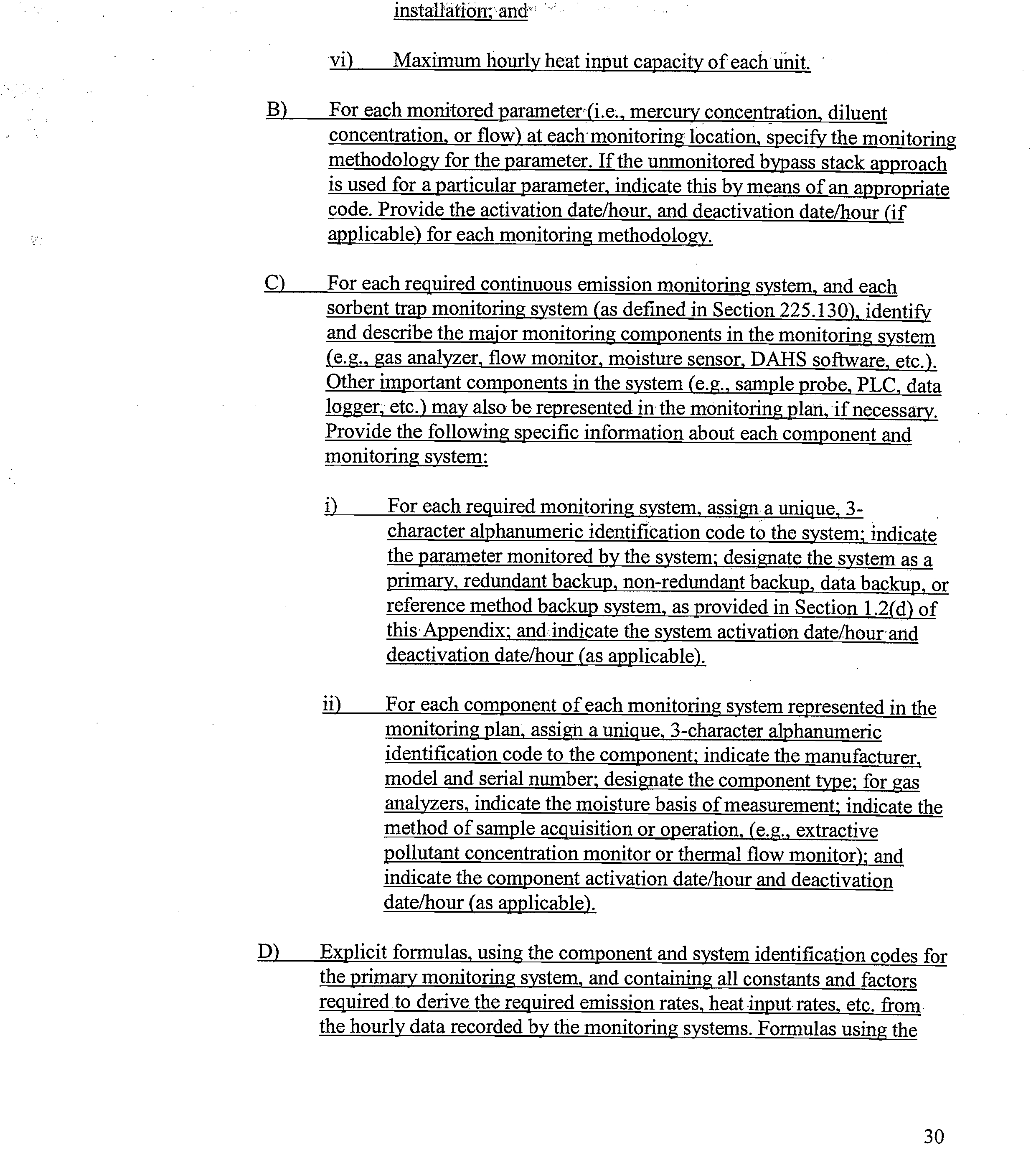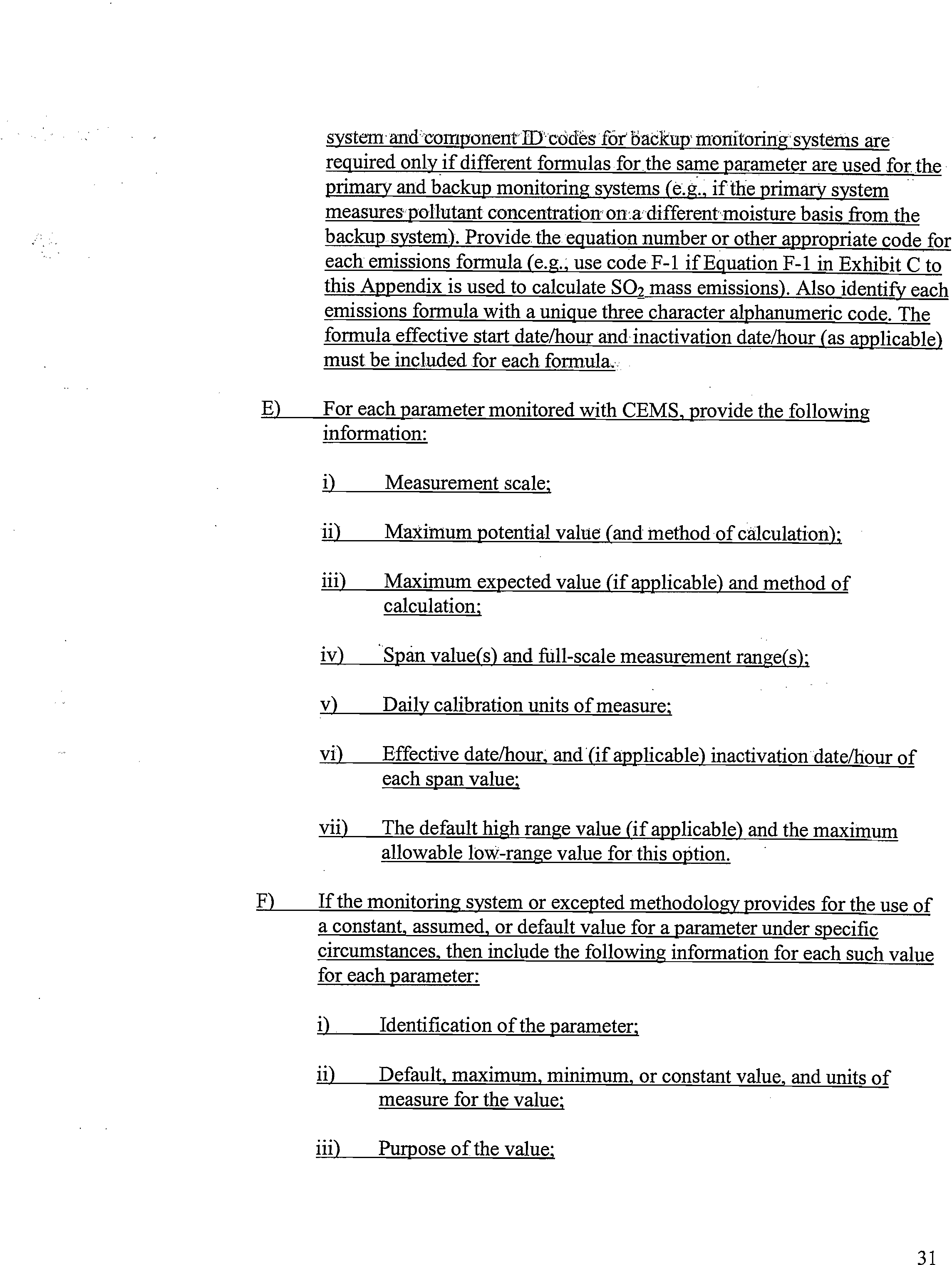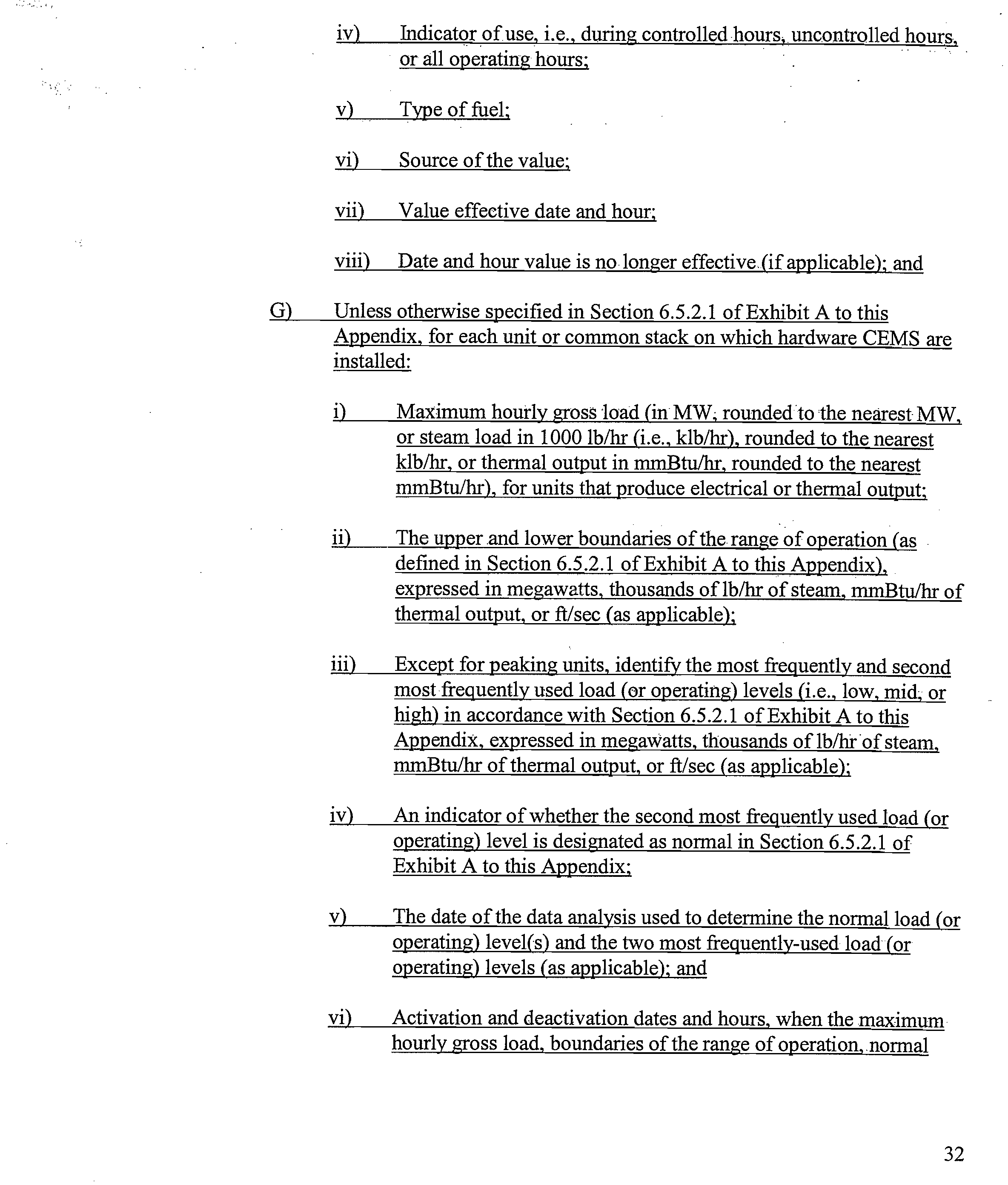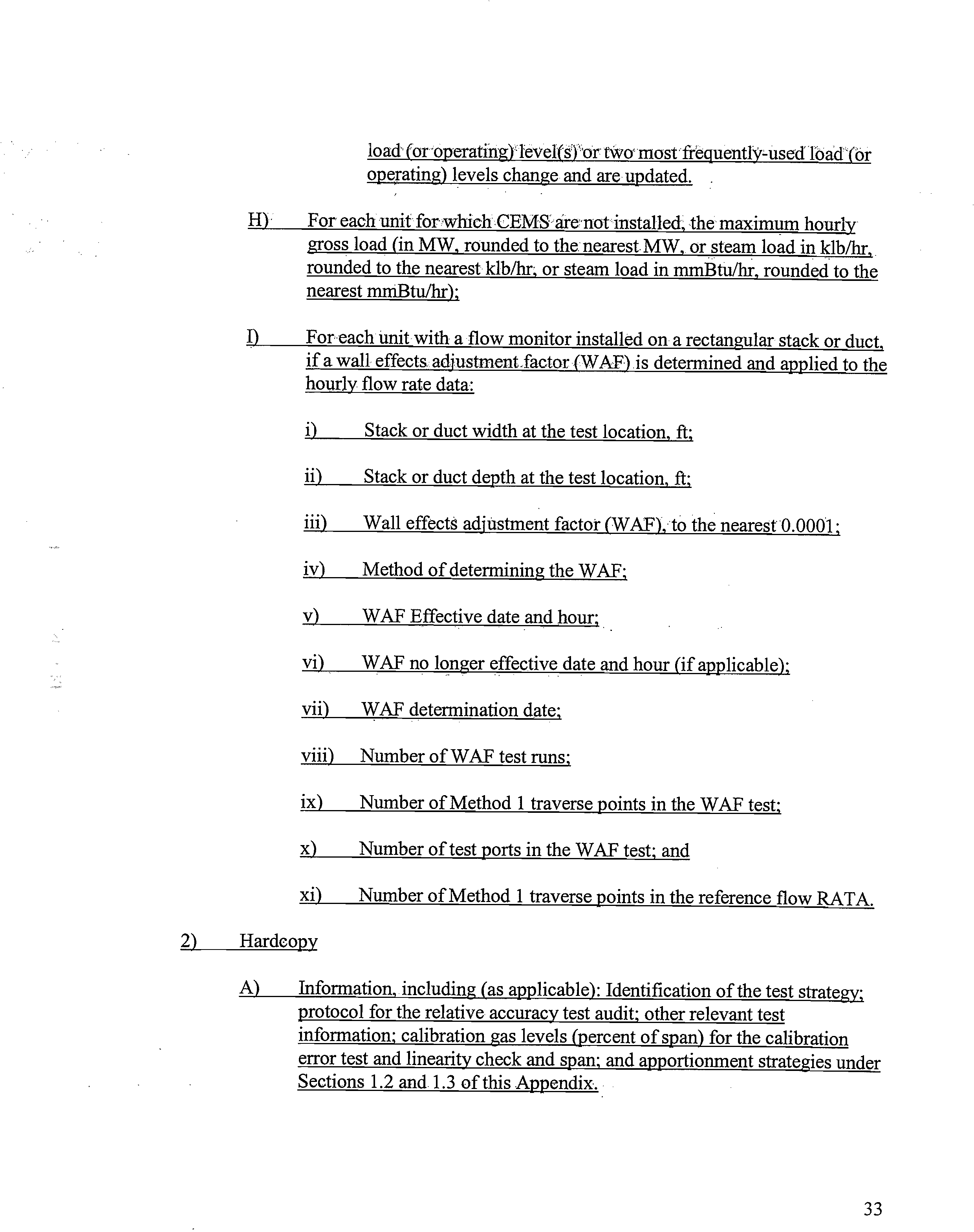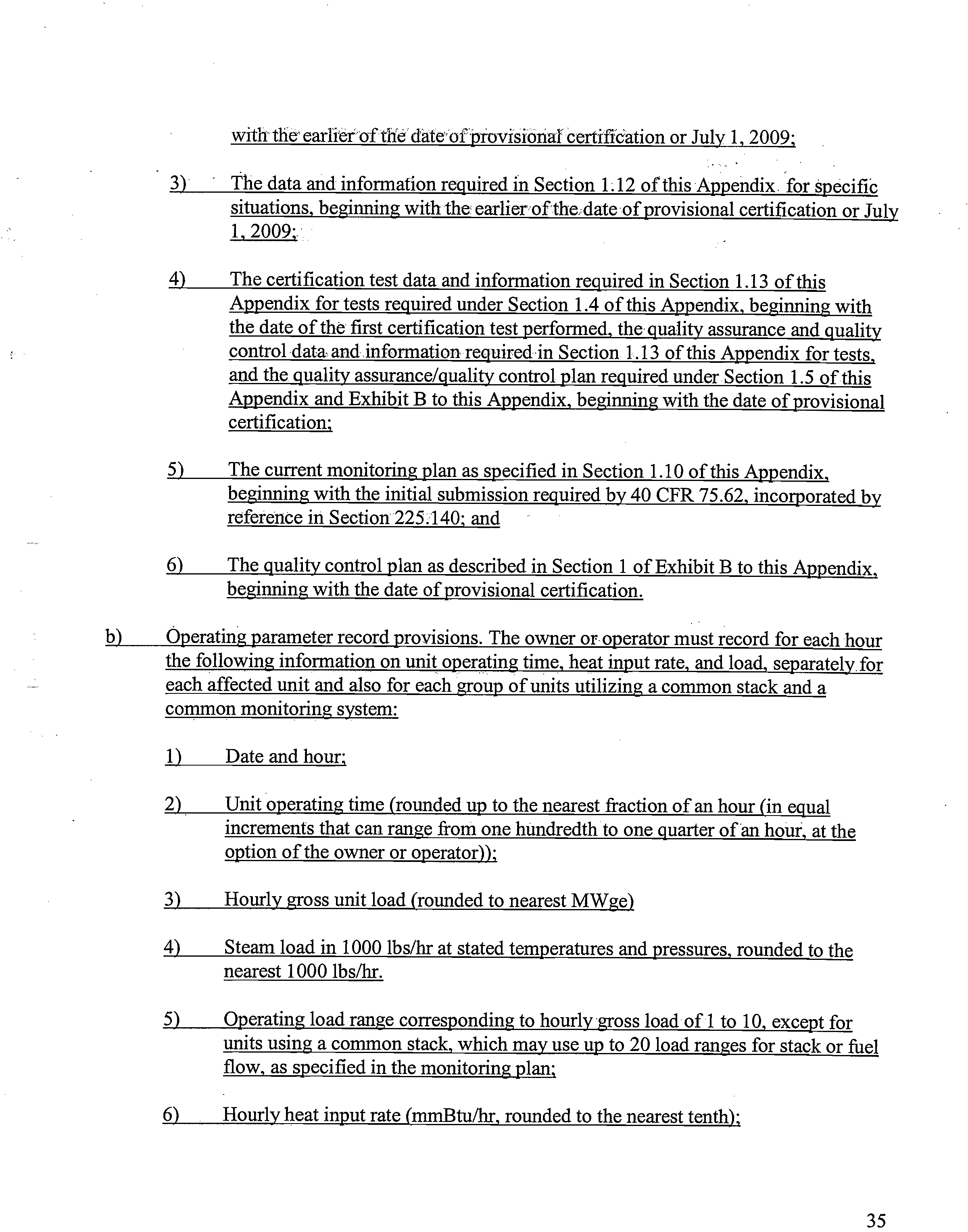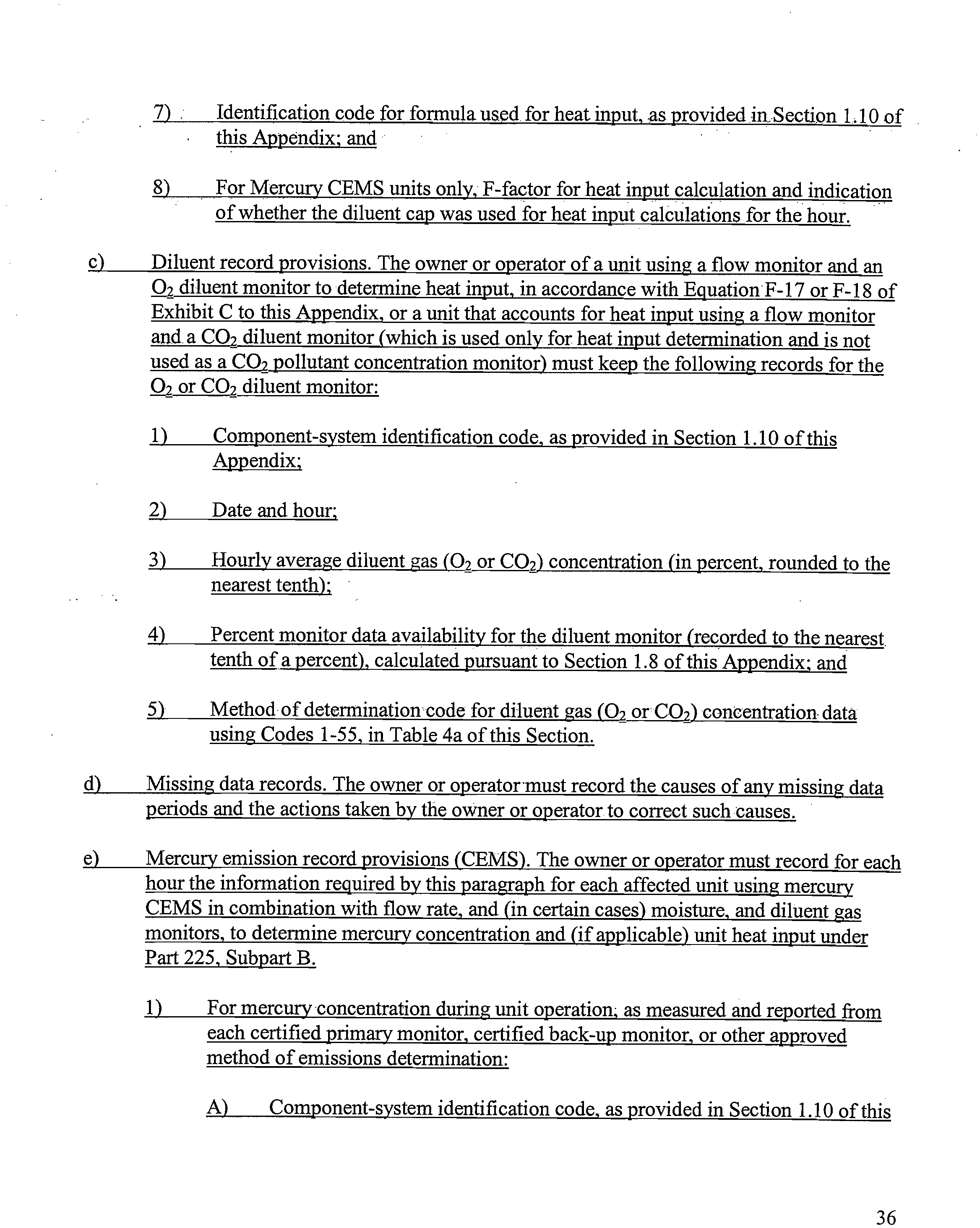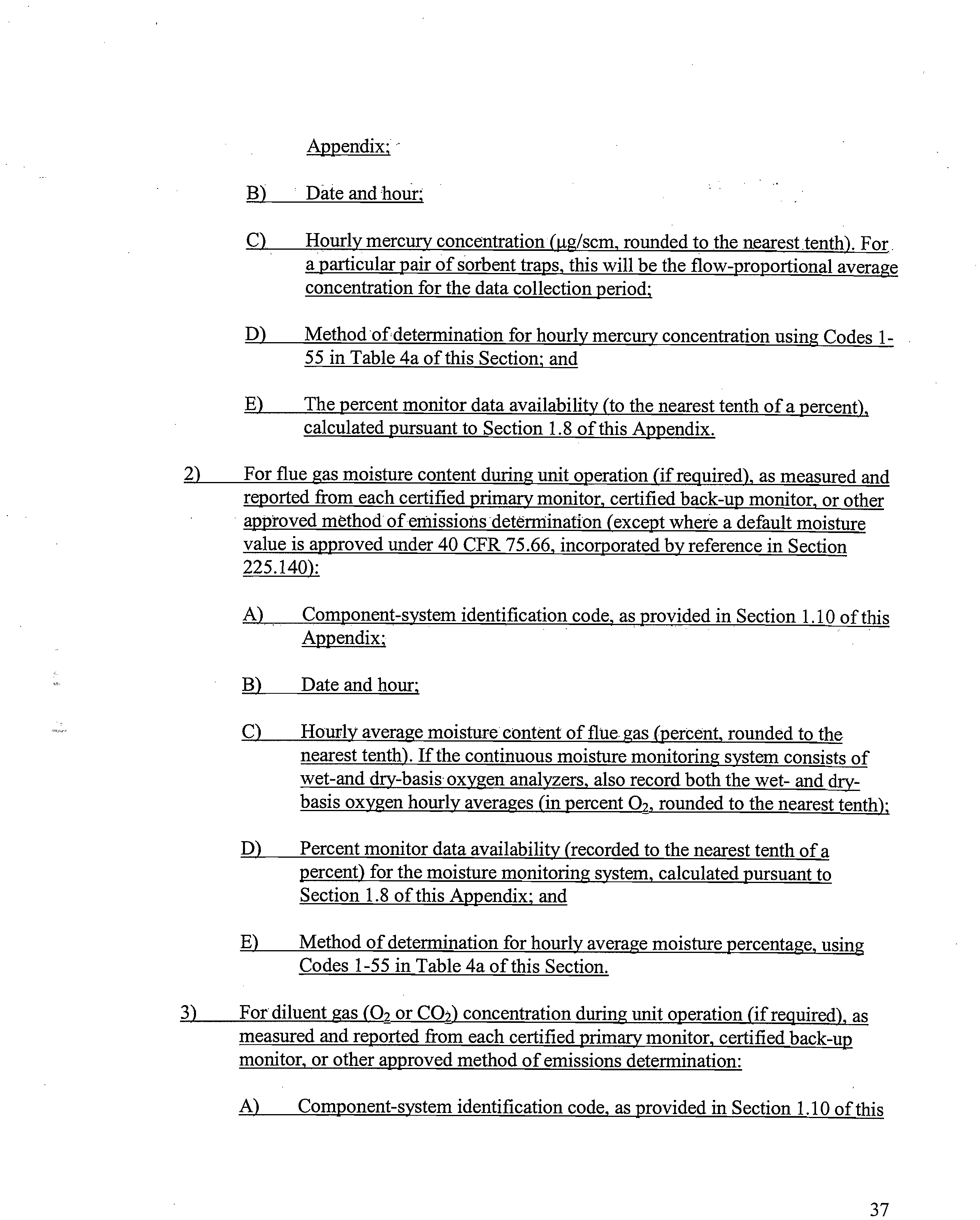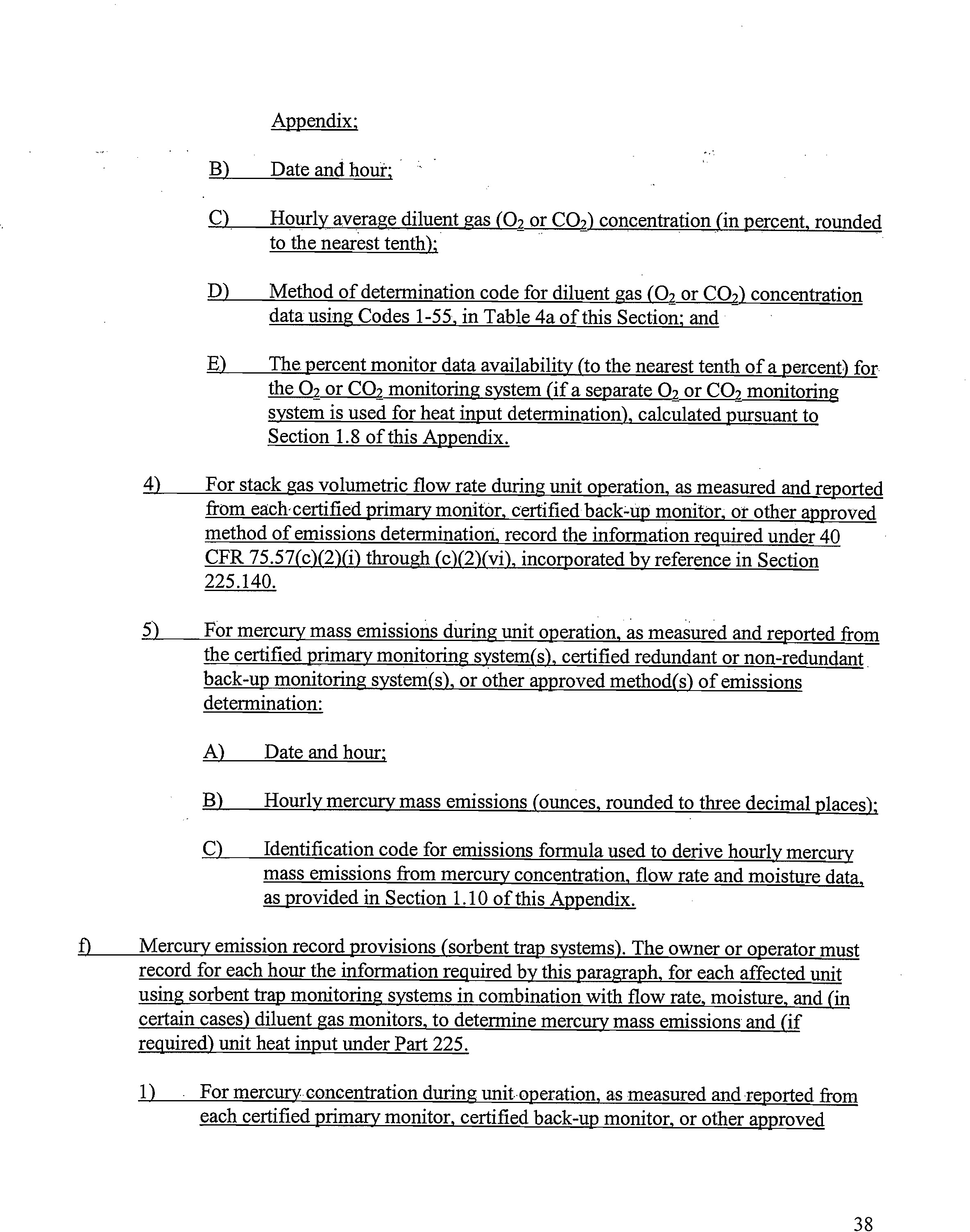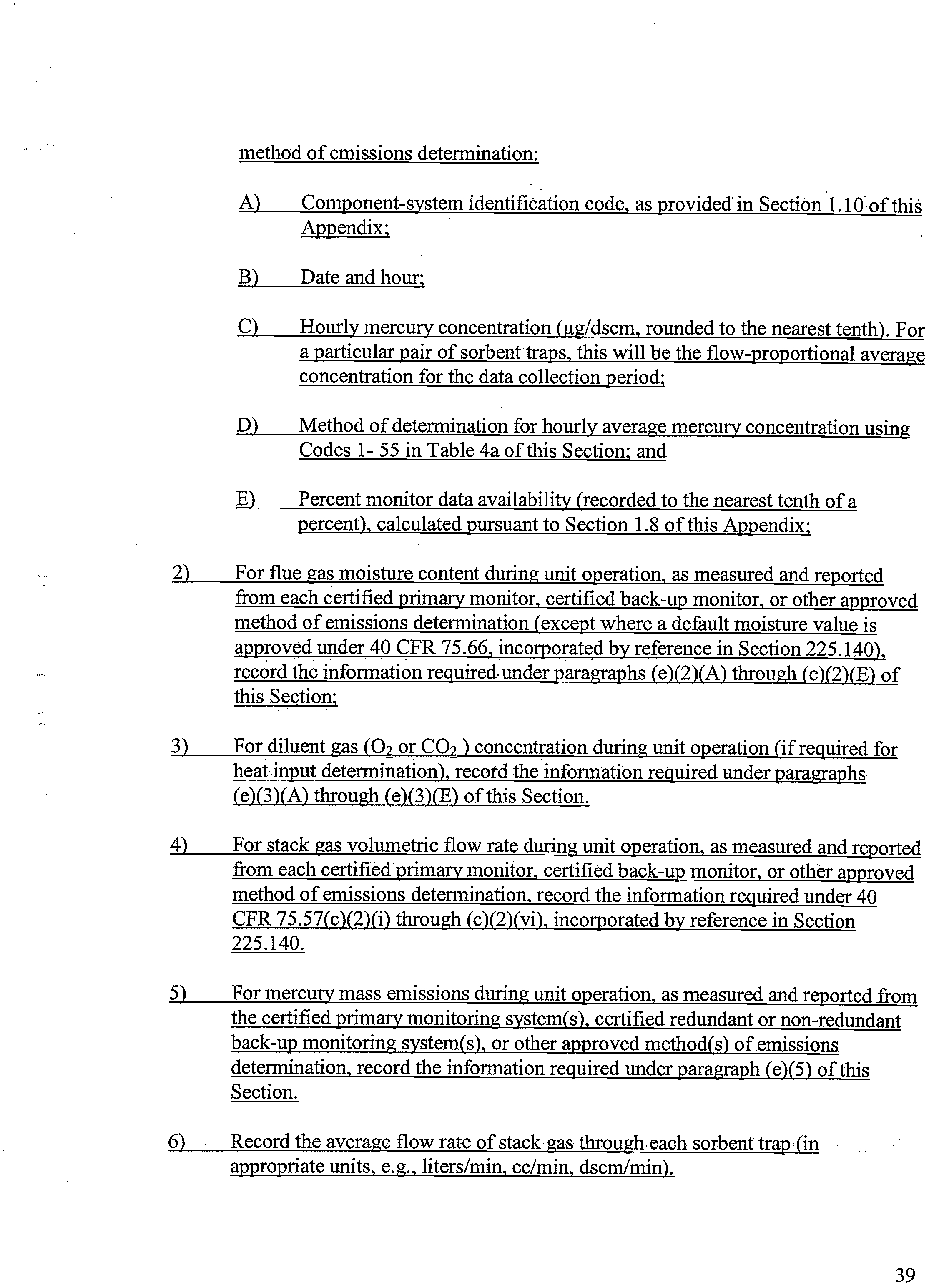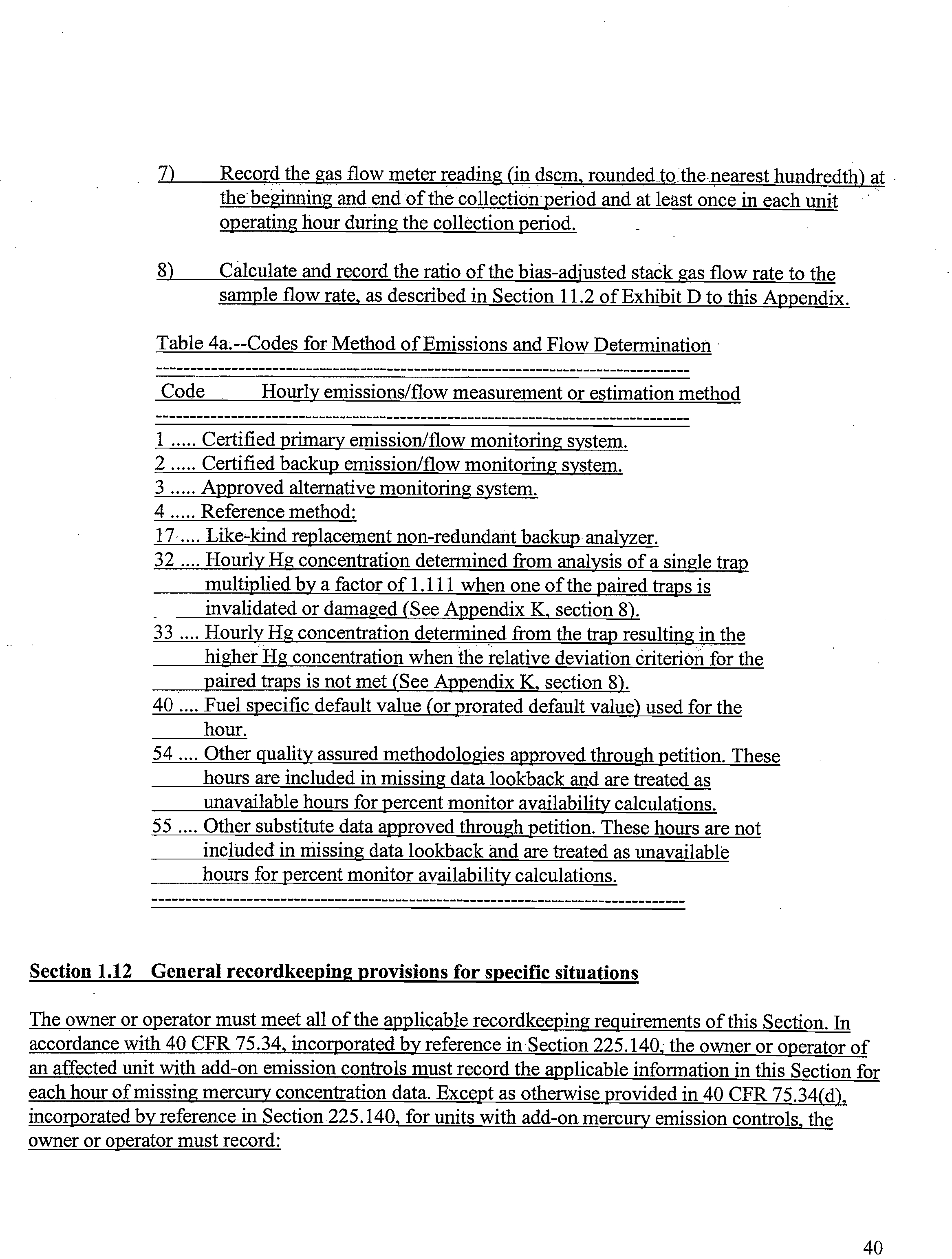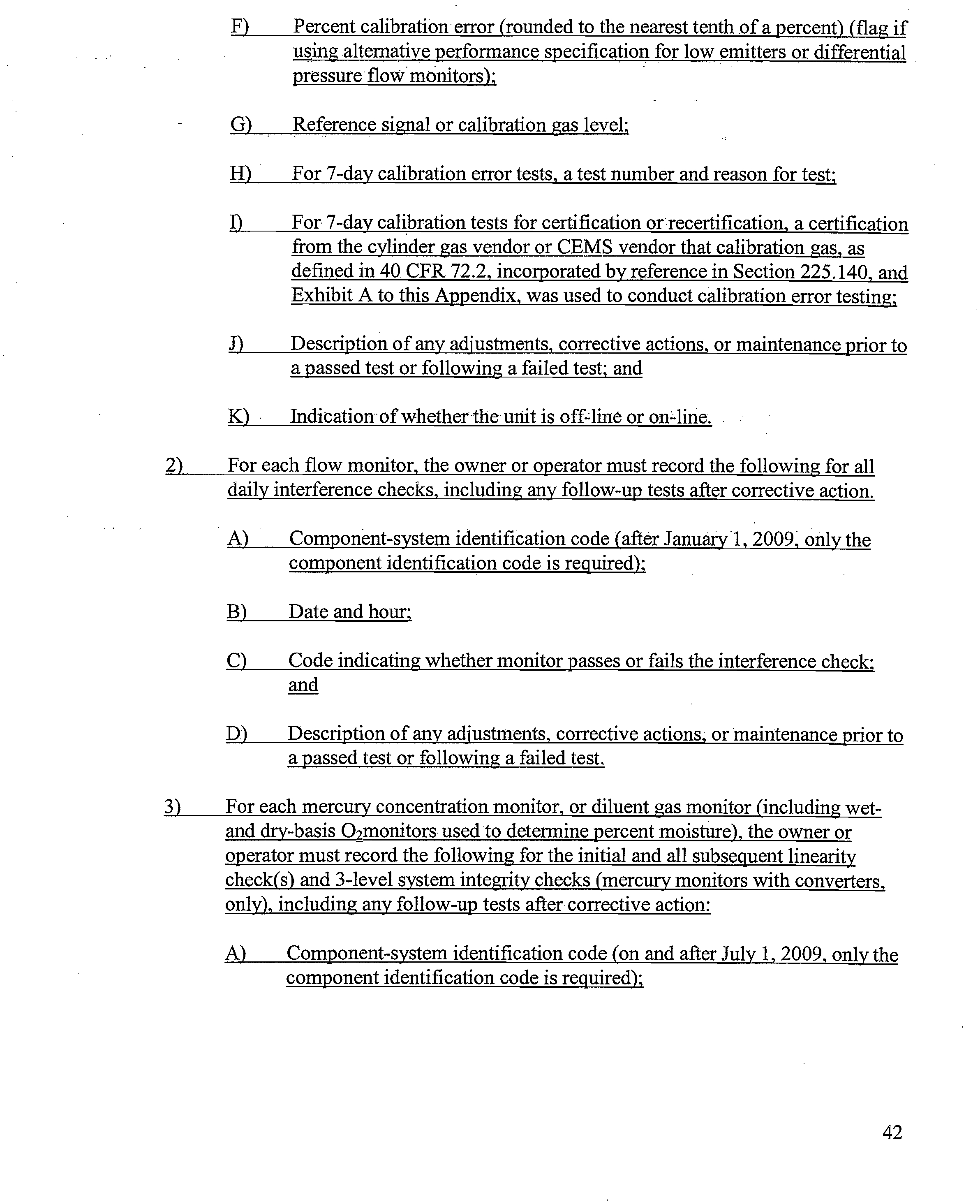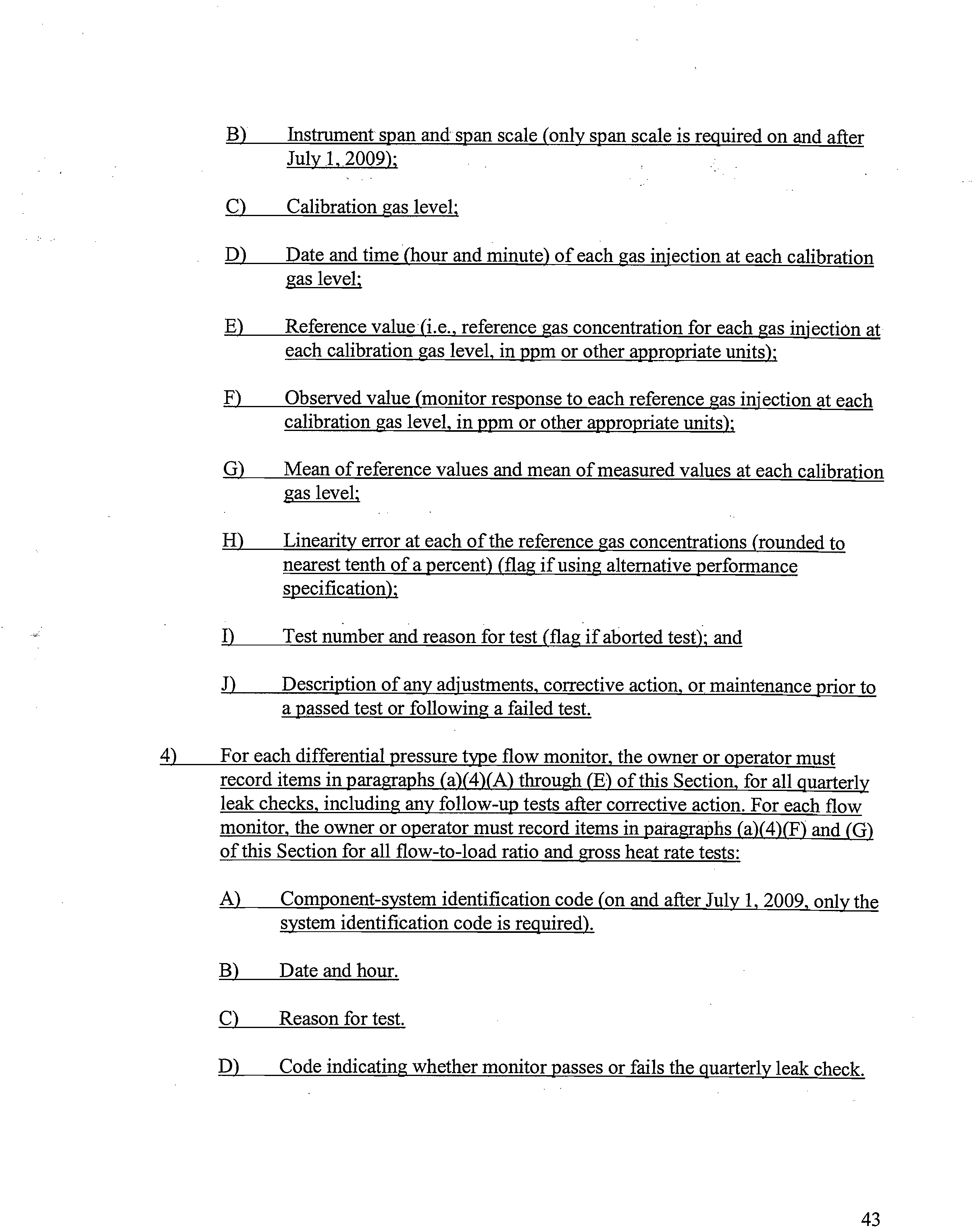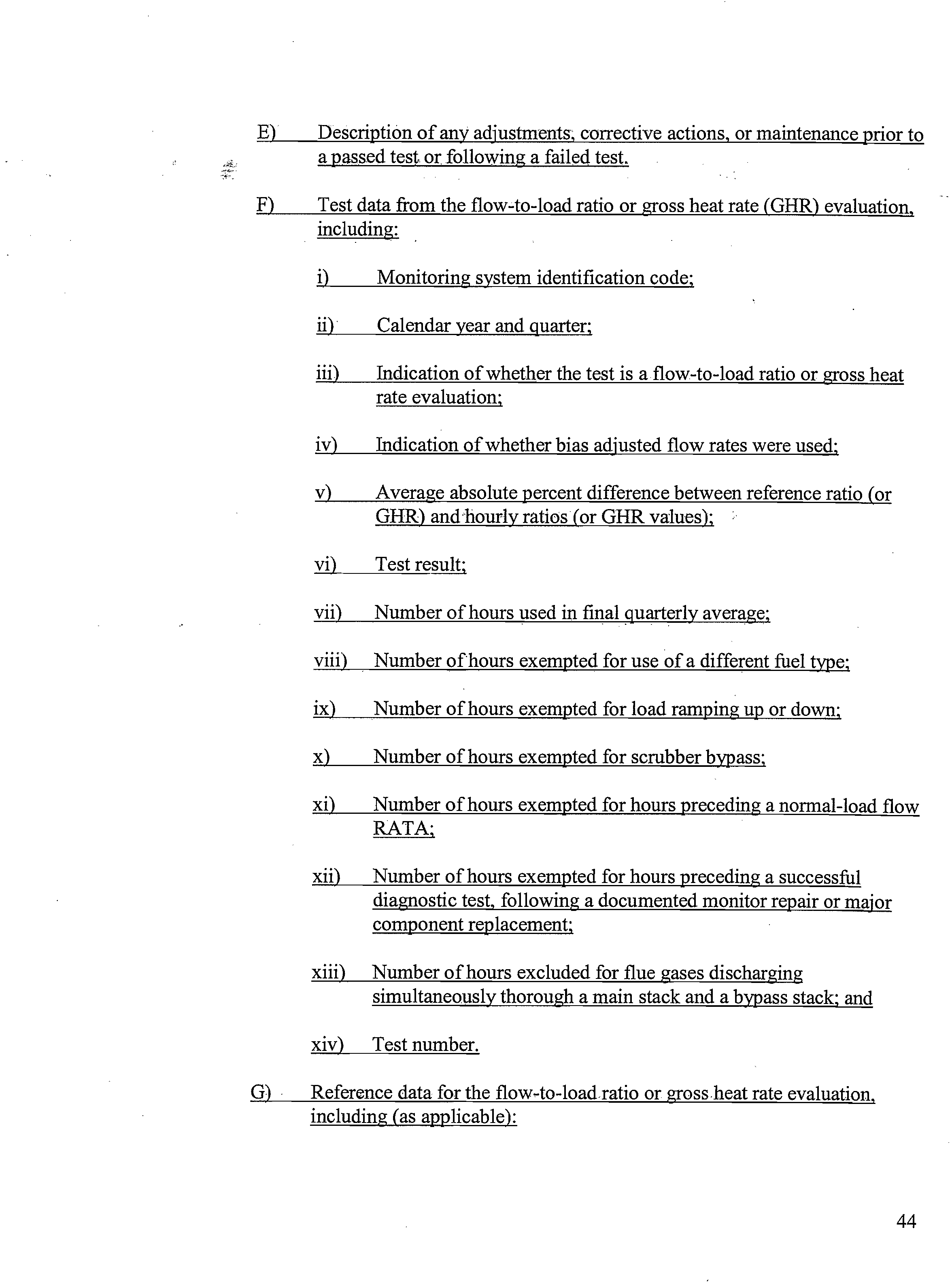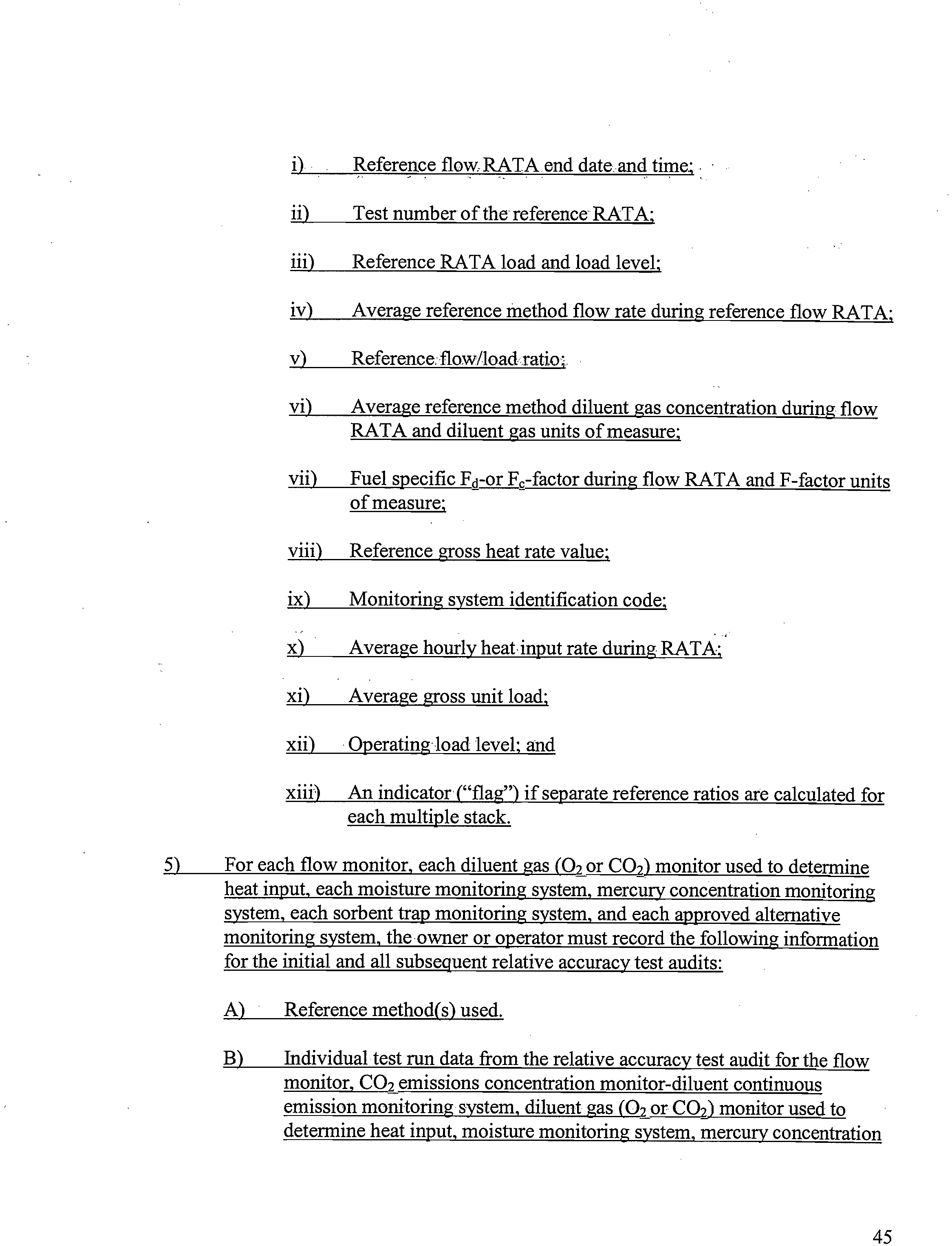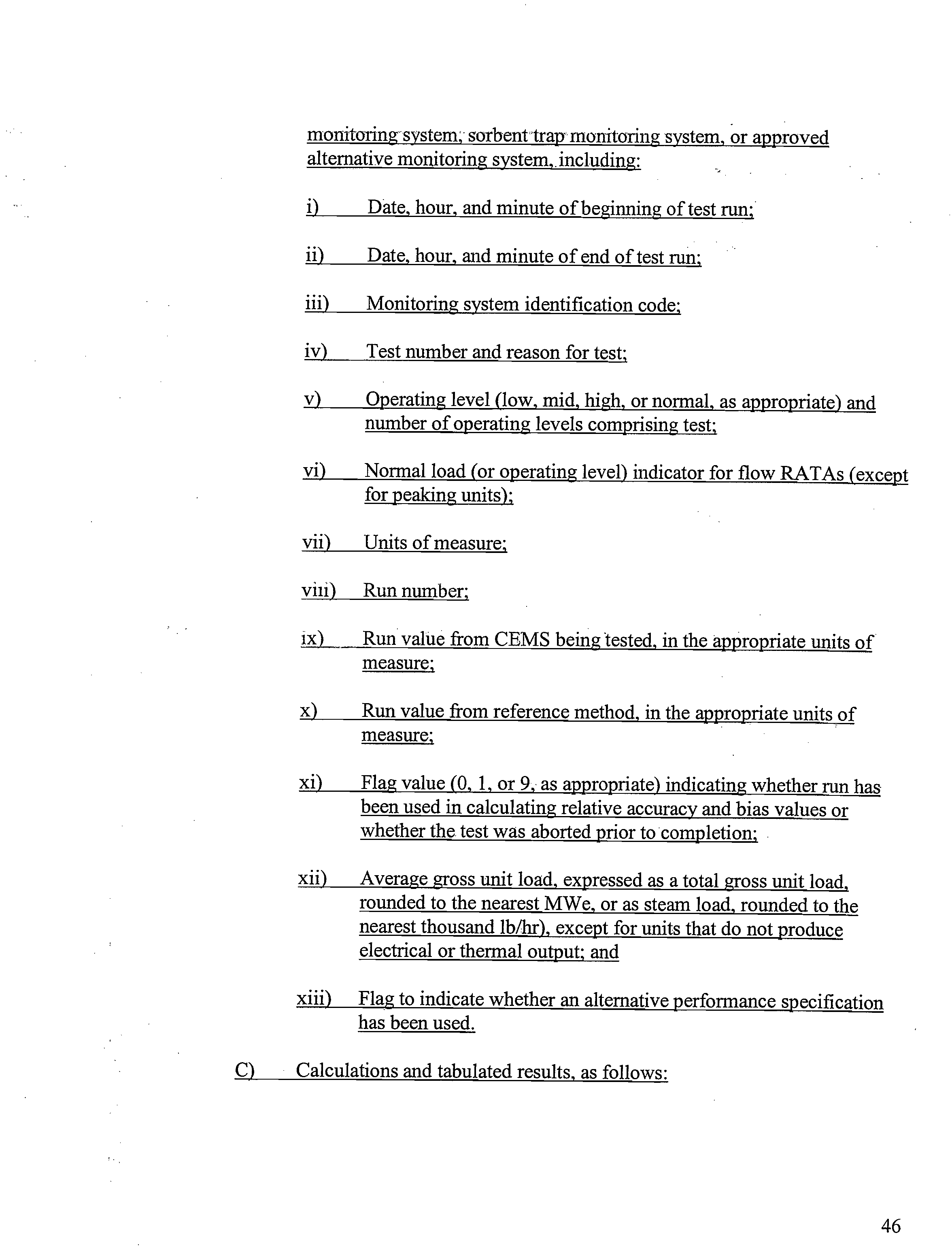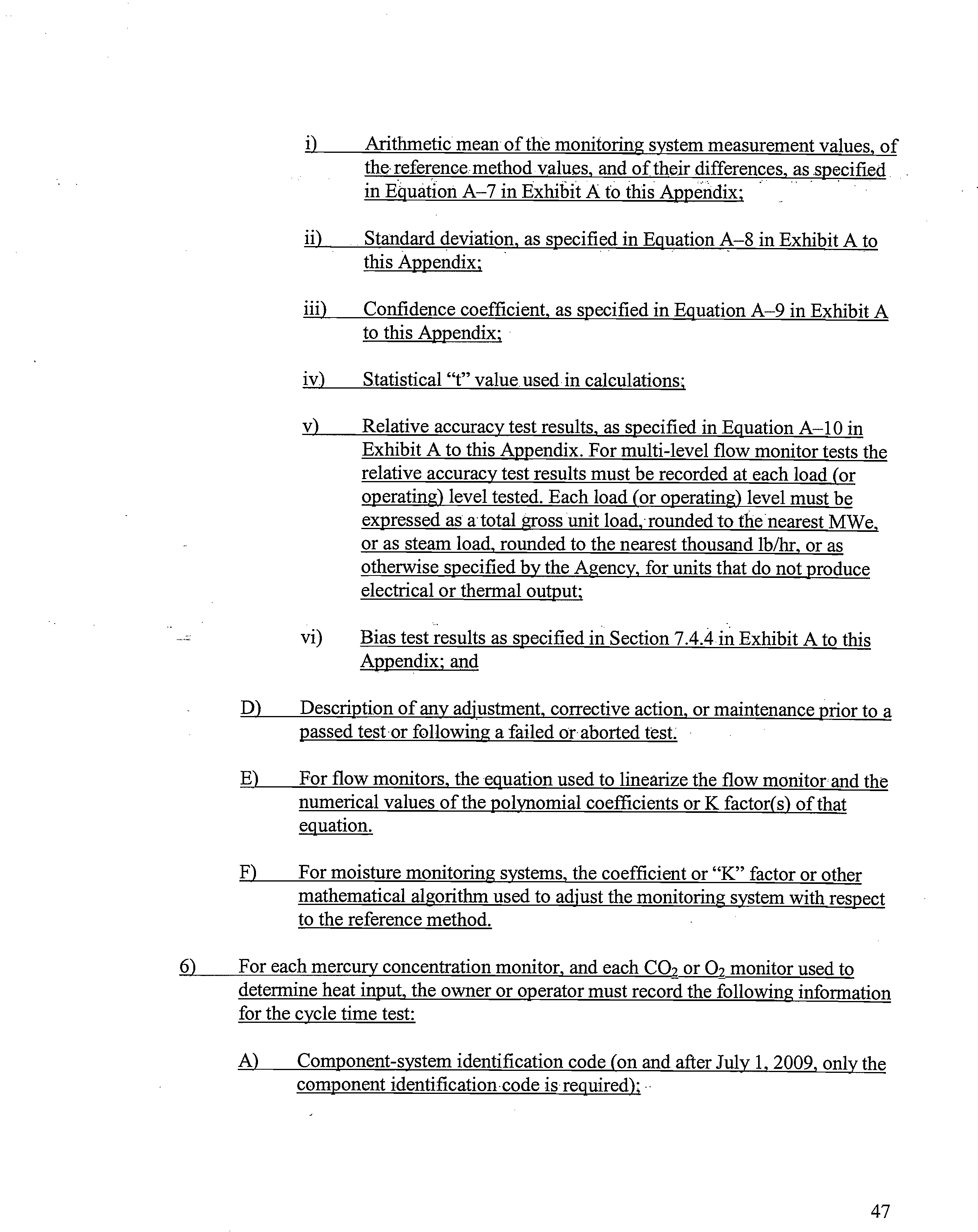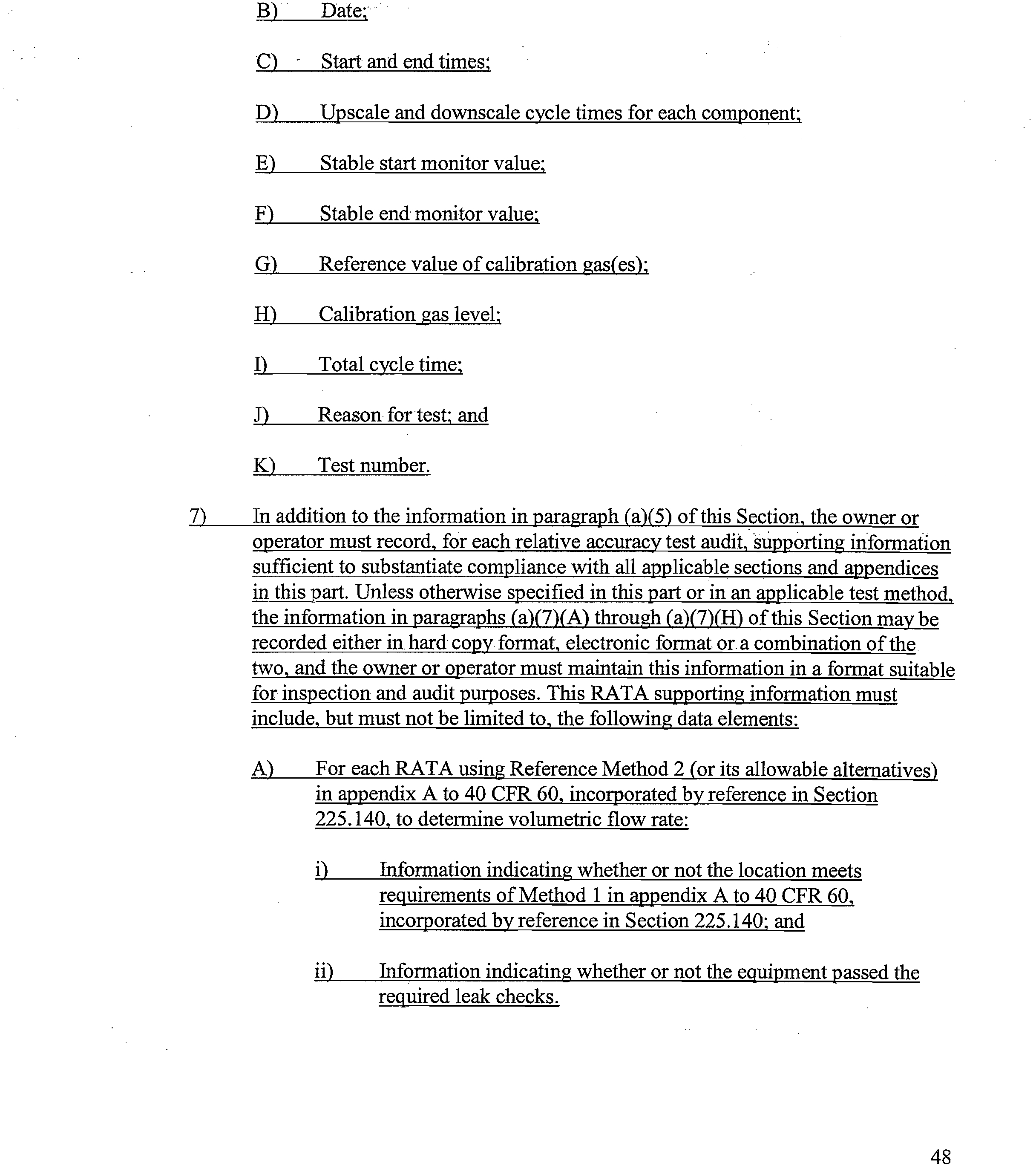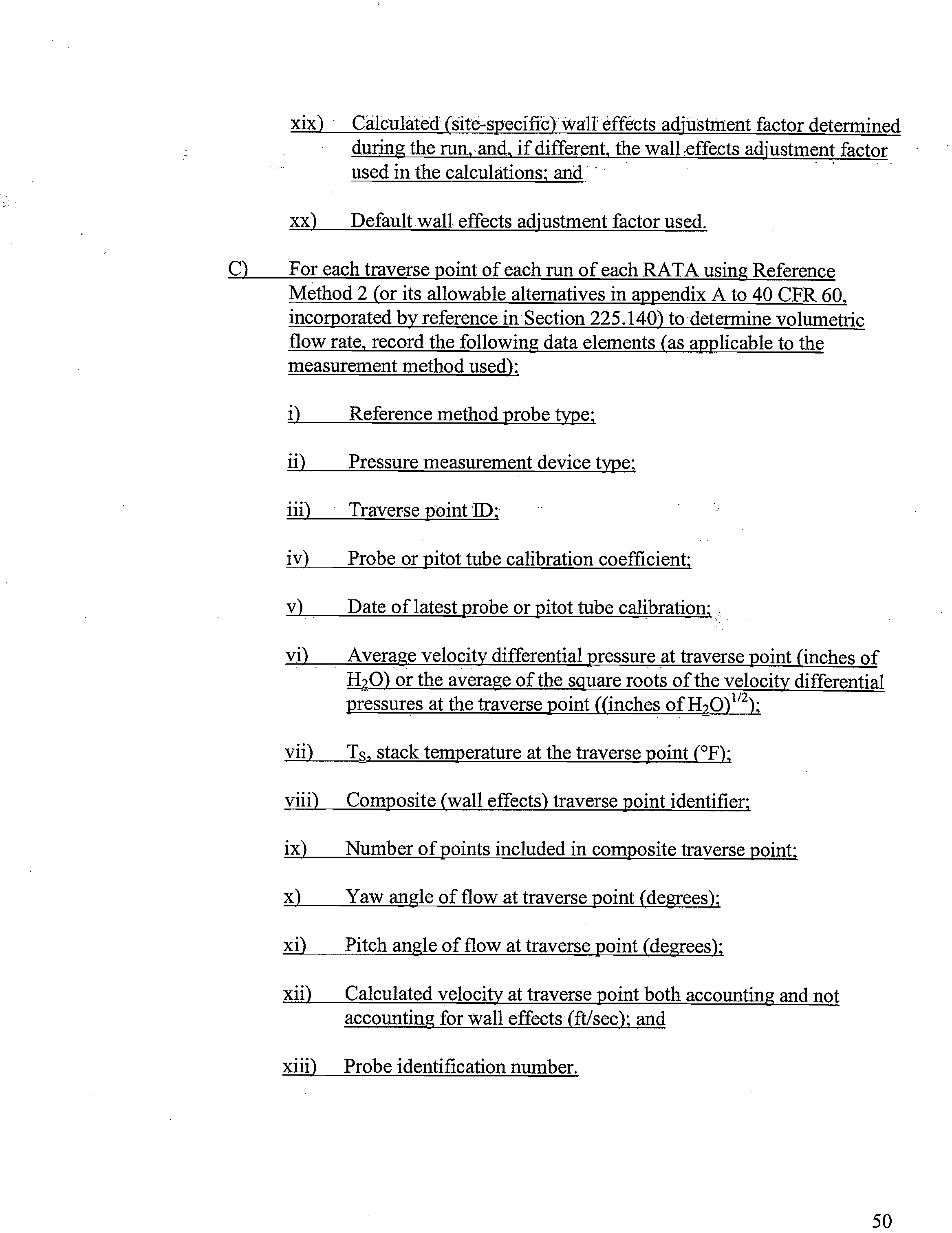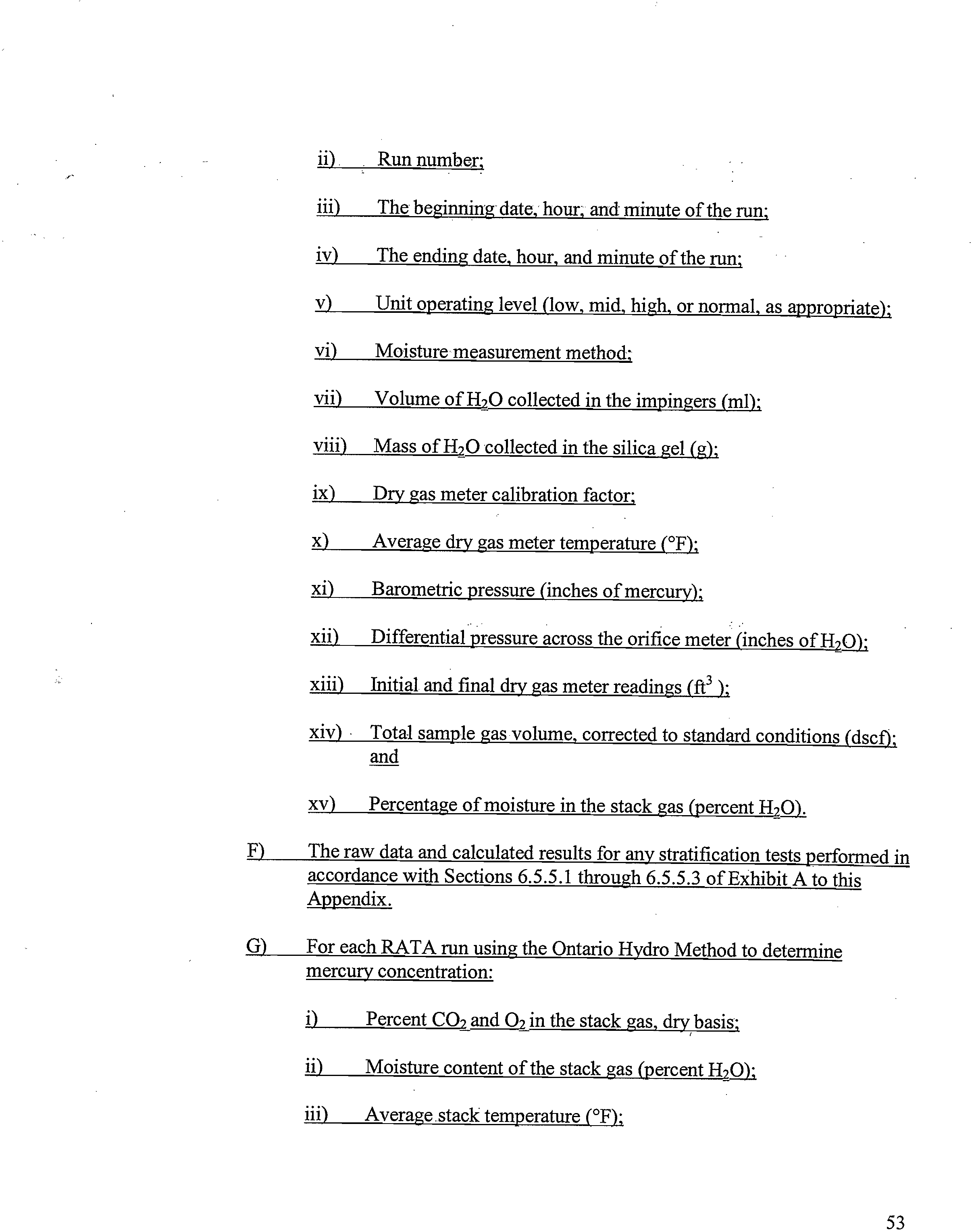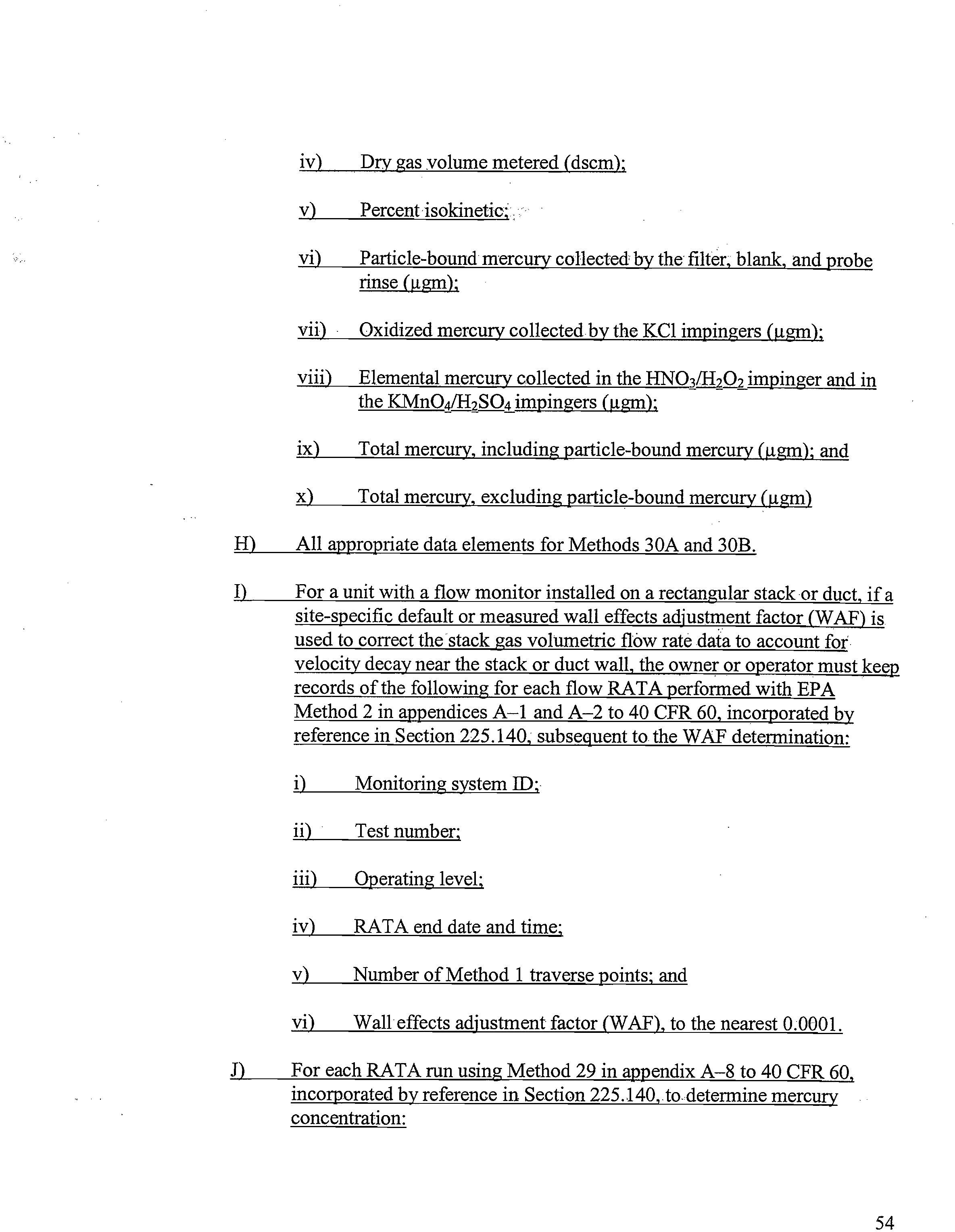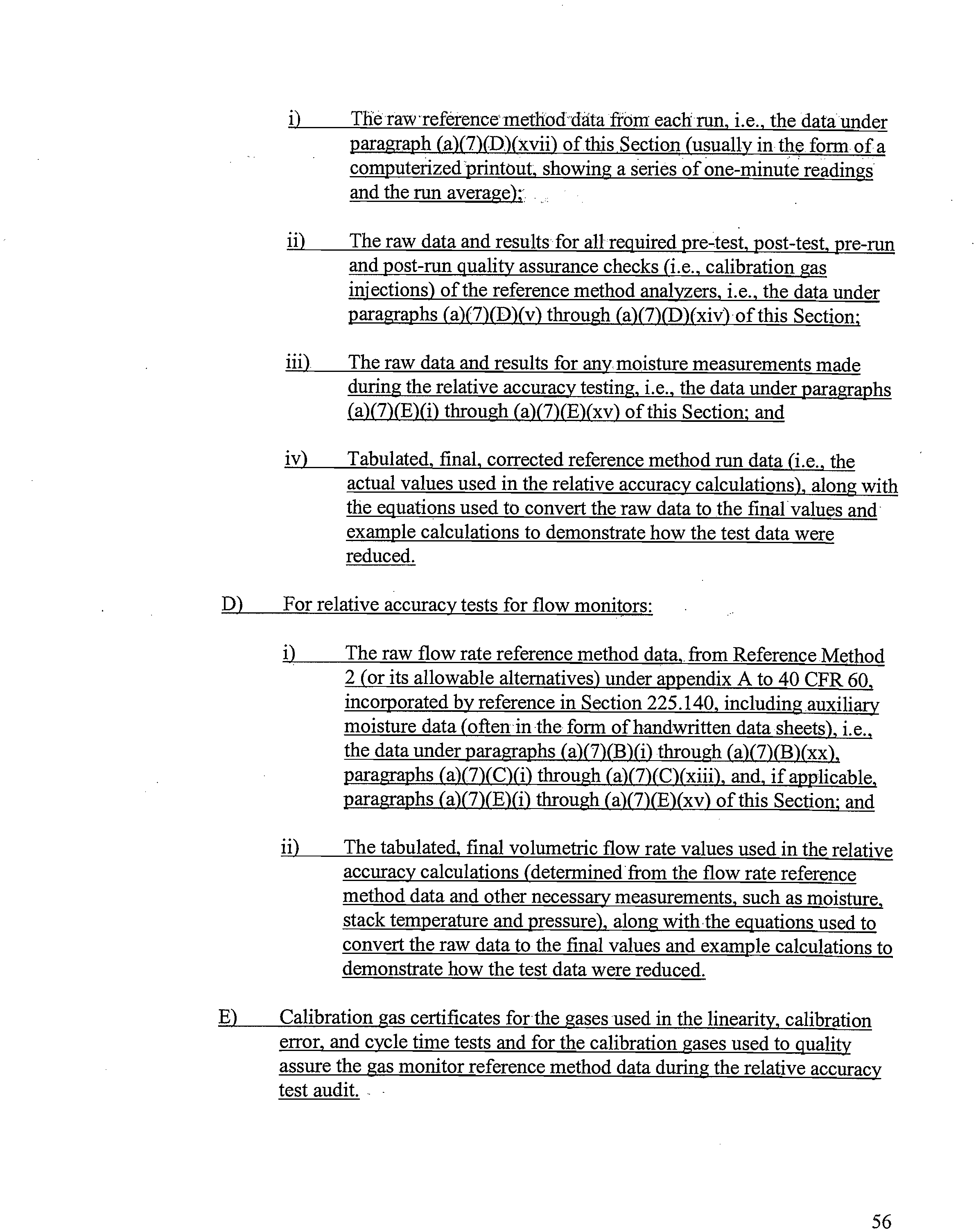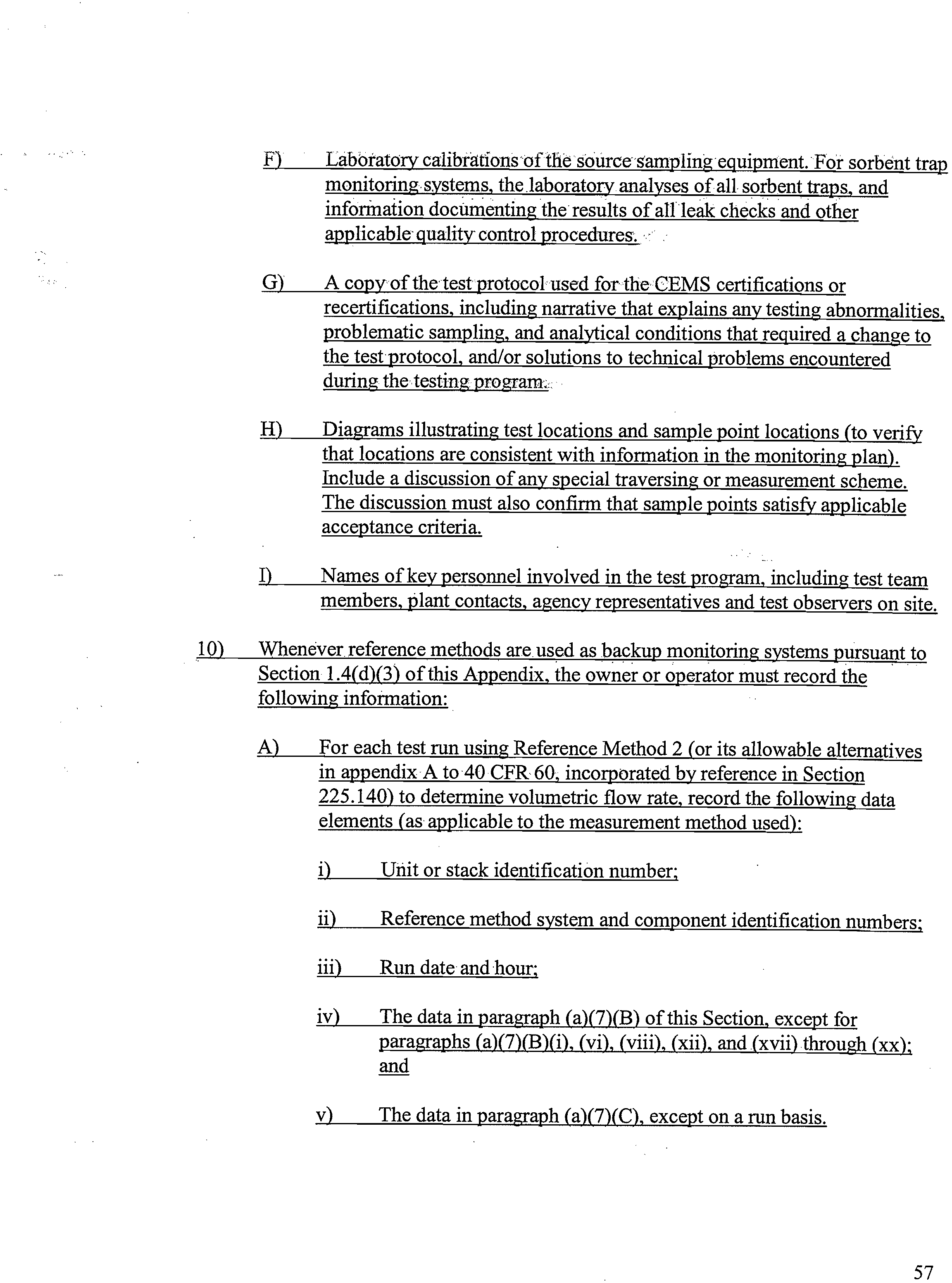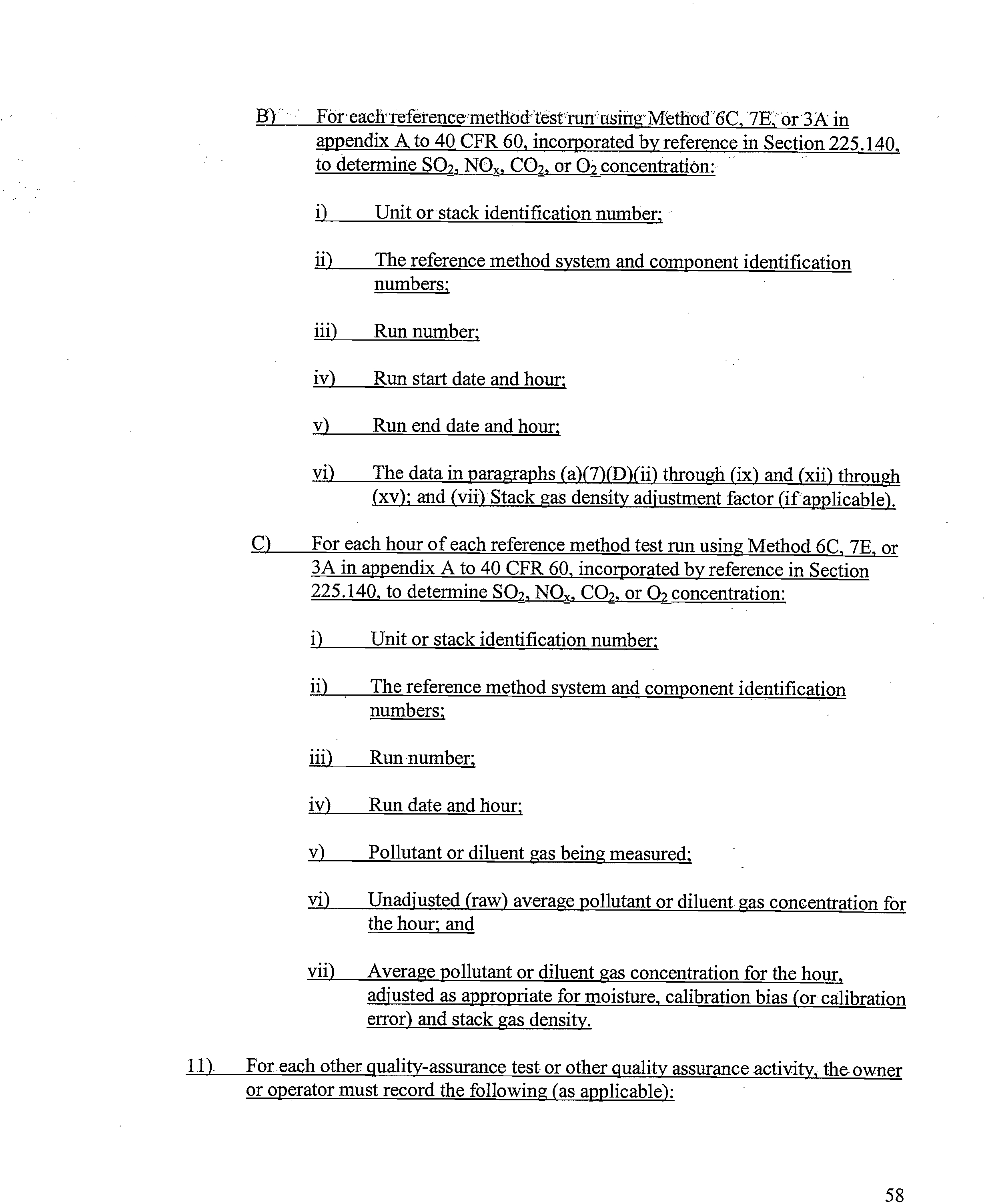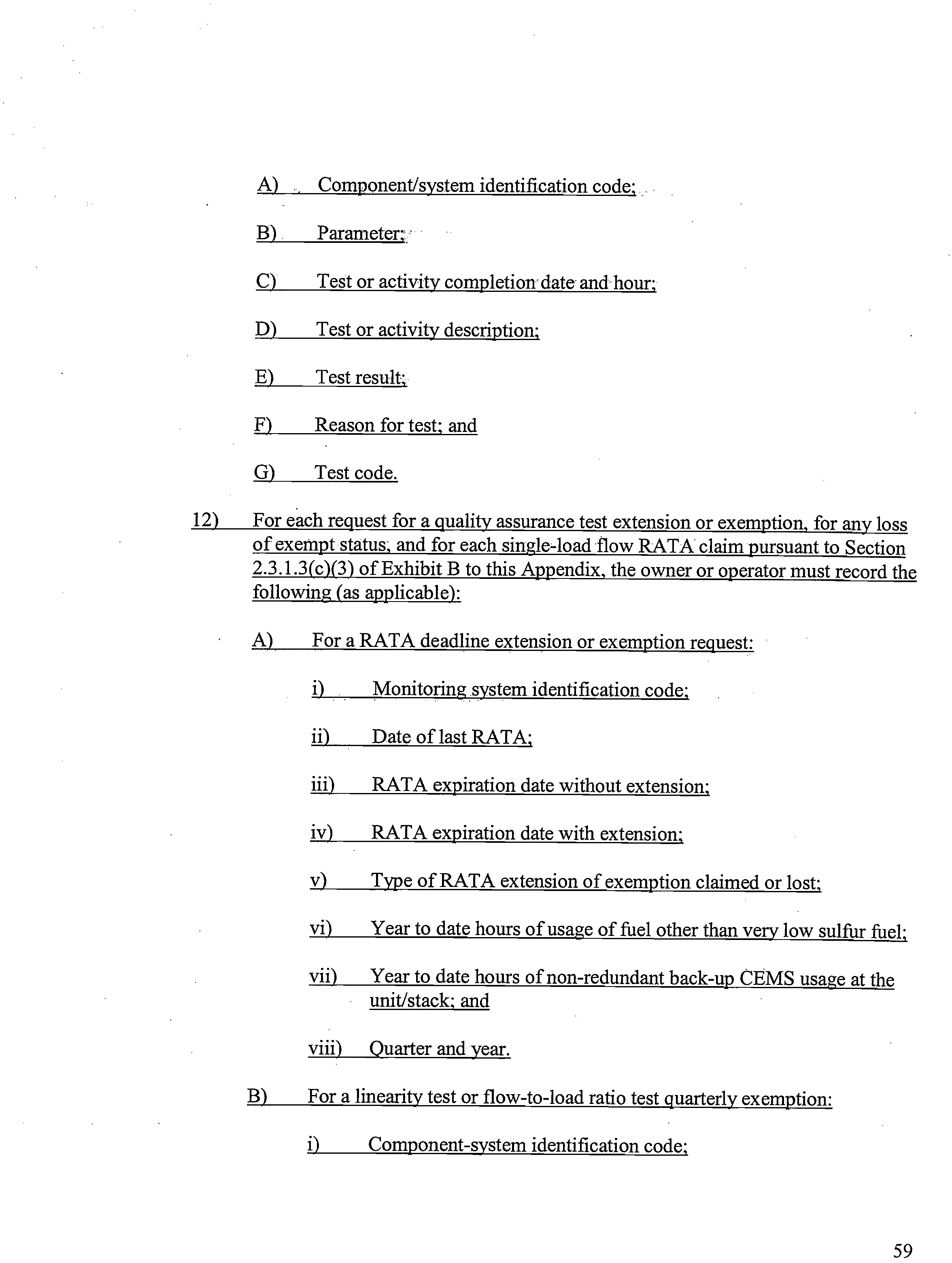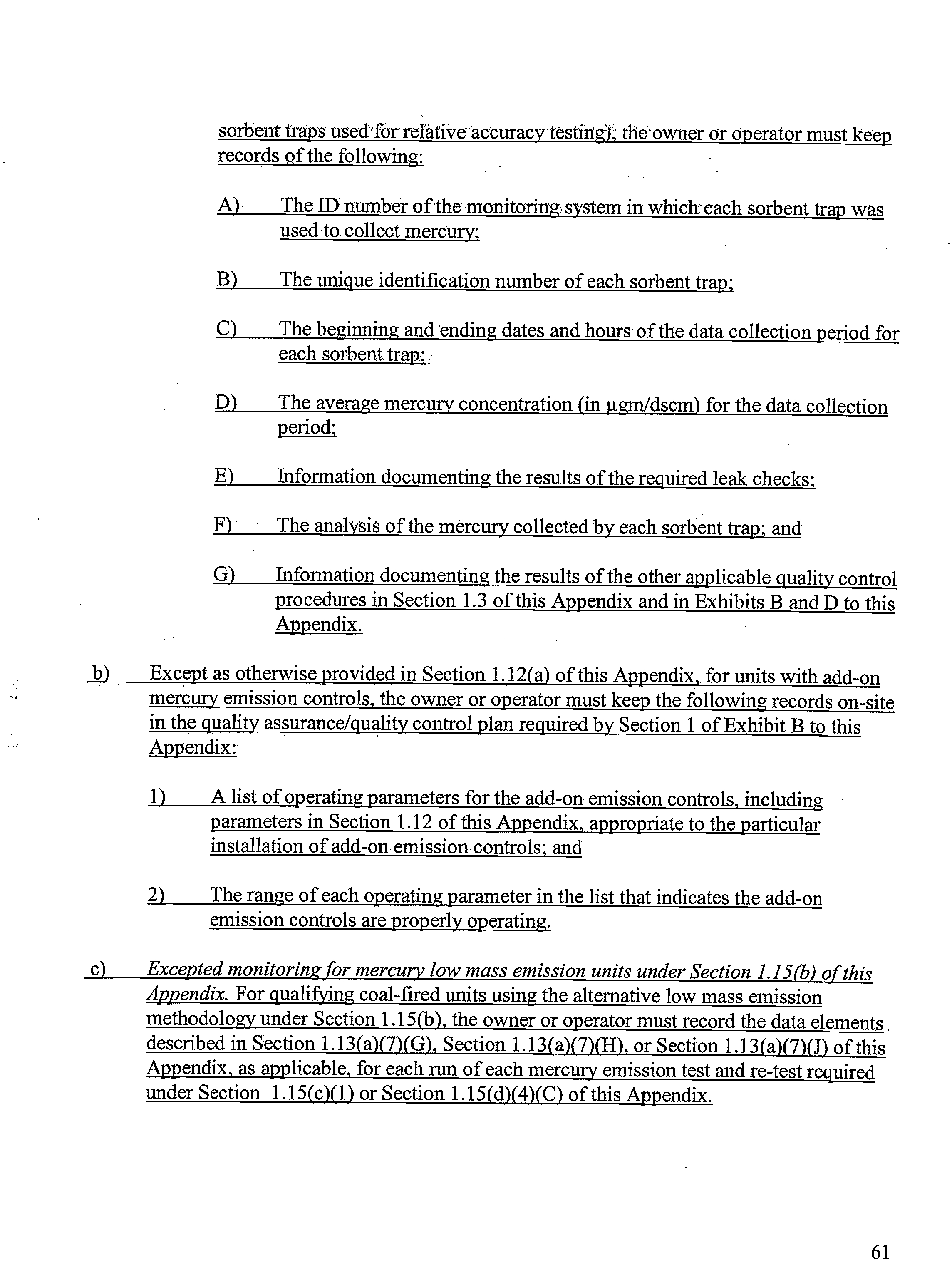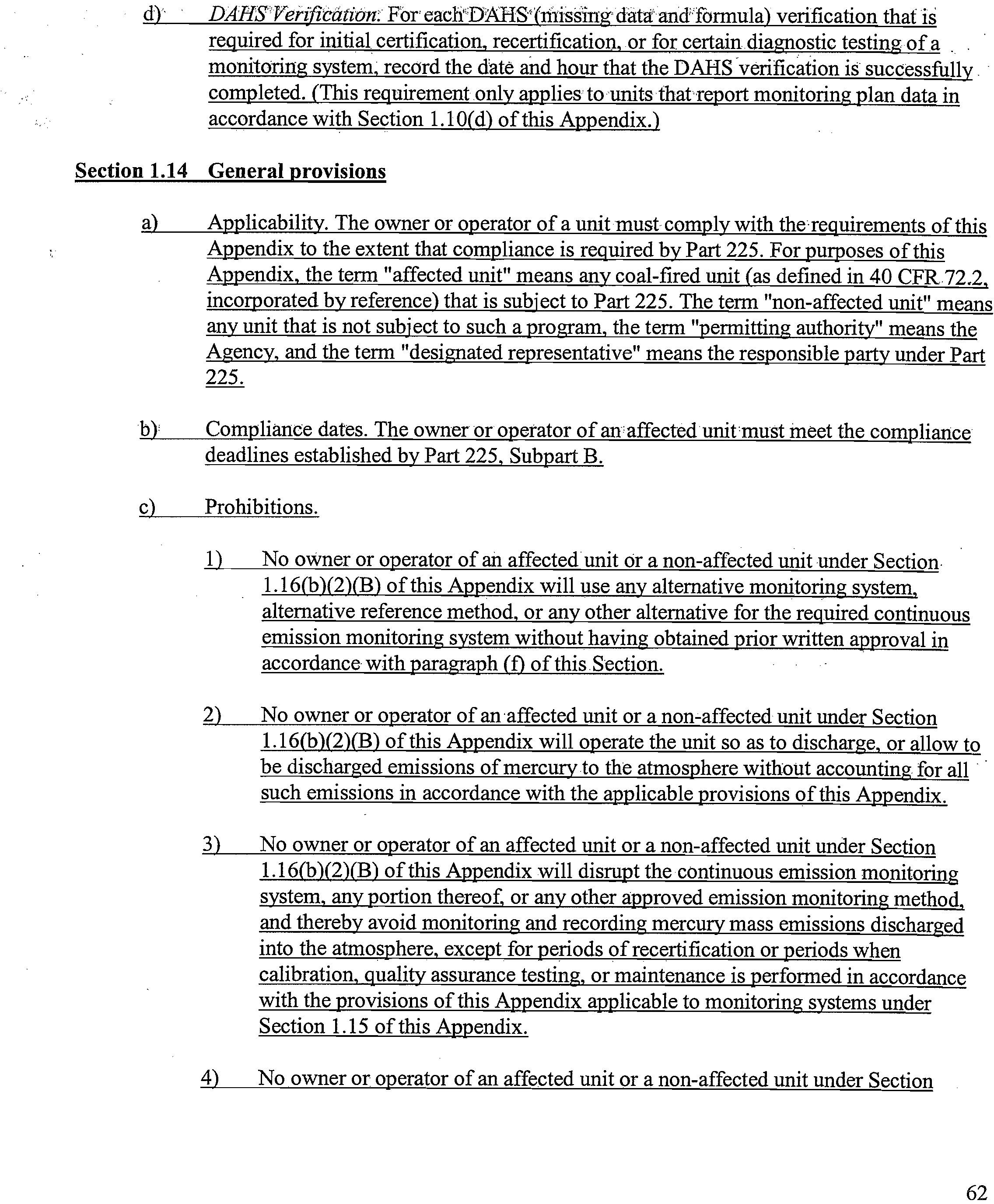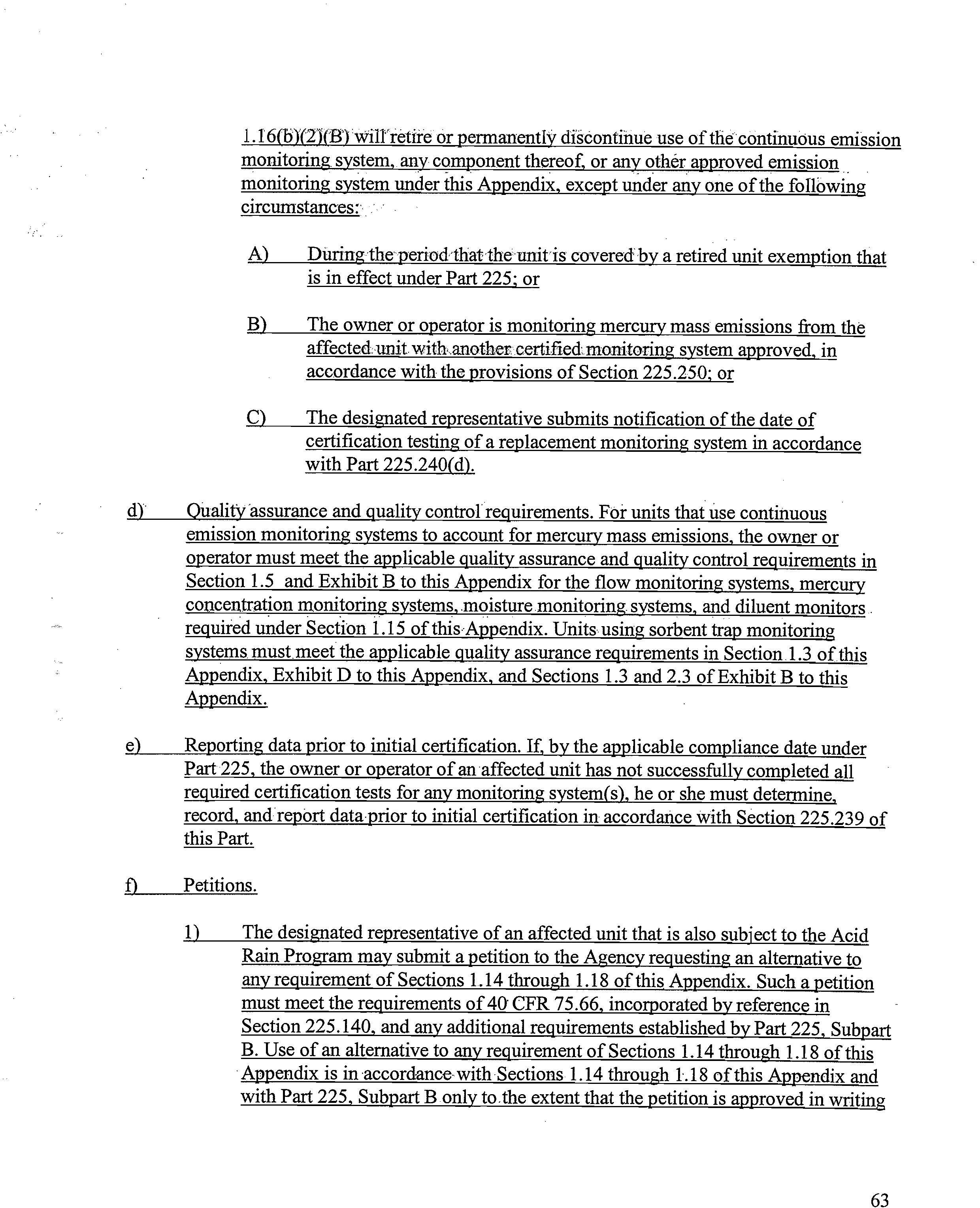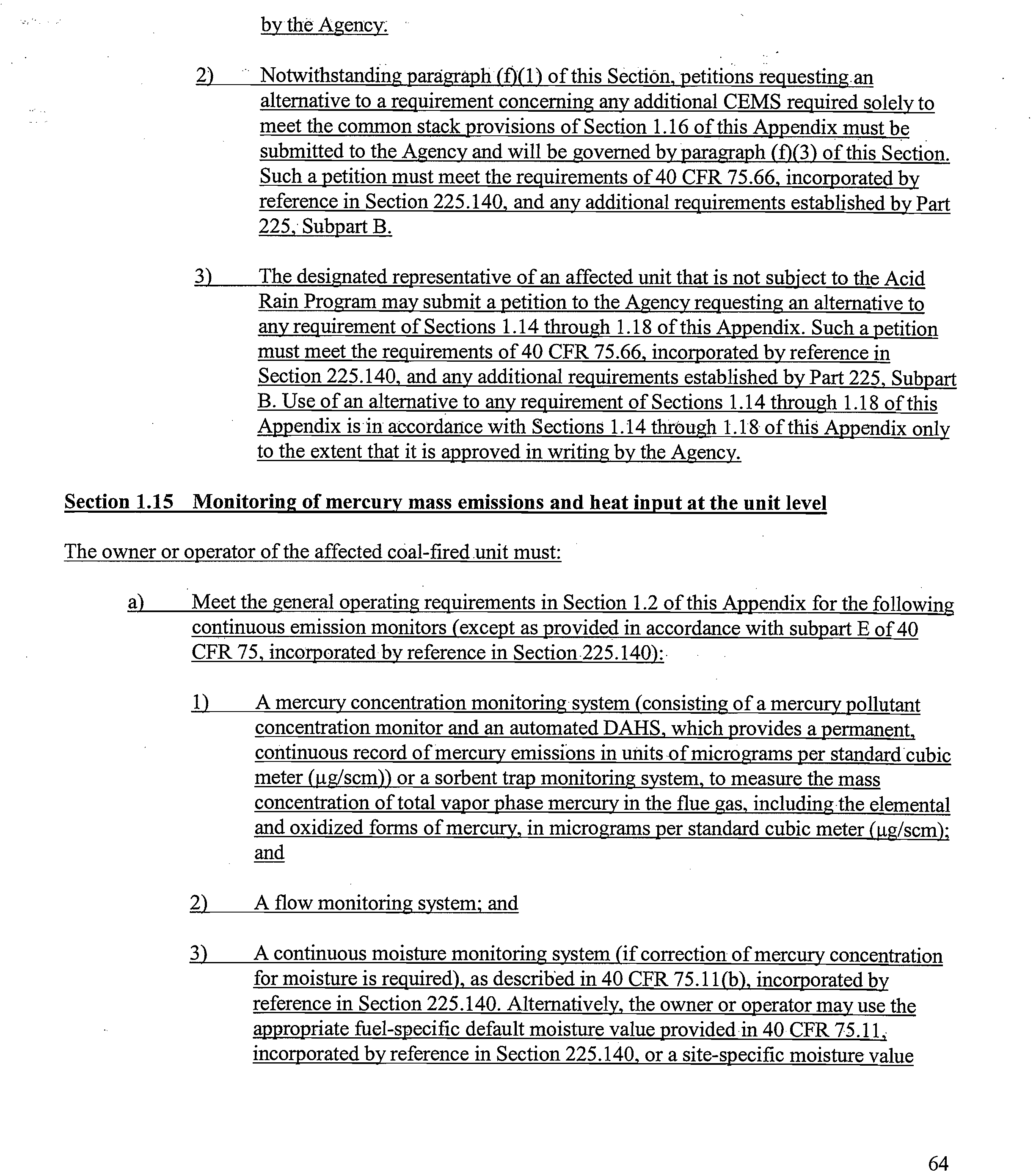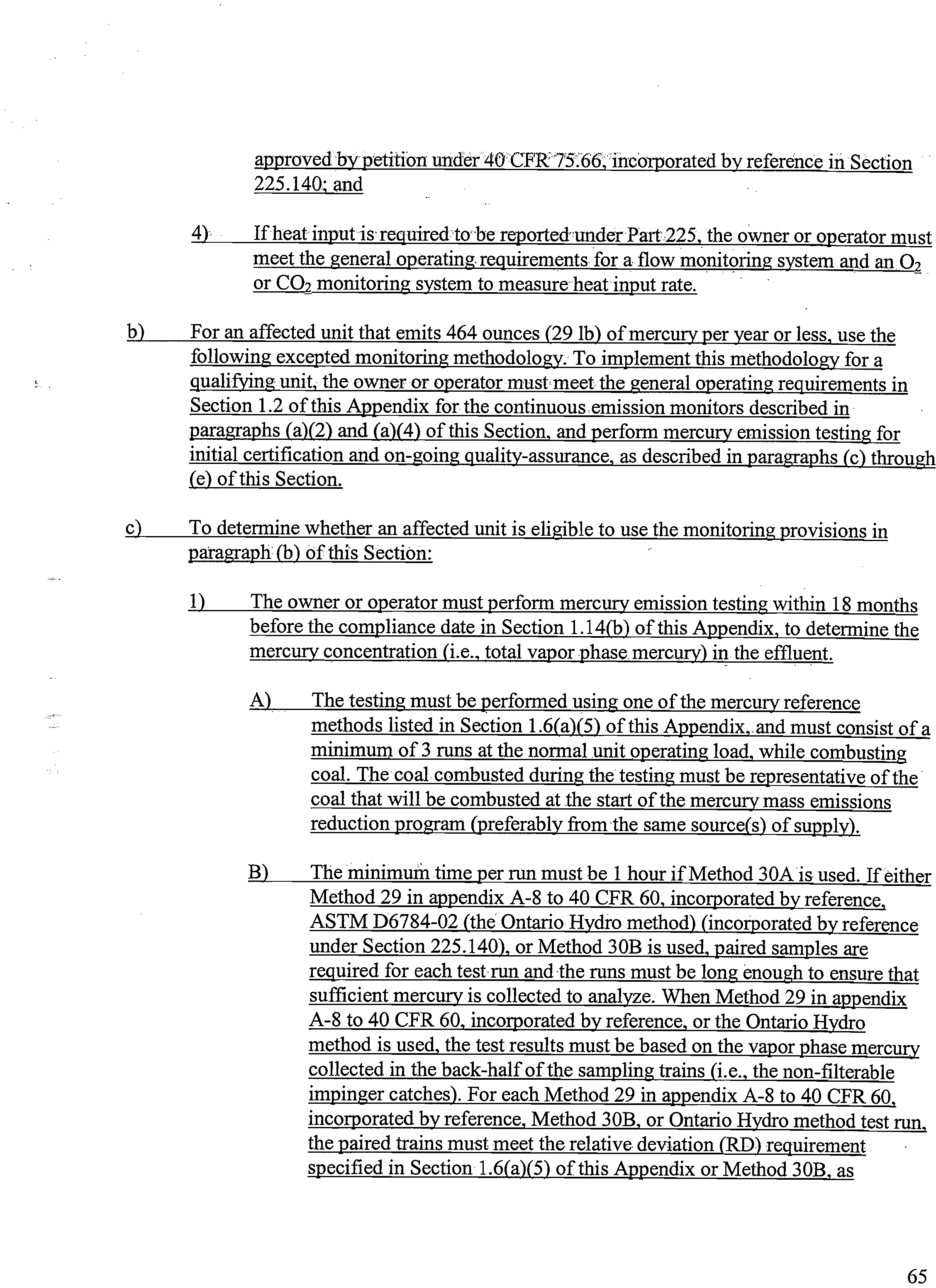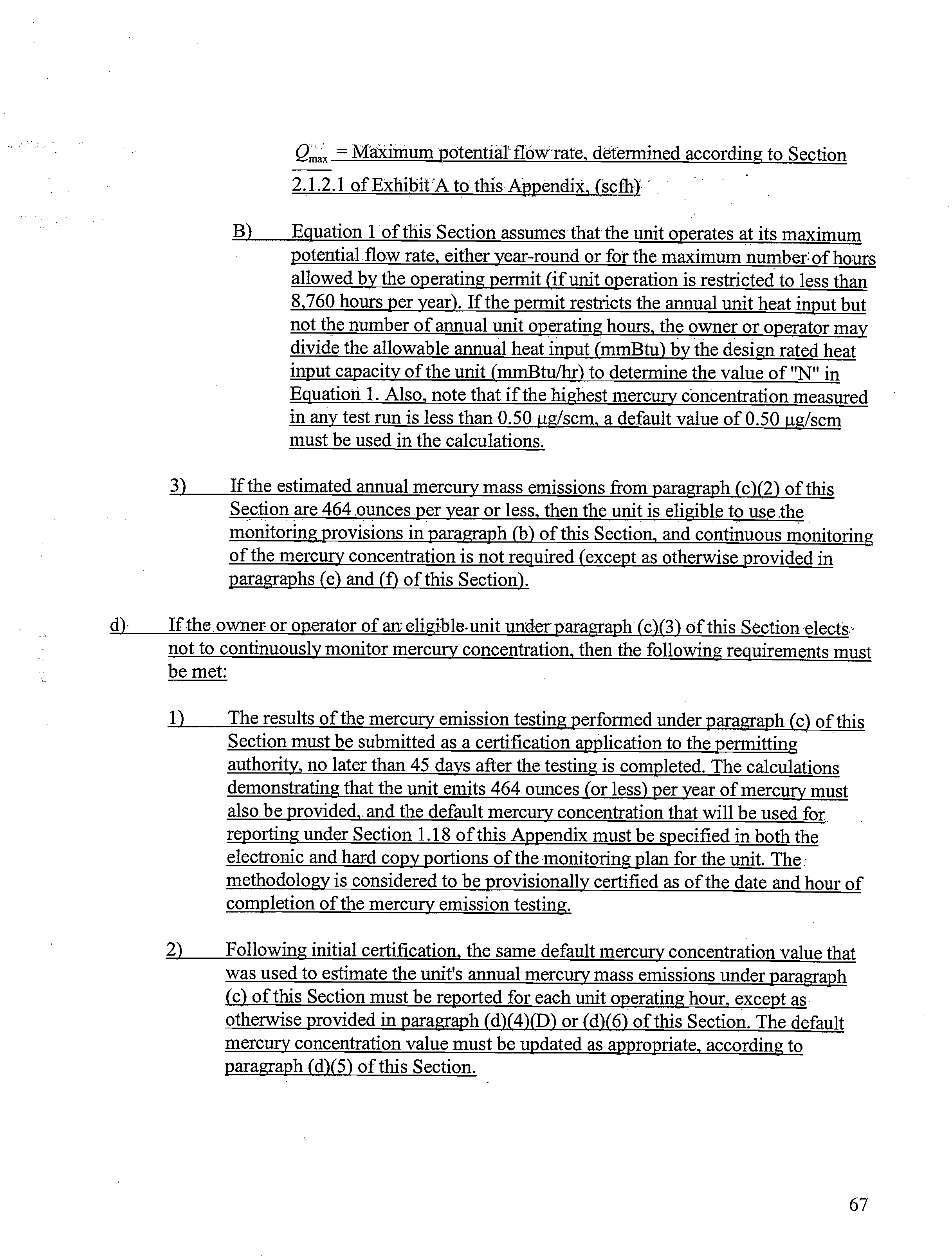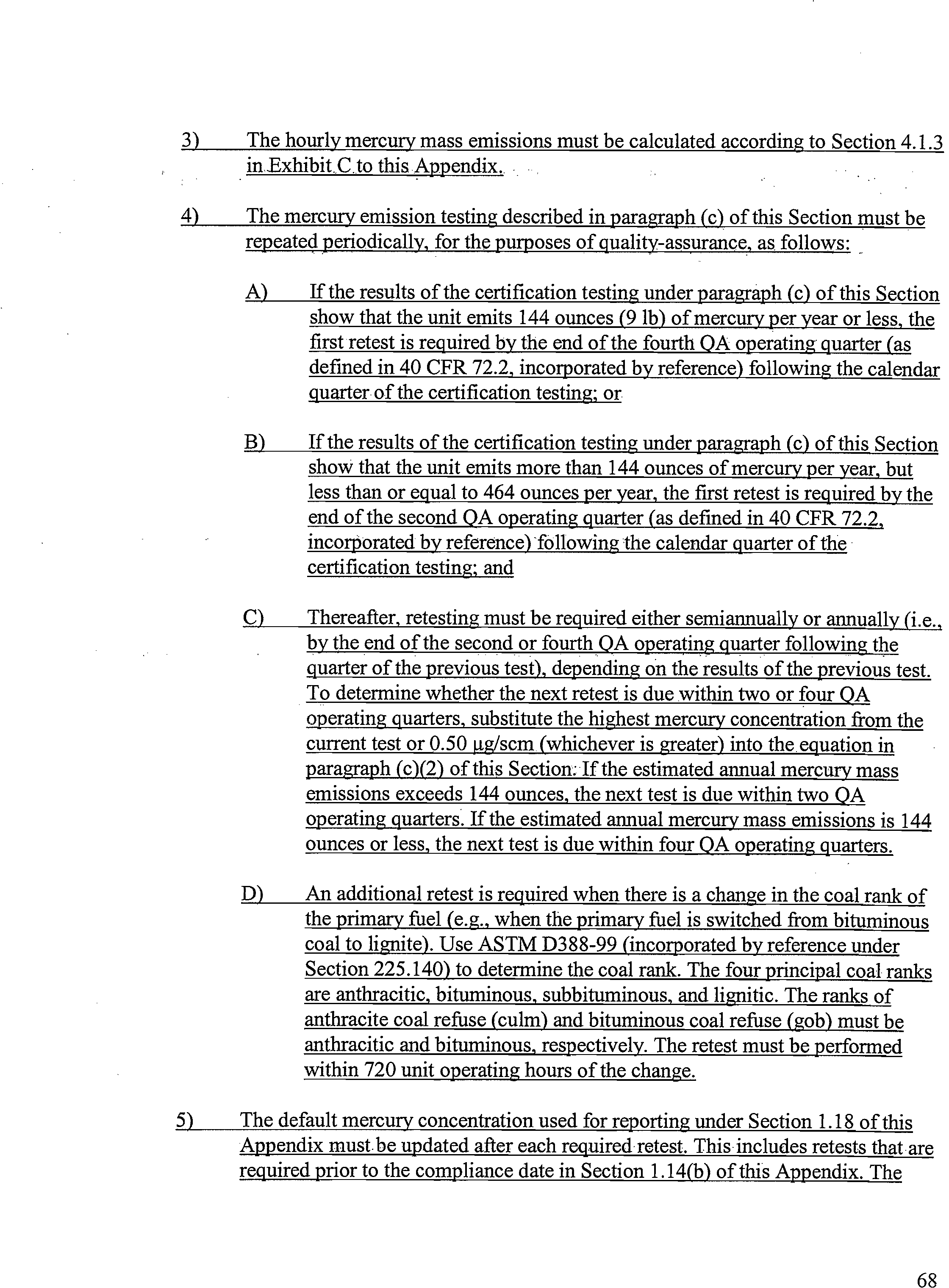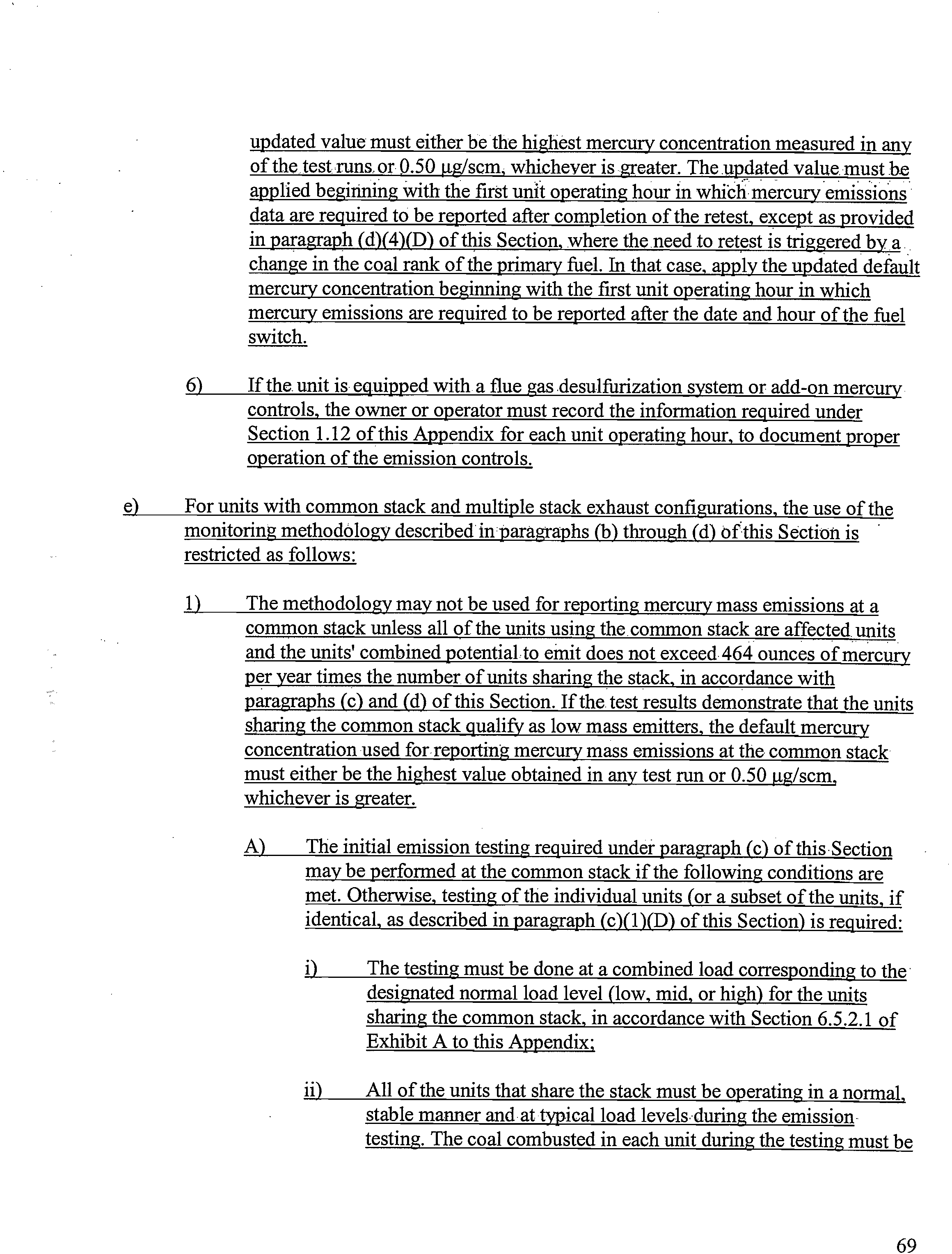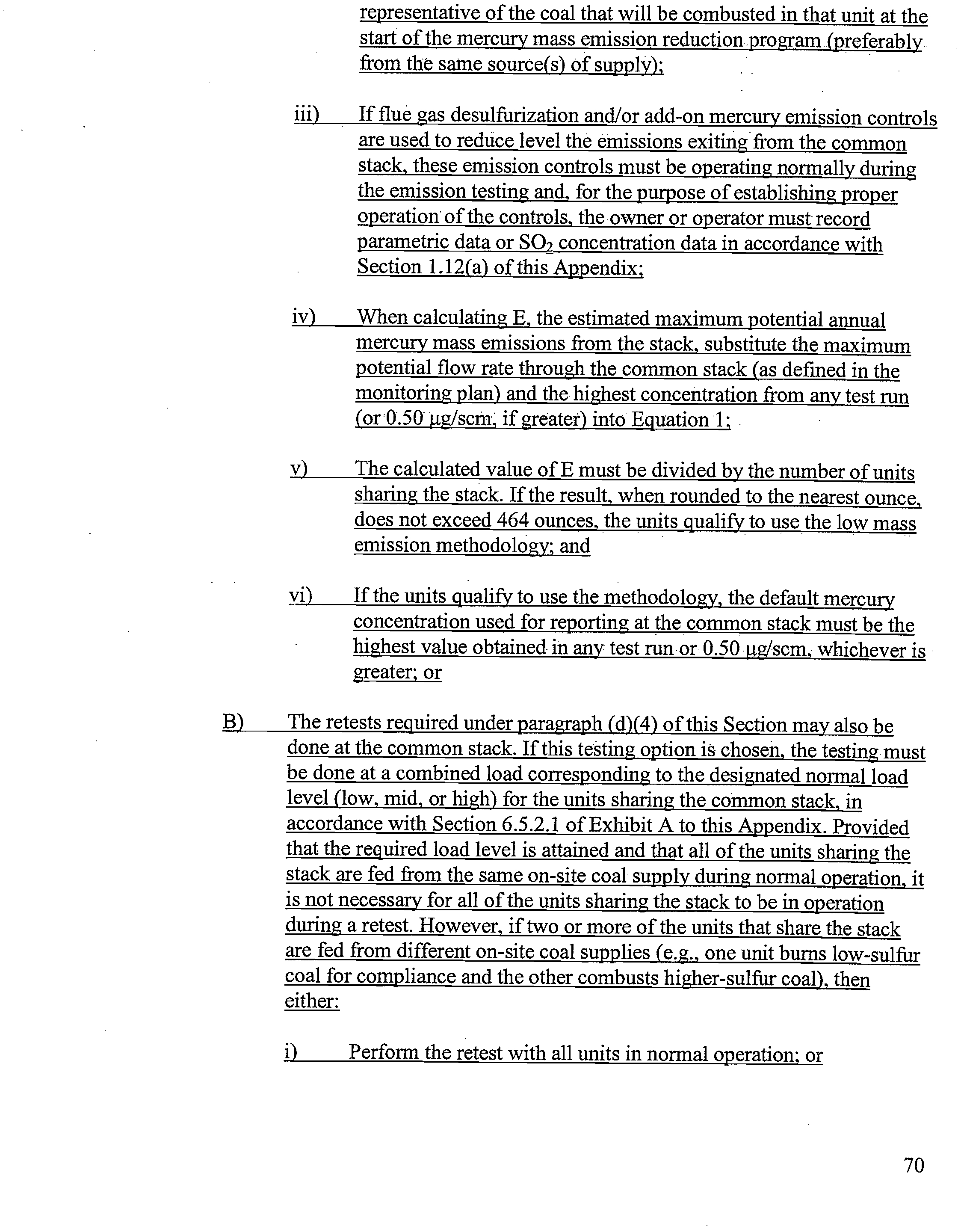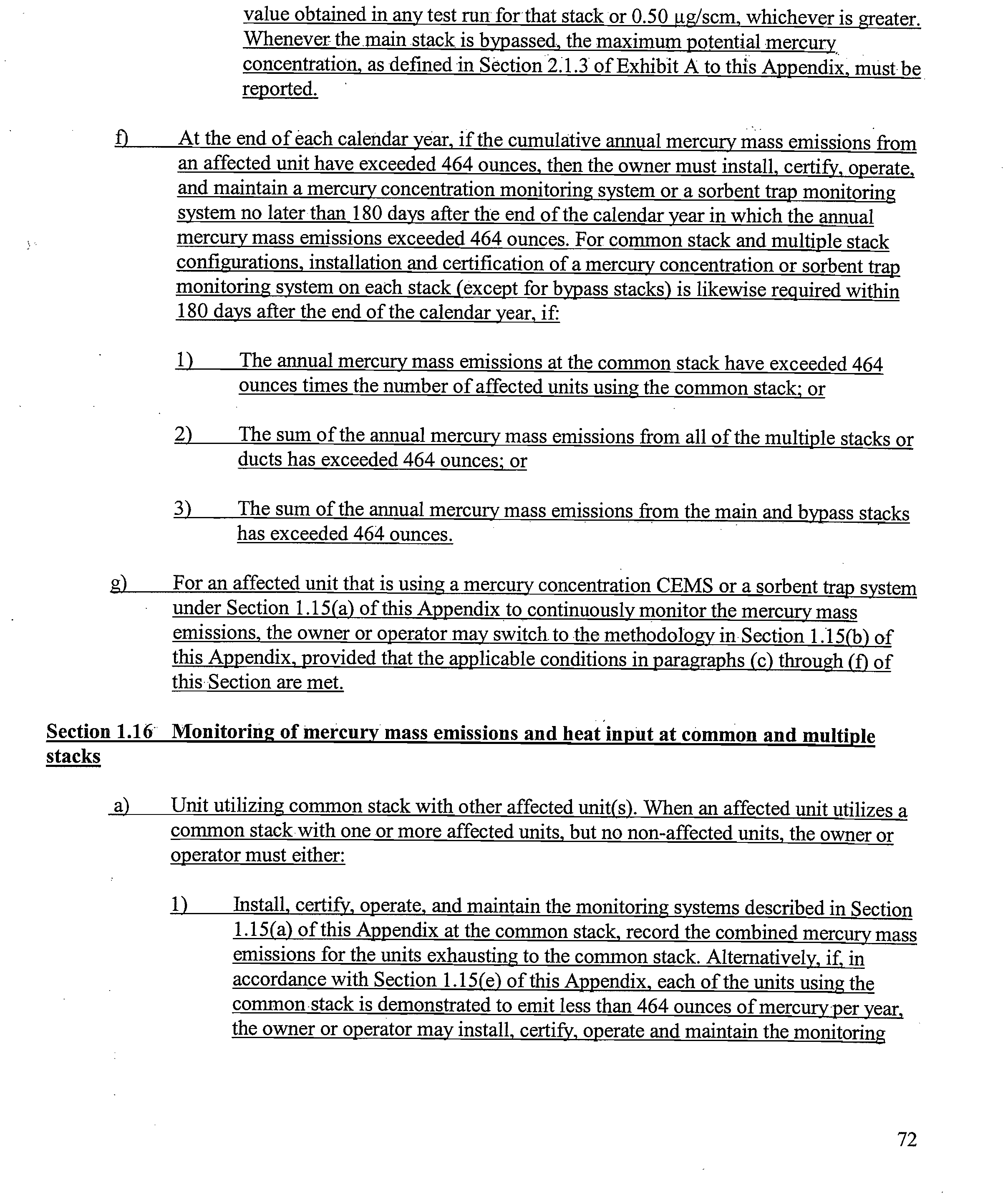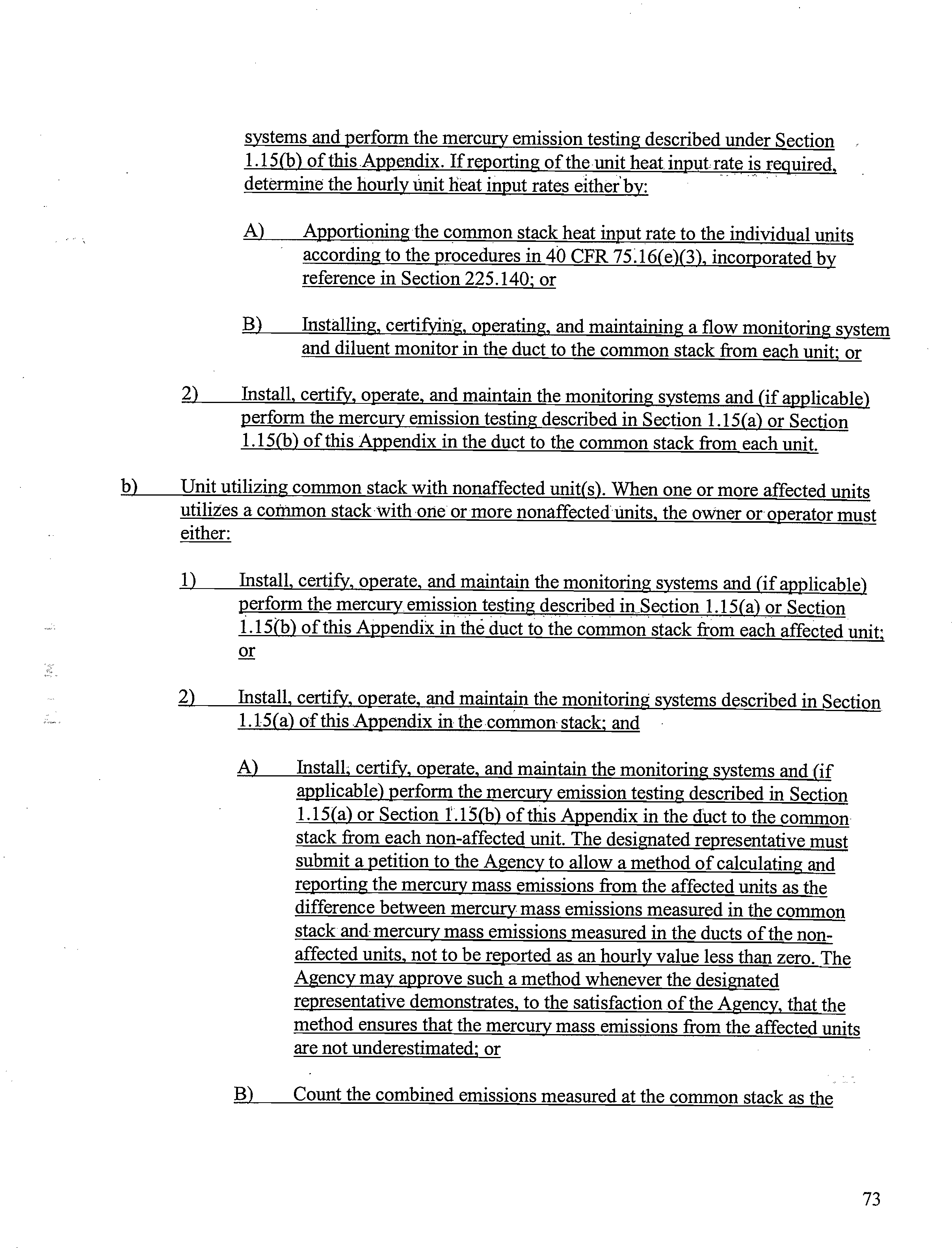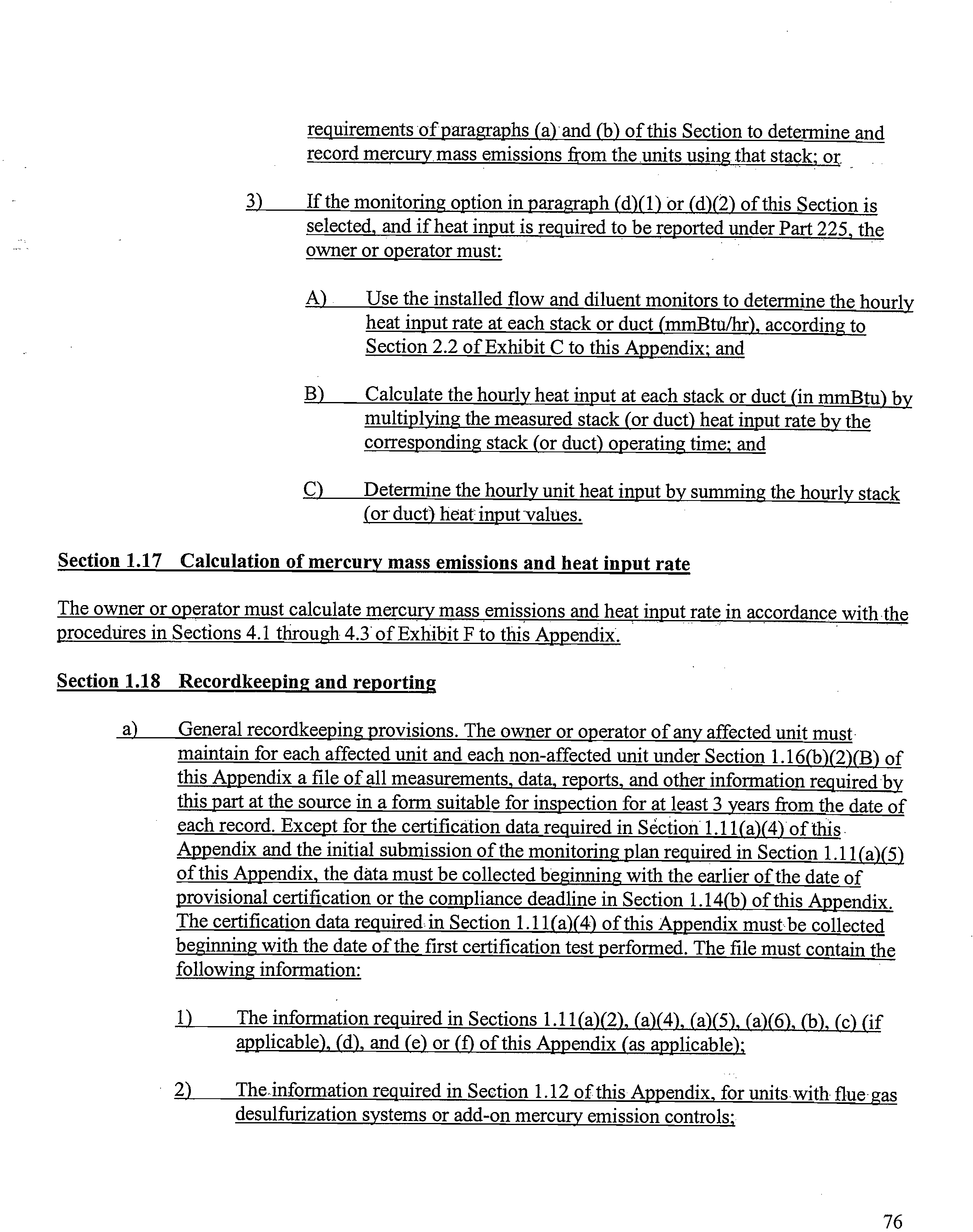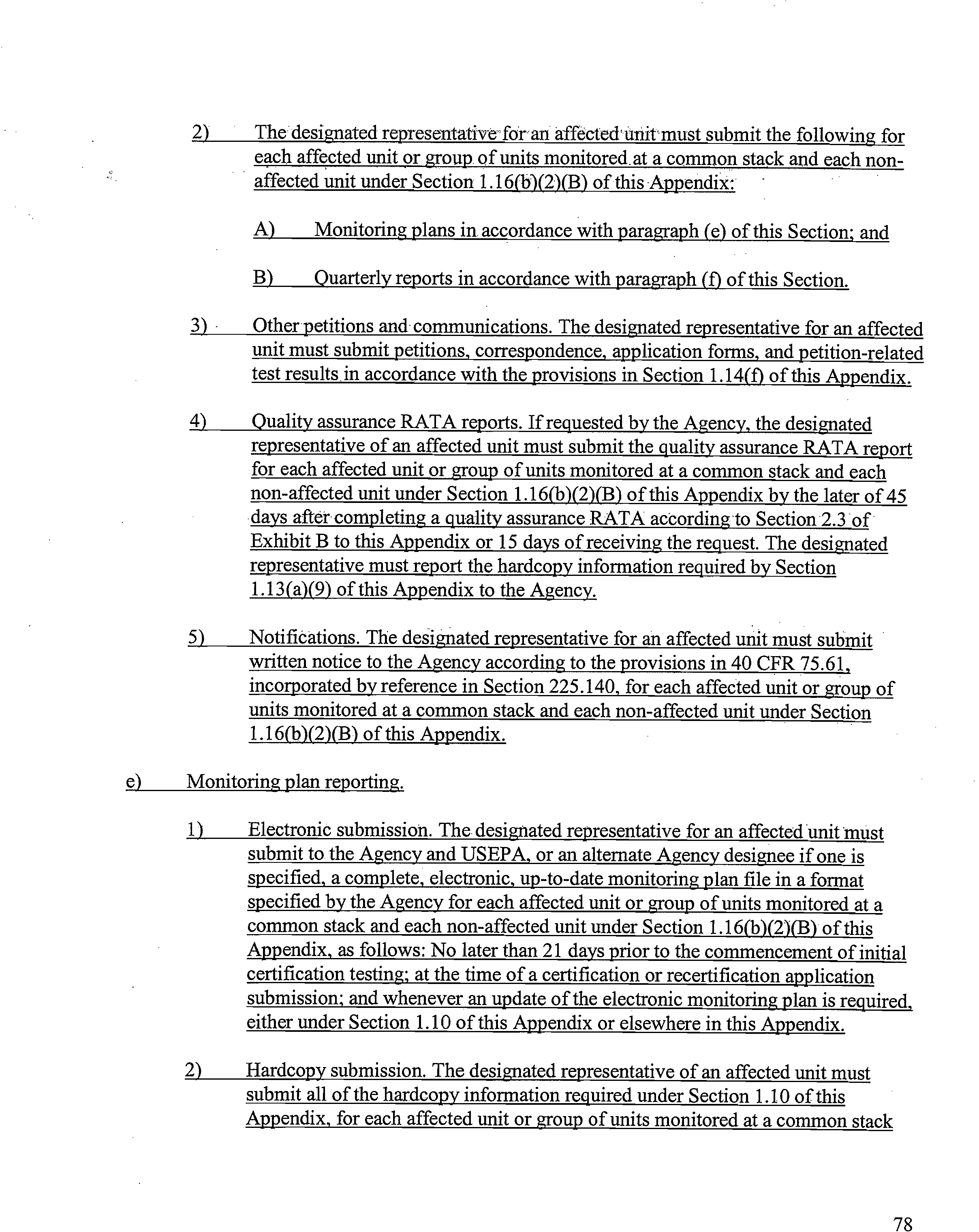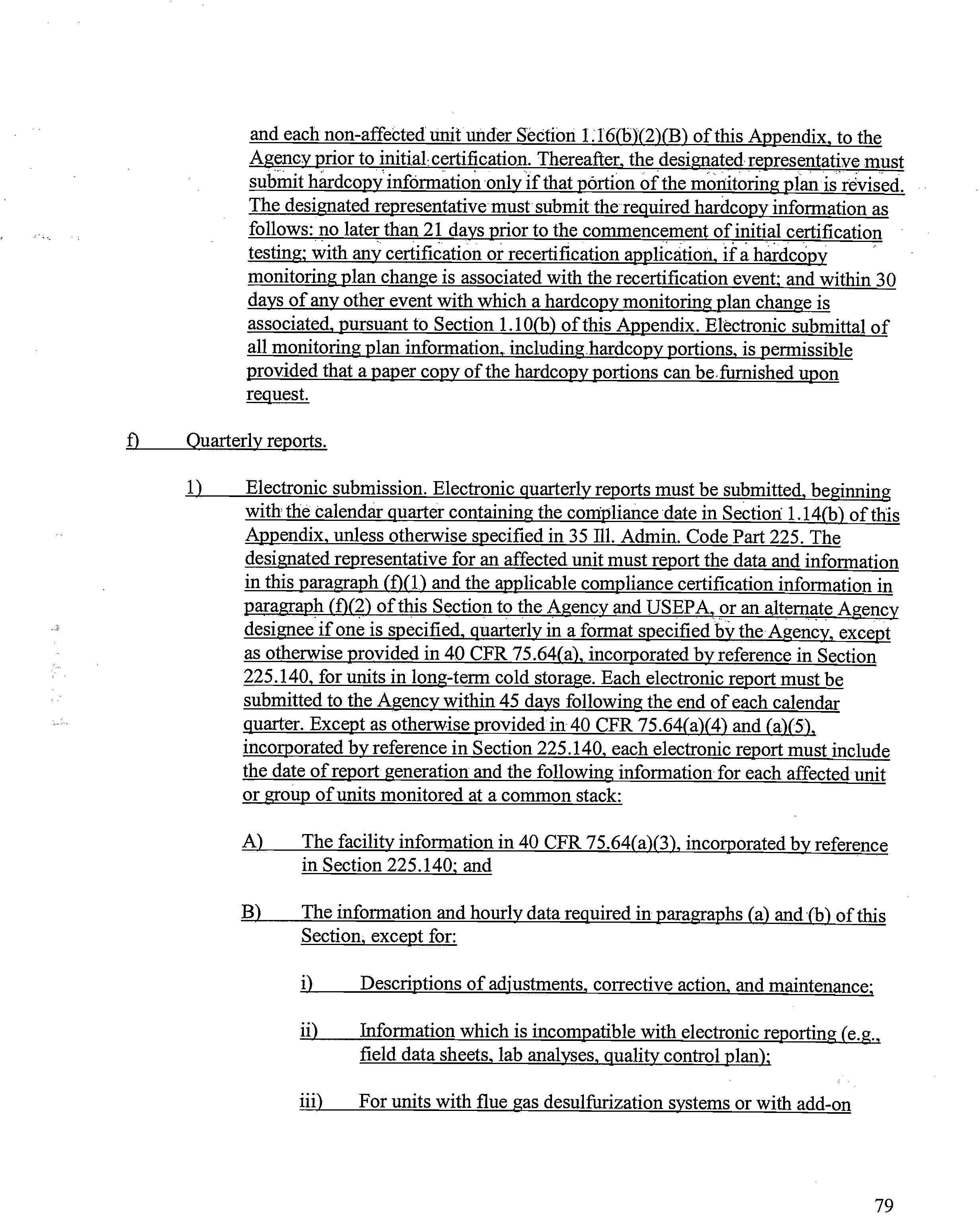225
.APPENDTX
B
Continuous
Emission
Monitoring
Systems
for
Mercury
Section
1.1
Applicability
The
provisions
of
this
Appendix
apply
to
sources
subject
to 35
III
Admin.
Code
Part
225
mercury
(Hg)
mass
emission
reduction
program.
Section
1.2
General
operating
requirements
a)
Primary
Equipment
Performance
Requirements.
The
owner
or
operator
must
ensure
that
each
continuous
mercury
emission
monitoring
system
required
by
this
Appendix
meets
the
equipment,
installation,
and
performance
specifications
in Exhibit
A to
this
Appendix
and
is maintained
according
to the
quality
assurance
and
quality
control
procedures
in
Exhibit
B
to this
Appendix.
b)
Heat
Input
Rate
Measurement
Requirement.
The
owner
or operator
must
determine
and
record
the heat
input
rate,
in
units
of
mmBtu!hr,
to
each
affected
unit
for
every
hour
or
part
of
an
hour
any
fuel
is combusted
following
the procedures
in
Exhibit
C
to
this
Appendix.
c)
Primary
equipment
hourly
operating
requirements.
The
owner
or
operator
must
ensure
that
all
continuous
mercury
emission
monitoring
systems
required
by
this
Appendix
are
in
operation
and
monitoring
unit
emissions.
at
all
times
that
the
affected
unit
combusts
any
fuel
except
during
periods
of calibration,
quality
assurance,
or preventive
maintenance,
performed
pursuant
to
Section
1.5
of
this
Appendix
and
Exhibit
B
to this
Appendix,
periods
of
repair,
periods ofbackups
of
data
from
the data
acquisition
and
handling
system,
or
recertification
performed
pursuant
to
Section
l.4.of
this
Appendix.
1)
The
owner
or
operator
must
ensure
that
each
continuous
emission
monitoring
system
is
capable
of
completing
a minimum
of
one
cycle
of operation
(sampling,
analyzing,
and
data
recording)
for
each
successive
15-minute
interval.
The
owner
or
operator
must
reduce
all
volumetric
flow,
CO
2
concentration,
02
concentration,
and
mercury
concentration
data
collected
by
the
monitors
to
hourly
averages.
Hourly averages
must
be
computed
using
at
least
one
data
point
in
each
fifteen
minute
quadrant
of an
hour,
where
the
unit
combusted
fuel
during
that
quadrant
of
an
hour.
Notwithstanding
this
requirement,
an
hourly
average
may
be
computed
from
at
least
two
data
points
separated
by
a minimum
of
15
minutes
(where
the
unit
operates
for
more
than
one
quadrant
of
an
hour)
if
data
are
unavailable
as
a
result
of
the
performance
of
calibration,
quality
assurance,
or
preventive
1
maintenance;activities’pursuantto
Sectiôn’L5of
this
Appendix
and
Exhibit
B
to
this
Appendix,
or
backups
of
data
from the
data
acquisition
and
handling
system,
or
recertification,
pursuantto
Section 1.4
to
thisAppendix
The
owner
or
operator
must
use
all
valid
measurements
or
data
points
collected
during an
hour
to
calculate
the
hourly
averages.
All
data
points
collected
during an
hour
must
be,
to
the
extent
practicable,
evenly
spaced
over the
hour.
2)
Failure
of a
CO
2
oLQ2
emissions
concentration
monitor,
mercury
concentration
monitor,
flow
monitor,
or
a
moisture
monitor
to
acquire
the
minimum
number
of
data
points
for
calculation
of
an
hourly
average
in paragraph
(c)(
1)
of
this
Section
must
result
in the
failure
to
obtain
a
valid
hour
of
data
and
the
loss
of
such
component
data for
the
entire
hour.
For
a
moisture
monitoring
system
consisting
of
one
or
more
oxygen
analyzers
capable
of
measuringQ
2
on
a
wet-basis
and
a
dry-basis,
an
hourly
average
percent
moisture
value
is
valid
only
if
the
minimum
number
of
data
points
is acquired
for
both
the
wet-and
dry-basis
measurements.
d)
Optional
backup
monitor
requirements.
If
the
owner
or
orator
chooses
to
use
two
or
more
continuous
mercury
emission
monitoring
systems,
each
of
which
is
capable
of
monitoring
the
same
stack or
duct
at
a
specific
affected
unit,
or
group
of
units
using
a
common
stack,
then
the
owner
or
operator
must
designate
one
monitoring
system
as
the
primary
monitoring
system,
and
must
record
this
information
in
the
monitoring
plan, as
provided
for
in
Section
1.10
of
this
Appendix.
The
owner
or
operator must
designate
the
other
monitoring
system(s)
as
backup
monitoring
system(s)
in
the
monitoring
plan.
The
bàcku
monitoring
system(s)
must
be
designated
as
redundant
backup monitoring
system(s),
non-redundant
backup
monitoring
system(s),
or
reference method
backup
system(s),
as
described
in
Section
1.4(d)
of
this
Appendix.
When
the
certified
primary
monitoring
system
is
operating
and
not
out-of-control
as
defined
in
Section
1.7
of
this
Appendix,
only
data
from
the
certified primary
monitoring
system
must
be
reported
as
valid,
quality-assured
data.
Thus,
data
from
the
backup
monitoring
system
may
be
reported
as
valid,
quality-assured
data
only
when
the
backup
is
operating
and
not
out-of-
control
as
defined in
Section
1.7
of
this
Appendix
(or
in the
applicable
reference
method
in
appendix
A
of 40
CFR60,
incorporated
by
reference
in
Section
225.140)
and
when
the
certified
primary
monitoring
system is
not
operating
(or
is
operating
but
out-of-control).
A
particular
monitor
may
be
designated
both
as
a certified
primary
monitor
for
one
unit
and
as
a
certified
redundant
backup
monitor
for
another
unit.
e)
Minimum
measurement
capability
requirement.
The
owner
or
operator
must
ensure
that
each
continuous
emission
monitoring
system
is
capable
of
accurately
measuring,
recording,
and
reporting
data,
and
must
not
incur
an exceedance
of
the
full
scale
range,
except
as
provided
in
Section
2.1.2.3
of
Exhibit
A to
this
Appendix.
2
f).
Operator must
record
and
the
designated
representative
must
report
the.
hourly,
daily,
quarterly,
and
annual
information
collected
under
the
requirements
as
specified
in
subpart
G
of 40
CFR
75,
incorporated
byreference,in
Section
225.140,
and
Section
1
.1 F
through 1.13
of
this
Appendix.
Section
1.3
Special
provisions
for
measuring
mercury
mass
emissions
using
the
excepted
sorbent
trap
monitoring
methodology
For
an
affected
coal-fired
unit
under
.35.111
Admin.
Code.
Part
225
if
the.
owner
or
operator elects
to
use
sorbent
trap
monitoring
systems
(as
defined
in
Section
225.130) to
quantify
mass
emissions,
the
guidelines
in
paragraphs
(a)
through
(1)
of this
Section
must
be
followed
for
this
excepted
monitoring
methodology:
a)
For
each
sorbent
trap
monitoring
system
(whether
primary
or
redundant
backup),
the
use
of
paired
sorbent
traps,
as
described
in Exhibit
D
to this
Appendix,
is
required:
b’)
Each
sorbent
trap
must
have
a
main
section,
a backup
section,
and
a
third
section
to
allow
spiking
with
a calibration
gas of
known mercury
concentration,
as
described
in
Exhibit
D to
this
Appendix:
c)
A
certified
flow
monitoring
system
is
required;
d)
Correction
for
stack
gas
moisture
content
is
required,
and
in some
cases,
a
certified
O2or
Q2
monitoring
system
is
required
(see
Section
1.1
5(a)(4));
e)
Each
sorbent trap
monitoring
system
must
be
installed
and
operated
in
accordance
with
Exhibit
D
to
this
Appendix.
The
automated
data.acguisition
and
handling
system
must
ensure
that
the
sampling
rate
is
proportional
to
the
stack
gas
volumetric
flow
rate.
f)
At
the
beginning
and
end
of
each
sample
collection
period,
and
at
least
once
in
each
unit
operating
hour
during
the
collection
period,
the
gas
flow
meter
reading
must
be
recorded.
g)
After
each
sample
collection
period,
the
mass
of
mercury
adsorbed
in
each
sorbent
trap
(jn
all
three
sections)
must
be
determined
according
to the
applicable
procedures
in
Exhibit
D
to
this
Appendix.
h)
The
hourly
mercury
mass
emissions
for
each
collection
period
are
determined
using
the
results
of
the
analyses
in
conjunction with
contemporaneous
hourly
data
recorded
by
a
certified
stack
flow
monitor,
corrected
for
the
stack
gas
moisture
content.
For
each
pair
of
sorbent
traps
analyzed,
the
average
of
the
two
mercury
concentrations
must
be
used
for
reporting
purposes
under
Section
1.18(f)
to
this
Appendix.
Notwithstanding
tlils
3
requirement,
if,
due
to
circumstances
beyond
the
control
of the
owner
or
operator,
one
of.
the
paired
traps.is
accidentally
lost,
damaged,
or
broken
and
cannot.
be
analyzed, the..
results
of
the analysis
of
the
other
trap
may
be
used
fr
reporting
purposes,
provided
that
the
other
trap
has
met
all
of the
applicable
quality-assurance
requirements
of
this
part.
i)
All
unit
operating
hours
for
which valid
mercury
concentration
data
are
obtained
with
the
primary
sorbent
trap
monitoring
system
(as
verified
using
the
quality
assurance
procedures
in
Exhibit
D
to this
Appendix)
must
be
reported
in
the electronic
quarterly
report
under
Section
1.18(f) .to this
Appendix.
For.hours
in
which
data
from
the
primary
monitoring
system
are
invalid,
the
owner
or
operator
may,
in
accordance
with
Section
1.4(d)
to this
Appendix,
report
valid
mercury
concentration
data
from:
A
certified
redundant
backup
CEMS
or sorbent
trap
monitoring
system;
a certified
non-redundant
backup
CEMS
or
sorbent
trap
monitoring
system;
or
an applicable
reference
method
under
Section
1.6
to
this
Appendix.
j)
Initial
certification
requirements
and
additional
quality-assurance
requirements
for
the
sorbent.trap.monitoring
systems
are
found
in
Section
L4(c)(7),
in
Section
6.5.6
of
Exhibit
A
to
this
Appendix,
in
Sections
1.3
and
2.3
of Exhibit
B
to this
Appendix,
and
in
Exhibit
D
to
this
Appendix.
k)
During
each
RATA
of a
sorbent
trap
monitoring
system,
the
type
of sorb
ent
material
used
by
the
traps
must
be
the
same
as
for
daily
operation
of
the
monitoring
system.
A
new
pair
of
traps
must
be
used
for
each
RATA
run.
However,
the
size
of
the
traps
used
for
the
RATA
may
be
smaller
than
the
traps
used
for
daily
operation
of
the
system.
1)
. Whenever
the
type
of
sorbent
material
used
bythetraps
is changed,.
the
owner
orroperator
must
conduct
a
diagnostic
RATA
of the
modified
sorbent
trap
monitoring
system
within
720
unit
or
stack
operating
hours
after
the.
date
and
hour
when
the
new
sorbent
material
is
first
used.
If
the
diagnostic
RATA
is
passed,
data
from
the
modified
system
maybe
reported
asquality-assured.
back
to the
date
andhour
when.
the
new
sorbent
material
was
first
used.
If
the
RATA
is
failed,
all
data
from
the
modified
system
must
be
invalidated,
back
to
the
date
and
hour
when
the
new
sorbent
material
was
first
used,
and
data
from
the
system
must
remain invalid
until
a
subsequent
RATA
is
passed.
If
the
required
RATA
is
not
completed
within
720
unit
or
stack
operating
hours,
but
is passed
on
the
first
attempt,
data
from
the
modified
system
must
be
invalidated
beginning
with
the
first
operating
hour
after
the
720
unit
or stack
operating
hour
window
expires
and
data
from
the
system
must
remain
invalid
until
the
date
and
hour
of
completion
of
the
successful
RATA.
Section
1.4
Initial
certification
and
recertification
procedures
a)
Initial
certification
approval
process.
The
owner
or
operator
must
ensure
that
each
continuous
mercury
emission
monitoring
system
required
by
this
Appendix
meets
4
the
iitiaI c&ifiation•requirementsof
this
SeôtiOn;
In
addition,
whenever’the
owner
or
operator
installs
a
continuous
mercury
emission
monitoring
system
in
order
to
meet
the
reqriirmentsof
Sections
1.3
of
this
Appendix
and
40
CFR
Sections
75.11
through
75.14
and
75
.16
through
75.18,
incorporatedby
reference
in
Section
225.140,
where
no
continuous
emission
monitoring
system
was.
previously
installed,
initial
certification
is
required.
1)
Notification
of
initial
certification
test
dates.
The
owner
or
operator
or
designated
representative
must
submit
a
written
notice
of
the
dates
of
initial
certification
testing at
the
unit
as
specified.
in
40
CFR
75.61
(a)(
1),
incorporated
by
reference
in
Section
225.140..
2)
Certification
application.
The
owner
or
operator
must
apply
for
certification
of
each continuous
mercury
emission
monitoring
system.
The
owner
or
operator
must
submit
the
certification
application
in
accordance
with
40
CFR
75.60,
incorporated
by
reference
in
Section
225.140,
and
each
complete
certification
application
must
inolude
the
information
specified
in
40
CFR
75.63,
inCorporated
by
reference
in
Section
225.140.
3)
Provisional
approval
of
certification
(or
recertification)
applications.
Upon
the
successful
completion
of
the
required
certification
(or
recertification)
procedures
of
this
Section,
each
continuous
mercury
emission
monitoring
system
must
be
deemed
provisiànally
certified
(or
recertified)
for
use
for
a period
not
to
exceed
120
days following
receipt
by
the
Agency
of
the
complete
certification
(or
recertification)
application
under paragraph
(a)(4) of
this
Section.
Data
measured
and
recorded
by
aprovisionally
certified
(or
recertified)
continuous
emission
monitoring
system,
operated
in
accordance
with
the
requirements
of
Exhibit
B
to
this
Appendix,
will
be
considered
valid
quality-assured
data
(retroactive
to
the
date
and
time
of
provisional
certification
or
recertification),
provided
that
the
Agency
does
not
invalidate
the
provisional
certification
(or
recertification)
by
issuing
a
notice
of
disapproval
within
120
days
of
receipt
by
the
Agency
of
the
complete
certification
(or
recertification)
application.
Note
that
when
the
conditional
data
validation
procedures
of
paragraph
(b)(3)
of
this
Section
are
used
for
the
initial certification
(or
recertification)
of
a
continuous
emissions
monitoring
system,
the
date
and
time
of
provisional
certification
(or
recertification)
of
the
CEMS
may
be
earlier
than
the
date and
time
of
completion
of
the
required
certification
(or
recertification)
tests.
4)
Certification
(or
recertification)
application
formal
approval
process.
The
Agency
will
issue
a
notice
of
approval
or
disapproval
of
the
certification
(or
recertification)
application to
the
owner or
operator
within
120
days
of
receipt
of
the
complete
certification
(or
recertification)
application. In
the
event
the
Agency
5
does
not
issue
such
a
notice
within
120
days
of
receipt,
each
continuous
emission
monitoring
system
which
meets the
performance
requirements
of
this
part
and
is
included
in
the
certification
(or
recertification)
applicationwill
be
deemed
certified
(or
recertified) for
use
under
35
IliAdmin.
Code
Part
225.
A)
Approval
notice.
If
the
certification
(or
recertification)
application
is
complete
and
shows
that
each
continuous
emission
monitoring
system
meets
the performance
requirements
of
this
part,
then
the
Agency
will
issue
a
notice
of
approval
of
the
certification
(or
recertification)
application
within
120
days
of
receipt.
B)
Incomplete
application
notice.
A
certification
(or
recertification)
application
will
be
considered
complete
when
all
of
the
applicable
information
required
to
be
submitted
in
40
CFR
75.63,
incorporated
by
reference
in
Section
225.140,
has
been received
by
the
Agency.
If
the
certification
(or
recertification)
application
is
not
complete,
then
the
Agency
will
issue
a notice
of
incompleteness
that
provides
a
reasonable•
timeframe
for
the
designated
representative
to
submit
the
additional
information
required
to
complete
the
certification
(or
recertification)
application.
If
the
designated
representative
has
not
complied
with
the
notice
of
incompleteness
by
a
specified
due
date,
then
the
Agency
may
issue
a
notice
of
disapproval
specified
üñder
paragraph
(a)(4)(C)
of
this
Section.
The
120-day
review
period
will
not
begin
prior
to
receipt
of
a
complete
application.
C)
Disapproval
notice.
If
the
certification
(or
recertification)
application
shows
that
any
continuous
emission
monitoring
system
does
not
meet
the
performance
requirements
of
this
part, or
if
the
certification
(or
recertification)
application
is
incomplete
and
the
requirement
for
disapproval
under
paragraph
(a)(4)(B)
of
this
Section
has
been
met,
the
Agency
must issue
a
written
notice
of
disapproval
of
the
certification
(or
recertification)
application
within
120
days
of
receipt.
By issuing
the
notice
of
disapproval,
the
provisional
certification
(or
recertification)
is
invalidated
by
the
Agency,
and
the
data
measured
and
recorded
by
each
uncertified
continuous
emission
or
opacity
monitoring
system
must
not
be
considered
valid
quality-assured
data
as
follows:
from the
hour
of
the
probationary
calibration
error
test
that
began
the
initial
certification
(or
recertification)
test
period
(if
the
conditional
data validation
procedures
of
paragraph
(b)(3)
of
this
Section
were
used
to
retrospectively
validate
data)
or
from
the
date
and
time
of
completion
of
the
invalid
certification
or
recertification
tests
(if
the
conditional
data
validation
procedures
of
paragraph
(b)(3)
of
this
Section
were
not
used).
The
owner
or
operator
6
must
follow
the
procedures
forioss
of
initial
certification
in
paragraph
(a)(5)
of
this
Section
for
each
continuous
emission
or
opacity
monitoring
sytetii
which
is
disapproved
for
initial
certification.
For
each
disapproved
recertification,
the
owner
or
operator
must
follow
the
procedures
of
paragraph
(b)(5)
of
this
Section.
5)
Procedures
for
loss
of
certification.
When
the
Agency
issues
a notice
of
disapproval
of a
certification
application
or
a notice
of
disapproval
of
certification
status
(as
specified
in
paragraph
(a)(4)
of
this
Section),
then:
A)
Until
such
time,
date,
and
hour
as
the
continuous
mercury emission
monitoring
system
can
be
adjusted,
repaired,
or replaced
and
certification
tests
successfully
completed
(or,
if the
conditional
data
validation
procedures
in
paragraphs
(b)(3)(B)
through
(b)(3)(I)
of
this
Section
are
used,
until
a
probationary
calibration
error
test
is passed following
corrective
actions
in
accordance
with
paragraph
(b)(3)(B)
of
this
Section),
the
owner
oroperator
must
perform
emissions
testing
pursuant to
Section
225.239.
B)
The
designated
representative
must
submit
a
notification
of
certification
retest
dates as
specified
in
Section
225.250(a)(3)(A) and
a
new
certification
application
according
to
theprocedures
in
Section
225.250(a)(3)(B);
and
C)
The
owner
or
operator
must
repeat
all
certification
tests
or other
requirements
that
were
failed
by
the
continuous
mercury
emission
monitoring
system,
as
indicated
in
the
Agency’s
notice
of
disapproval,
no
later
than
30
unit
operating
days
after
the
date
of
issuance
of
the
notice
of
disapproval.
b)
Recertification
approval
process.
Whenever
the
owner
or
operator
makes
a
replacement,
modification,
or
change
in
a
certified
continuous
mercury
emission
monitoring
system
that
may
significantly
affect
the
ability
of
the
system
to
accurately
measure
or
record
the
gas
volumetric
flow
rate,.mercury
concentration,
percent
moisture,
or
to
meet
the
requirements
of
Section
1.5
of this
Appendix
or Exhibit
B
to
this
Appendix,
the
owner
or
operator
must
recertify
the
continuous
mercury
emission
monitoring
system,
according
to
the
procedures
in
this
paragraph.
Examples
of changes
which
require
recertification
include: replacement
of
the
analyzer;
change
in location
or
orientation
of
the
sampling
probe
or site;
and
complete
replacement
of
an
existing
continuous
mercury
emission
monitoring
system.
The
owner
or
operator
must
also
recertify
the
continuous
emission
monitoring
systems for
a unit
that
has
recommenced
commercial
operation
fo1lowing
period
of
long-term
cold storage
as
defined
in
Section
225.130.
Any
change
to
a
flow
7
monitor
or
gas
monitoring
system
for
which
a
RATA
is
not
necessary
will
not
be
considered
a
recertification
event.
In addition,
changipg
the
polynomial
coefficients
or
K
factor(s)
of a
flow
monitor
will
require
a
3-1badRATA,
but
is
not
considered
to
be a
recertification
event;
however,
records
of
the
polynomial
coefficients
or
K
factor(s)
currently
in
use
must
be
maintained
on-site
in
a
format
suitable
for
inspection.
Changing
the
coefficient
or
K
factor(s)
of amoisture
monitoring
system
will
require
a RATA,
but
is
not
considered
to
be
a
recertification
event;
however, records
of
the
coefficient
or
K
factor(s)
currently
in use
by
the
moisture
monitoring
system
must
be maintained
on-site
in
a format
suitable
for
inspection.
In
such
cases,
any
other
tests
that
are
necessary
to
ensure
continued
proper operation
of
the
monitoring
system
(e.g.,
3-load
flow
RATAs
following
changes
to flow
monitor polynomial
coefficients,
linearity
checks,
calibration
error
tests,
DAHS
verifications,
etc.)
must
be
performed
as
diagnostic
tests,
rather
than
as
recertification
tests.
The
data
validation
procedures
in paragraph
(b)(3)
of
this
Section
must
be
applied
to
RATAs
associated
with
changes
to
flow
or
moisture
monitor
coefficients,
and
to
linearity
checks,
7-day
calibration
error
tests,
and
cycle
time
tests,
when
these
are
required
as
diagnostic
tests.
When
the
data
validation
procedures
of
paragraph
(b)(3)
ofthis
Section
are
applied
in
this
manner,
replace
the.word
“recertification”
with
the word
“diagnostic.”
1)
Tests
required.
For
all
recertification
testing,
the
owner
or
operator
must
complete
all
initial
certification
tests
in paragraph
(c)
of
this
Section
that
are
applicable
to
the
monitoring
system,
except
as Otherwise
approved
by
the
Agency.
For
diagnostic
testing
after
changing
the
flow
rate
monitor
polynomial
coefficients,
the
owner
or
operator
must
complete
a 3-level
RATA.
For
diagnostic
testing
after
changing
the
K factor
or mathematical
algorithm
of
a moisture
monitoring
system,
the
owner
or operator
must
complete
a RATA.
2)
Notification
of recertification
test
dates.
The
owner,
operator,
or
designated.
representative
must
submit
notice
of
testing
dates
for
recertification
under
this
paragraph
as
specified
in
40
CFR
75.61
(a)(
1
)(ii),
incorporated
by
reference
in
Section
225.140,
unless
all
of
the tests
in paragraph
(c)
of
this
Section
are
required
for
recertification,
in
which
case
the
owner
or
operator
must
provide notice
in
accordance
with
the
notice
provisions
for
initial
certification
testing
in
40
CFR
75.61(a)(1)(i),
incorporated
by
reference
in
Section
225.140.
3)
Recertification
test
period
requirements
and
data
validation.
The
data
validation
provisions
in
paragraphs
(b)(3)(A) through
(b)(3)(I)
of
this
Section
will
apply
to
all
mercury
CEMS
recertifications
and
diagnostic
testing.
The
provisions
in
paragraphs
(b)(3)(B)
through
(b)(3)(I)
of
this
Section
may
also
be applied
to
initial
certifications
(see
Sections
6.2(a).
6.3.1(a),
6.3.2(a),
6.4(a)
and
6.5(f)
of
Exhibit
A
to
this
Appendix)
and
may
be
used
to
supplement
the
linearity
check
and
RATA
8
data
validatiónprocedures
in
Sèctions2.2.3(b)
and
2.3.2(b)
of
Exhibit
B
to
this
Appendix.
A)
The
owner
or
operator
must
report
emission
data
using
a reference
method
or
another
monitoring
system
that
has
been
certified
or
approved
for
use
under
this
part,
in the
period
extending
from
the hour
of
the
replacement,
modification,
or
change
made
to
a
monitoring
system
that
triggers
the
need
to
perform
recertification
testing,
until
either:
the
hour
of
successful
completion
of
all
of the
required
recertification
tests;
or
the
hour
in
which
a probationary
calibration
error
test
(according
to
paragraph
(b)(3)(B)
of
this
Section)
is performed
and
passed,
following
all
necessary
repairs,
adjustments,
or
reprogramming
of the
monitoring
system.
The
first
hour
of
quality-assured
data
for the
recertified
monitoring
system
must
either
be
the
hour
after
all
recertification
tests
have
been
completed
or,
if
conditional
data
validation
is
used,
the
first
quality-assured
hour
must
be
determined
in
accordance
with
paragraphs
(b)(3)(B)
through
(b)(3)(I)
of
thisSection.
Notwithstanding
theserequirements,
if the
replacement,
modification,
or
change
requiring
recertification
of
the
CEMS
is
such
that
the
historical
data
stream
is
no
longer
representative
(e.g.,
where
the
mercury
concentration
and
stack
flow
rate
change
significantly
after
installation
of a
wet
scrubber),
the
owner
or operator
must
estimate
the
mercury
emissions
over
that
timeperiod
and
notify
the
Agency
within
15
days
of
the
replacement,
modification,
or
change
requiring
recertification
of the
CEMS.
B)
Once
the
modification
or changeto
the
CEMS
has been
completed
and
all
of
the associated
repairs,
component
replacements,
adjustments,
linearization,
and
reprogramming
of the
CEMS
have
been
completed;
a
probationary
calibration
error
test
is
required
to
establish
the
beginning
point
of
the.recertification
test
period.
In
this
instance,
the
first
successful
calibration
error
test
of the
monitoring
system
following
completion
of
all
necessary
repairs,
component
replacements,
adjustments,
linearization
and
reprogramming
must
be
the probationary
calibration
error
test.
The
probationary
calibration
error
test
must
be
passed
before
any
of
the
required
recertification
tests
are
commenced.
C)
Beginning
with
the
hour
of commencement
of
a
recertification
test
period,
emission
data
recorded
by
the
mercury
CEMS
are
considered
to
be
conditionally
valid,
contingent
upon
the
results
of
the
subsequent
recertification
tests.
9
D)
Each
required
recertification
test’
must
be completed
no
later
than
the
following
number
of
unit
operating
hours
(or
unit
operating
days)
after
the
probationary
calibratkrn
error
testthat
initiates
the test
period:
i)
For
a
linearity
check
and/or
cycle
time
test,
168
consecutive
unit
operating
hours,
as
defined
in
40
CFR
72.2,
incorporated
by
reference
in Section
225.140,
or,
for
CEMS
installed
on
common
stacks
or
bypass
stacks,
168
consecutive
stack
operating
hours,
as
defined
in
40CFR
72.2:
ii)
For
a
RATA
(whether
nonnal-load
or multiple-load),
720
consecutive
unit
operating
hours,
as defined
in
40
CFR
72.2,
incorporated
by
reference
in Section 225.140,
or,
for
CEMS
installed
on
common
stacks
or bypass stacks,
720
consecutive
stack
operating
hours,
as defined
in
40
CFR
72.2;
and
iii)
For a
7-day
calibration
error
test,
21 consecutive
unit
operating
days,
as
defined
in
40
CFR
72.2,
incorporated
by
reference
in
Section
225.140.
E)
All recertification
tests
must
be performed
hands-off.
No
adjustments
to
the
calibration
of
the
mercury
CEMS,
other
than
the
routine
calibration
adjustments
following
daily
calibration
error
tests
as
described
in
Section
2.1.3
of
Exhibit
B to
this
Appendix,
are
permitted
during
the
recertification
test
period.
Routine
daily
calibration
error
tests
must
be
performed
throughout
the
recertification
test
period,
in
accordance.with
Section 2.1.1
of Exhibit
B
to this
Appendix.
The
additional
calibration
error
test
requirements
in
Section
2.1.3
of
Exhibit
B to
this
Appendix,
must
also
apply
during
the
recertification
test
period.
F)
If all
of
the required
recertification
tests
and
required
daily
calibration
error
tests
are
successfully
completed
in
succession
with
no
failures,
and
if
each
recertification
test
is
completed
within
the
time
period
specified
in
paragraph
(b)(3)(D)(i),
(ii),
or
(iii)
of
this
Section, then
all
of the
conditionally
valid
emission
data
recorded
by
the mercury
CEMS
will
be
considered
quality
assured,
from
the
hour
of commencement
of
the
recertification
test
period
until
the hour
of
completion of
the
required
test(s).
G)
If
a
required
recertification
test
is
failed
or
aborted
due
to
a
problem
with
the
mercury
CEMS,
or
if
a
daily
calibration
error
test
is
failed
during
a
recertification
test
period,
data
validation
must
be
done
as follows:
10
i)
If
any
required
recertification
test
is failed,
it must
be
repeated,.
If
any
recertification
test
other
than
a 7-day
calibration
error
test
is
failed
or
aborted
due
to
a problem
with
the mercury
CEMS,
the
original
recertification
test period
is ended,
and
a new
recertification
test period
must
be
commenced
with
a
probationary
calibration
error
test.
The
tests
that
are
required
in the
new
recertification
test
period
will
include
any tests
that
were
required
for
the
initial
recertification
event
which
were
not•
successfully
completed
and
any recertification
or diagnostic
tests
that
are
required
as
a
result
of changes
made
to
the monitoring
system
to
correct
the
problems
that
caused
the
failure
of
the
recertification
test.
For
a 2-
or 3-load
flow
RATA,
if
the relative
accuracy
test
is
passed
at one
or
more
load
levels,
but
is
failed
at
a
subsequent
load
level,
provided
that
the
problem
that
caused
the
RATA
failure
is
corrected
without
re-linearizing
the
instrument,
the
length
of the
new
recertification
test
period
must
be
equal
to
the
number
of unit
operating
hours
remaining
in
the
original
recertification
test
period,
as
of
the hour
of failure
of the
RATA.
However,
if
re-linearization
of the
flow
monitor
is
required
after
a flow
RATA
is
failed
at
a
particular
load
level,
then
a
subsequent
3-load
RATA
is
required,
and
the
new
recertification
test
period
must
be
720
consecutive
unit
(or
stack)
operating
hours.
The new
recertification
test
sequence
must
not
be
commenced
until
all
necessary
maintenance
activities,
adjustments,
linearizations,
and
reprogramming
of
the
CEMS
have
been
cornpleted
ii)
Ifa
linearity
check,
RATA,
or
cycle
time
test is
failed
or
aborted
due
to a
problem
with
the
mercury
CEMS,
all
conditionally
valid
emission
data
recorded
by
the
CEMS
are
invalidated,
from
the
hour
of
commencement
of the
recertification
test
period
to
the
hour
in
which
the test
is
failed
or aborted,
except
for the
case
in
which
a
multiple-load
flow
RATA
is
passed
at one
or
more
load
levels,
failed
at
a subsequent
load
level,
and
the
problem
that
caused
the
RATA
failure
is corrected
without
re-linearizing
the
instrument.
In
that
case,
data invalidation
will
be
prospective,
from
the
hour
of
failure
of the
RATA
until
the commencement
of
the
new
recertification
test
period.
Data
from
the CEMS
remain
invalid
until
the
hour
in which
a new
recertification
test
period
is
commenced,
following
corrective
action,
and
a
probationary
calibration
error
test
is
passed,
at
which
time
the
conditionally
valid
status
of
emission
data
from
the
CEMS
begins
again;
11
iii)
If
a
7-day
calibration error
test
is
failed
within
the
recertification
test
period,
previously-recorded
conditionally
valid
émissión
data
from
the mercury
CEMS
are not
invalidated.
The
conditionally
valid
data
status
is
unaffected,
unless
the calibration
error
on
the
day
of
the failed
7-day
calibration
error
test
exceeds
twice
the
performance
specification
in
Section
3
of Exhibit
A
to
this
Appendix,
as described
in
paragraph
(b)(3)(G)(iv) of this
Section.
iv)
If a
daily
calibration
error
test
is
failed
during
a
recertification
test
period
(i.e.,
the
results
of
the
test
exceed
twice
the
performance
specification
in
Section
3 of
Exhibit
A
to this
Appendix),
the
CEMS
is
out-of-control
as
of
the
hour
in
which
the
calibration
error
test
is
failed.
Emission
data
from
the
CEMS
will
be
invalidated
prospectively
from
the
hour
of the
failed
calibration
error
test
until
the
hour
of
completion
of
a
subsequent
successful
calibration
error
test
following
corrective
action,
at which
time
the
conditionally
valid
status
of data
from
the
monitoring
system
resumes.
Failure
to perform
a
required
daily
calibration
error
test
during
a
recertification
test
period
will
also
cause
data
from
the
CEMS
to
be
invalidated prospectively,
from
the hour
in which
the
calibration
error
test
was
due
until
the
hour
of
completion
of a
subsequent
successful
calibration
error
test.
Whenever
a
calibration
error
test
is
failed
or
missed
during
a recertification
test
period,
no
further
recertification
tests
must
be
performed
until
the
required
subsequent
-calibration
error
test
has
been
passed,
re-establishing
the
conditionally
valid
status
of
data
from
the monitoring
system.
If
a
calibration
error
test
failure-
occurs
while
a
linearity
check-or
RATA
is
still
in
progress,
the
linearity
check
or RATA
must
be
re
started.
v)
Trial
gas
injections
and
trial RATA
runs
are permissible
during
the
recertification
test
period,
prior
to commencing
a linearity
check
or
RATA,
for
the purpose
of optimizing
the
performance
of
the
CEMS.
The
results
of
such gas
injections
and
trial
runs
will
not
affect
the
status
of
previously-recorded
conditionally
valid
data
or
result
in
termination
of
the
recertification
test period,
provided
that
they meet
the
following
specifications
and
cOnditions:
for
gas
injections,
the
stable,
ending
monitor
response
is
within
+-5
percent
or
within
5
ppm
of the
tag
value
of
the
reference
gas;
for
RATA
trial
runs,
the
average
reference
method
reading
and
the
average
CEMS
reading
for
the
run
differ
by
no
more
than +-lO%
of
12
the
average
referencemethod
value
or
+-15
ppm,
or
+-1.5%
HQ
or
+-O.02
lb/mmBtu
from
the
average
reference
method
value,
as
applicable;
no
adjustments
to
the calibration
f
the
CEMS
are
made
following
the
trial
injection(s) or
run(s),
other
than
the
adjustments permitted
under
Section
2.1.3
of
Exhibit
B to
this
Appendix
and
the
CEMS
is
not
repaired,
re-linearized
or
reprogrammed
(e.g.,
changing
flow
monitor
polynomial
coefficients,
linearity
constants,
or
K-factors)
after
the
trial
injection(s)
or
run(s).
vi)
If the
results
of
any trial
gas
injection(s)
or
RATA
run(s)
are
outside
the limits
in paragraphs
(b)(3)(G)(v) of
this
Section
or
if
the CEMS
is
repaired,
re-linearized,
or
reprogrammed
after
the
trial
injection(s)
or
run(s),
the
trial
injection(s)
or
run(s)
will
be
counted
as
a
failed
linearity
check
or
RATA
attempt.
If this
occurs,
follow
the procedures
pertaining
to failed
and
aborted
recertification
tests
in paragraphs
(b)(3)(G)(i)
and
(b)(3)(G)(ii)
of
this
Section.
H)
If
any
required
recertification
test is
not completed
within
its
allotted
time
period,
data
validation
must
be done
as follows.
For
a
late
linearity
test,
RATA,
or cycle
time
test
that
is
passed
on
the
first
attempt,
data
from
the
monitoring
system
will
be
invalidated
from
the
hour
of
expiration
of
the
recertification
test
period
until the
hour
of
completion
of the
late
test. For
a
late
7-day
calibration
error
test,
whether
or
not it
is passed
on
the
first
attempt,
data
from
the
monitoring
system
will
also
be invalidated
from
the
hour
of
expiration
of
the
recertification
test
period
until
the
hour
of
completion
of the
late
test.
For a
late linearity
test,
RATA,
or cycle
time
test
that
is failed
on
the
first
attempt
or
aborted
on
the
first
attempt
due to
a
problem
with
the
monitor,
all conditionally
valid
data
from
the
monitoring
system
will
be considered
invalid
back
to
the
hour
of
the
first
probationary
calibration
error
test
which
initiated
the
recertification test
period.
Data
from
the
monitoring
system
will
remain
invalid
until
the hour
of
successful
completion
of the
late
recertification
test
and
any
additional
recertification
or diagnostic
tests
that are
required
as a
result
of
changes
made
to the
monitoring
system
to correct
problems
that caused
failure
of
the
late
recertification
test.
I)
If
any required
recertification
test
of
a
monitoring
system
has
not
been
completed
by
the end
of
a
calendar
quarter
and
if data
contained
in
the
quarterly
report
are.
conditionally
valid
pending
the results
of
test(s)
to
be
completed
in a
subsequent quarter,
the
owner
or operator
must
indicate
13
this
by
meansofasuitableconditionailyvaliddataflag
in
the
electronic
quarterly
report,
and
notification
within
the
quarterly
report
pursuant
to
225;29Ob)(
l)(),
for
that
quarter.
The
owner
or operator
must
resubmit
the
report
for
that
quarter
if
the
required
recertification
test
is
subsequently
failed.
If
any
required
recertification
test
is
not
completed
by
the
end
of
a
particular
calendar
quarter
but
is
completed
no
later
than
30
days
after
the
end
of
that
quarter
(i.e.,
prior
to
the
deadline
for
submitting
the
quarterly
report
under
40
CFR
75.64,
incorporated
by
reference
in Section
225.140),
the
test
data
and
results
may
be
submitted
with
the
earlier
quarterly
report
even
though
the
test
date(s)
are
from
the
next
calendar
quarter.
In
such
instances,
if
the
recertification
test(s)
are
passed
in
accordance
with
the
provisions
ofparagraph
(b)(3)
of
this
Section,
conditionally
valid
data
may
be reported
as
quality-assured,
in
lieu
of
reporting
a
conditional
data
flag.
In
addition,
if
the
owner
or
operator
uses
a conditionally
valid
data
flag
in
any
of
the
four
quarterly
reports
for
a
given
year,
the
owner
or
operator
must
indicate
the
final
status
of
the
conditionally
valid
data
(i.e.,
resolved
or
unresolved) in
the
annual
compliance
certification
report
required
under
40
CFR
72.90
for that
year.
The
Agency
may
invalidate
any
conditionfly
valid
data
that
remains
unresolved
at the
end
of
a particular
calendar
year.
4)
Recertification
application.
The
designated
representative
must
apply
for
recertification
of each
contihuous
mercury
emission
monitoring
system.
The
owner
or
operator
must
submit
the
recertification
application
in
accordance
with
40
CFR
75.60,
incorporated
by
reference
in
Section
225.140,
and
each
complete
recertification
application
must
include
the
information
specified
in
40
CFR
75.63, incorporated
by
reference
in
Section
225.140.
5)
Approval
or
disapproval
of
request
for
recertification.
The
procedures
for
provisional
certification
in
paragraph
(a)(3)
of
this
Section
apply
to
recertification
applications.
The
Agency
will
issue
a
notice
of
approval,
disapproval,
or
incompleteness
according
to the
procedures
in
paragraph
(a)(4)
of
this
Section.
Data
from
the
monitoring
system remain
invalid
until
all
required
recertification
tests
have
been
passed
or
until
a
subsequent
probationary
calibration
effor
test
is
passed,
beginning
a new
recertification
test
period.
The
owner
or
operator
must
repeat
all
recertification
tests
or
other
requirements,
as indicated
in the
Agency’s
notice
of disapproval,
no
later
than
30
unit
operating
days
after
the
date
of
issuance
of
the
notice
of
disapproval.
The
designated
representative
must
submit
a
notification
of the
recertification
retest
dates,
as
specified
in
40
CFR
75.61(a)(l)(ii),
incorporated
by
reference
in
Section
225.140,
and
must
submit
a
new
recertification
application
according
to
the procedures
in
paragraph
(b)(4)
of
this
Section.
14
c)
Initial certification
and
recertification
procedures.
Prior
to
the
applicable
deadline
in
35
Ill
Admin.
Code
225.240(b),
the
owner
or.
operator
must
conduct
initial certification
tests
and
in
accordance
with
40CFR75.63,
incorporated
by
reference
in
Section
225.140.
the
designated
representative
must
submit an
application
to
demonstrate
that
the
continuous
emission
monitoring
system
and
components
thereof
meet
the
specifications
in
Exhibit
A
to
this
Appendix.
The
owner
or
operator
must
compare
reference
method
values
with
output
from
the
automated
data
acquisition
and
handling
system
that
is
part
of
the
continuous
mercury
emission
monitoring
system
being
tested.
Except
as
otherwise
specified
in
paragraphs
(b)(1),
(d),
and
(e)
of
this
Section,
and
in
Sections
6.3.1
and
6.3.2
pfxhibit
A
to this
Appendix,
the
owner
or
operator
must
perform
the
following
tests
for
initial
certification
or.recertification
of
continuous
emissionmonitoring
systems
or
components
according
to the
requirements
of
Exhibit
B
to
this
Appendix:
1)
For
each
mercury
concentration
monitoring
system:
A)
A
7-day
calibration
error test;
B)
A
linearity check,
for
mercury
monitors,
perform
this
check
with
elemental
mercury
standards;
C)
A
relative
accuracy
test
audit
must
be
done
on a
jig/scm
basis;
D)
A bias
test;
B)
A
cycle
time
test;
F)
For
mercury
monitors
a
3-level
system
integrity
check,
using
a
NIST
traceable
sourceof
oxidized mercury,
as
described
in Section
6.2
of
Exhibit
A
to this
Appendix.
This
test
is
not
required
for
a
mercury
monitor
that
does
not
have
a converter.
2
For
each
flow
monitor:
A)
A
7-day
calibration
error
test;
B)
Relative
accuracy
test
audits,
as
follows:
i)
A
single-load
(or
single-level)
RATA
at
the
normal
load
(or
levefl,
as
defined
in
Section
6.5.2.1(d) of
Exhibit
A
to
this
Appendix,
for
a
flow
monitor
installed
on
a
peaking
unit
or
bypass
stack,
or
for
a
flow
monitor
exempted
from multiple-level
RATA
testing
under
Section
6.5.2(e)
of
Exhibit
A
to this
Appendix;
15
ii)
For
all
other
flow
monitors,
a
RATA
at
each of
the
three
load
lvels
(or
perating
levels)
corrsponding
to
the
three
flue gas
velocities
described
in
Section
6.5.2(a)
of
Exhibit
A
to
this
Appendix;
C)
A
bias
test
for
the
single-load
(or
single-level)
flow
RATA
described
in
paragraph
(c)(2)(B)(i)
of
this
Section:
and
D)
A
bias
test
(or
bias
tests)
for
the
3-level
flow
RATA
described
in
paragraph
(c)(2)(B)(ii) of this
Section,
at
the
following
load
or
operational
level(s):
i)
At
each
load
level
designated
as
normal
under
Section
6.5.2.1(d)
of
Exhibit
A
to this
Appendix,
for
units
that
produce
electrical
or
thermal
output,
or
ii)
At
the
operational
level
identified
as
normal
in
Section
6.5.2.1(d)
of
Exhibit
A
to this
Appendix,
for units
that
do
not
produce
electrical
or thermal
output.
3)
FOr
each
diluent
as
monitor
used
only
to
monitor
heat input
rate:
A)
A
7-day
calibration
error
test:
B)
A linearity
check;
C)
Arelative
accuracy
test
audit,
where,
for
an
02
monitor
used
to
determine
cQ2
concentration,
the
CO,
reference
method
must
be
used
for
the
RATA;
and
D)
A cycle-time
test.
4)
For
each
continuous
moisture
monitoring
system
consisting
of
wet-
and
dry-basis
Q
analyzers:
A)
A
7-day
calibration
error
test
of each
O7analvzer:
B)
A
cycle
time
test
of each
07
analyzer:
C)
A
linearity
test
of
each
02
analyzer:
and
16
D)
A
RATA.
directly
comparing
the
percent
moisture
measured
by
the
monitoring
system
to
a
reference
method.
5)
For
each
continuous
moisture sensor:
A
RATA,
directly
comparing
the
percent
moisture
measured
by
the
monitor
sensor
to
a
reference
method.
6)
For
a
continuous
moisture
monitoring
system
consisting
of
a
temperature
sensor
and
a
data
acquisition
and
handling
system
(DAHS)
software
component
programmed
with
a
moisture
lookup
table:
A
demonstration
that
the
correct
moisture
value
for
each
hour
is
being
takea
from
the
moisture lookup
tables
and
applied
to
theemission
calculations.
At
a minimum,
the
demonstration
must
be
made
at
three
different
temperatures
covering
the
normal
range
of
stack
temperatures
from
low
to
high.
7)
For
each
sorbent
trap
monitoring
system,
perform
a
RATA,
on
a ig/dscm
basis,
and
a bias
test.
8)
For
the
automated
data
acquisition
and
handling
system,
tests
designed
to
verify
the
proper
computation
of
hourly
averages
for
pollutant
concentrations,
flow
rate,
pollutant
emission
rates,
and
pollutant
mass
emissions.
9)
The
owner or
operator
must
provide
adequate
facilities
for
initial
certification
or
recertification
testing
that
include:
A)
Sampling
ports
adequate
for
test
methods
applicable
to
such
facility,
such
that:
i)
Volumetric
flow
rate,
pollutant
concentration,
and
pollutant
emission
rates
can
be
accurately
determined
by
applicable
test
methods
and
procedures:
and
ii)
A
stack
or
duct
free
of
cyclonic
flow
during
performance
tests
is
available,
as
demonstrated
by
applicable
test
methods
and
procedures.
B)
Basic
facilities
(e.g.,
electricity)
for
sampling
and
testing
equipment.
d)
Initial
certification
and
recertification
and
quality assurance
procedures
for
optional
backup
continuous
emission
monitoring
systems.
1)
Redundant
backups. The
owner
or
operator
of an
optional
redundant
backpp
CEMS
must
comply
with
all
the
requirements
for
initial
certification
and
17
recertificationaccordingto
the
procedures
specified
in
paragraphs
(a),
(b),
and
(c)
of
this
Section.
The
owner
or
operator
must
operate
the
redundant
backup
CEMS
during
all
periods
of
unit
operation,
except
for
periods
of
calibration,
quality
assurance,
maintenance,
or repair.
The
owner
or
operator
must
perform
upon
the
redundant
backup
CEMS
all
quality
assurance
and
quality
control
procedures
specified
in
Exhibit
B
to this
Appendix,
except
that
the
daily
assessments
in
Section
2.1
of
Exhibit
B to
this
Appendix
are
optional for
days
on
which
the
redundant
backup
CEMS
is
not
used
to
report
emission
data
under
this
part.
For
any
day
on
which
a redundant
backup
CEMS
is
used
to report
emission
data,
the
system
must
meet
all
of
the
applicable
daily
assessment
criteria
in
Exhibit
B
to
this
Appendix.
2)
Non-redundant
backups.
The
owner
or
operator
of an
optional
non-redundant
backup
CEMS or
like-kind
replacement
analyzer
must
comply
with
all
of
the
following
requirements
for
initial
certification,
quality
assurance,
recertification,
and
data
reporting:
A)
Except
as
provided
in
paragraph
(d)(2)(E)
of
this
Section,
for
a
regular
non-redundant
backup
CEMS
(i.e.,
a
non-redundant
backup
CEMS
that
has
its
own
separate
probe,
sample
interface,
and
analyzer),
or
a non-
redundant
backup
flow
monitor,
all
of
the
tests
in
paragraph
(c)
of
this
Section
are
required
for
initial, certification
of
the
system,
except
for
the
7
day
calibration
error
test.
B)
For
a
like-kind
replacement
non-redundant
backup
analyzer
(i.e.,
a non-
redundant
backup
analyzer
that
usesthe same
probe
and
sample
interface
as
a primary
monitoring
system),
no
initial certification
of
the
analyzer
is
required.
C)
Each
non-redundant
backup
CEMS or
like-kind
replacement
analyzer
must
comply
with
the
daily
and
quarterly
quality
assurance
and
quality
control requirements
in
Exhibit
B
to
this
Appendix
for
each
day
and
quarter
that
the
non-redundant
backup
CEMS
or
like-kind
replacement
analyzer
is
used
to
report
data,
and
must
meet
the
additional
linearity
and
calibration
error
test
requirements
specified
in
this
paragraph.
The
owner
or
operator must
ensure that
each
non-redundant
backup
CEMS
or
like
kind
replacement
analyzer
passes
a
linearity
check
(for
mercury
concentration
and
diluent
gas
monitors)
or
a calibration
error
test
(for
flow
monitors)
prior
to each
use
for
recording
and
reporting
emissions.
When
a
non-redundant
backup
CEMS
or
like-kind
replacement
analyzer
is
brought
into
service,
prior
to
conducting
the
linearity
test,
a probationary
calibration
error
test
(as
described
in
paragraph
(b)(3)(B)
of
this
Section),
18
which*ill
begin
a
period
of
conditkrnally
valid
data,
may
be
perfonned
in
order
to
allow
the
validation
of
data retrospectively,
as
follows.
Conditionally
valid
data
from
the
CEMS
or
like-kind
replacement
analyzer
are
validated
back
to
the
hour
of
completion
of
the probationary
calibration
error
test
if
the following
conditions
are
met:
if
no
adjustments
are
made
to
the CEMS
or like-kind
replacement analyzer
other
than
the
allowable
calibration
adjustments
specified
in
Section
2.1.3
of
Exhibit
B
to
this
Appendix
between
the
probationary
calibration
error
test
and
the
successful
completion
of the
linearity
test;
and
if
the linearity
test
is
passed
within
168
unit
(or
stack)
operating
hoursof
the
probationary
calibration
error
test.
However,
if the
linearity
test
is
performed
within
168
unit
or
stack
operating hours
but
is
either
failed
or
aborted
due
to a
problem
with
the CEMS
or like-kind
replacement
analyzer,
then
all
of
the
conditionally
valid
data
are
invalidated
back
to the
hour
of the
probationary
calibration
error
test,
and data
from
the
non-redundant
backup
CEMS
or from
the
primary
monitoring
system
of
which
the
like-kind
replacement
analyzer
is
a
part
remnin
invalid
until
the hour
of
cbmpletionof
a
successful
linearity
test. Notwithstanding
this requirement,
the conditionally
valid
data
status
may
be
re-established
after
a failed
or
aborted
linearity
check,
if
corrective
action
is
taken
and
a calibration
error
test
is subsequently
passed.
However,
in
no
case
will
the
use
of
conditional
data
validation
extend
for
more
than
168
unit
or
stack
operating
hours
beyond
the
date
and
time
of
the
original
probationary
calibration
error
test
when
the
analyzer
was
brought
into
service.
D)
For
each
parameter
monitored
(i.e.,
CO
2
Q
2
,
Hg,
or flow
rate)
at
each
unit
or
stack,
a
regular
non-redundant
backup
CEMS
may
not
be
used
to
report
data
at that
affected
unit
or
common
stack
for
more
than
720
hours
in
any
one
calendar
year
(in
accordance
with
40
CFR
75.74(c),
incorporated
by
reference
in
Section
225.140),
unless
the
CEMS
passes
a RATA
at that
unit
or stack.
For
each
parameter
monitored
at each
unit
or
stack,
the use
of
a
like-kind
replacement
non-redundant
backup
analyzer
(or
analyzers)
is
restricted
to 720
cumulative hours
per
calendar
year,
unless
the
owner
or
operator
redesignates
the like-kind
replacement
analyzer(s) as
component(s)
of regular
non-redundant
backup
CEMS
and
each
redesignated
CEMS
passes
a
RATA
at
that
unit
or
stack.
E)
For
each
regular
non-redundant
backup
CEMS,
no
more
than
eight
successive
calendar
quarters
must
elapse
following
the
quarter
in which
the
last
RATA
of
the CEMS
was
done
at
a
particular
unit
or
stack,
without
performing
a
subsequent
RATA.
Otherwise,
the
CEMS
may
not be
used
to
19
report
datafrorn
thattmitórstacfr
uiitilthe
hour
of
completiônof
a
passing
RATA at
that
location.
F)
Each
regularnon-redundant
backup
CEMS
must
be
represented
in
the
monitoring
plan
required
under
Section 1.10
of
this
Appendix
as
a
separate
monitoring
system,
with
unique
system
and
component
identification
numbers.
When like-kind
replacement
non-redundant
backup
analyzers
are
used,
the
owner
or
operator
must
represent
each
like-
kind
replacement
analyzer
used
during
a particular
calendar
quarter
in
the
monitoring
plan
required
under
Section
1.10
of
this
Appendix
as
a
component
of
a
primary monitoring
system.
The
owner
or
operator
must
also
assign
a
unique
component
identification
number
to
each
like-kind
replacement
analyzer,
beginning
with
the
letters
“LK”
(e.g.,
“LKl,”
“LK2,”
etc.)
and
must
specify
the
manufacturer,
model
and
serial
number
of
the
like-kind
replacement
analyzer.
This
information
may
be added,
deleted
or
updated
as
necessary,
from
quarter
to quarter.
The
owner
or
operator
must
also
report
data
from
the
like-kind
replacement
analyzer
using
the
system
identification
number
of
the
primary
monitoring
system
and
the
assigned
component
identification
number
of the
like-kind
replacement
analyzer.
For
the
purposes
of
the
electronic
quarterly
report
required
under
40
CFR
75.64,
incorporated
by
reference
in
Section
225.140,
the
owner
or
operator
may
manually
enter
the
appropriate
component
identification
number(s)
of
any
like-kind
replacement
analyzer(s)
used
for
data
reporting
during
the
quarter.
G)
When
reporting data
from
a
certified
regular
non-redundant
backup
CEMS,
use
a
method
of
determination
(MODC) code
of”02.”
When
reporting
data
from
a
like-kind
replacement
non-redundant
backup
analyzer,
use
a
MODC
of”17” (see
Table
4a
under
Section
1.11
of
this
Appendix).
For
the
purposes
of
the
electronic
quarterly
report
required
under
40
CFR
75.64,
incorporated
by
reference
in
Section
225.140,
the
owner
or
operator
may
manually
enter
the
required
MODC
of
“17”
for
a
like-kind
replacement
analyzer.
H)
For
non-redundant
backup
mercury
CEMS
and
sorbent
trap
monitoring
systems,
and
for
like-kind
replacement
mercury
analyzers,
the
following
provisions
apply
in
addition
to,
or,
in
some
cases,
in
lieu
of,
the
general
requirements
in
paragraphs
(d)(2)(A)
through
(d)(2)(H)
of
this
Section:
i)
When
a
certified
sorbent
trap
monitoring
system is
brought
into
service
as
a regular non-redundant
backup monitoring
system,
the
20
system
must
be
operated
according
to
the
procedures
in
Section
1.3
of
this
Appendixand
Exhibit.D
to
this
Appendix;
ii)
When
a regular
non-redundant
backup
mercury
CEMS
or
a like-
kind
replacement
mercury
analyzer
is brought
into
service,
a
linearity
check
with elemental
mercury
standards,
as
described
in
paragraph
(c)(1)(B)
of this
Section
and
Section
6.2
of Exhibit
A
to
this Appendix,
and
a
single-point
system
integrity
check,
as
described
in
Section
2.6 of
Exhibit
B
to this
Appendix,
must
be
performed.
Alternatively,
a 3-level
system
integrity
check,
as
described
in
paragraph
(c)(1)(E)
of
this
Section
and
paragraph
(g)
of
Section
6.2
in Exhibit
A to
this Appendix,
may
be
performed
in
lieu
of
these
two tests.
iii)
The
weekly
single-point
system
integrity
checks
described
in
Section
2.6 of
Exhibit
B
to
this
Appendix
are required
as long
as
a
non-redundant
backup
merëury
CEMS
or like-kind
replacment
mercury
analyzer
remains
in service,
unless
the
daily
calibrations
of
the mercury
analyzer
are
done
using
a
NEST-traceable
source
or
other
approved
source
of
oxidized
mercury.
3)
Reference
method
backups.
A monitoring
system
that is
operated
as
a
reference
method
backup
system
pursuant
to the
reference
method
requirements
of
Methods
2,
3A,
30A,
30B in
appendix
A of
40
CFR 60,
incorporated
by
reference
in
Section
225.140,
need
not
perform
arid
pass the
certification
tests
required
by
paragraph
(c)
of
this
Section
prior, to
its use
pursuant
to
this paragraph.
e)
Certification/recertification
procedures
for
either
peaking
unit
or by-pass
stack/duct
continuous
emission
monitoring
systems.
The
owner
or
operator
of
either
a peaking
unit
or
by-pass
stack/duct
continuous
emission
monitoring
system
must
comply
with
all
the
requirements
for certification
or recertification
according
to the
procedures
specified
in
paragraphs
(a). (b),
and
(c)
of this
Section,
except
as follows:
the
owner
or
operator
need
only
perform
one Nine-run
relative
accuracy
test
audit
for
certification
or
recertification
of
a
flow
monitor
installed
on the
by-pass
stack/duct
or on
the
stack/duct
used only
by
affected
peaking
unit(s).
The relative
accuracy
test
audit
must be
performed
during
normal
operation
of
the peaking
unit(s)
or the
by-pass
stack/duct.
f)
Certification/recertification
procedures
for
alternative
monitoring
systems.
The
designated
representative
representing
the
owner
or operator
of
each
alternative
monitoring
system
approved
by
the Agency
as
equivalent
to or
better
than
a
continuous
emission
monitoring
system
according
to
the
criteriain
subpart
E
of 40
CFR
7.5,
.
incorporated
by
reference
in Section
225.
140
must
apply
for
certification
to the
Agency
21
apply
for
recertification
to
the.
Agency
following
a replacement,
modification,
or
change
according
to the
procedures
in
paraaph
(c)
of
this
Section.
The
owneror
operator
of
an
alternative
monitoring
system
must
comply
with
thenotification
andapplication
requirements
fOr
certification
or
recertification
according
to
the
procedures
specified
in
paragraphs
(a)
and
(b)
of
this
Section.
Section
1.5
Quality
assurance
and
quality
control
requirements
a)
Continuous emission
monitoring
systems.
Theowner or
operator
of
an affected
unit
must
operate
calibrate
and
maintain
each
continuous mercury
emission
monitoring
system
used
to
report
mercury
emission
data
as
follows:
1)
The
owner
or
operator
must
operate,
calibrate
and
maintain
each
primary
and
redundant
backup
continuous
emission
monitoring
system
according
to
the
ciuajjy
assurance
and
quality
control
procedures
in
Exhibit
B
to this
Appendix.
2)
The
owner
or
operator
must
ensure
that
each
non-redundant
backup
CEMS
meets
the
quality
assurance
requirements
of
Section
1.4(d)
of
this
Appendix
for
each
day
and
quarter
that
the
system
is
used
to
report
data.
31
The
owner
or
operator
must
perform
quality
assurance
upon
a
reference
method
backup
monitoring
system
according
to
the requirements
of method
2
or
3A
in
appendix
A
of 40
CFR
60,
incorporated
by
reference
in
Section
225.140
(supplemented,
as
necessary,
by
guidance
from
the
Administrator
or
the
Agency),
or
one
of
the
mercury
reference
methods
in
Section
1.6
of
this
Appendix,
as
applicable,
instead
of the
procedures
specified
in Exhibit
B
of
this
Appendix.
b)
Calibration gases.
The
owner
or
operator
must
ensure
that
all
calibration
gases
used
to quality assure
the
operation
of
the
instrumentation
required
by
this
Appendix
must
meet
the
definition
in
40 CFR
72.2,
incorporated
by
reference
in Section
225.140.
Section 1.6
Reference
test
methods
a)
The
owner
or operator
must
use the
following
methods,
which
are
found
in
appendix
A-4
to
40
CFR
60,
incorporated
by
reference
in
Section
225.140,
or
have
been
published
by
ASTM,
to
conduct
the
following tests:
monitoring
system
tests
for
certification
or
recertification
of
continuous
mercury
emission
monitoring
systems
the
emission
tests
required under
Section
1.15(c)
and
(d)
of
this
Appendix;
and
required
quality
assurance
and
quality
control
tests:
22
1)
Mëthóds
1-or
l,A’are’
the
referen&
nethdsf&selectibn
of sampling
site
and
sample
traverses.
2)
Method
2
or
its
allowable
alternatives,
as
provided
in
appendix
A
to
40
CFR
60.
incorporated
by
reference
in
Section
225.140,
except
for
Methods
2B
and
2E,
are
the
reference
methods
for
determination
of
volumetric
flow.
3)
Methods
3,
3A,
or 3B
are
the
reference
methods
for
the
determination
of the
dry
molecular
weight
02
and
CO
2
concentrations
in
the
emissions.
4)
Method.4
(either
the
standard
procedure
described
inSection
8.1
of
the
method
or
the
moisture
approximation
procedure
described in
Section
8.2
of
the
method)
must
be used
to
correct
pollutant
concentrations
from
a
dry
basis
to
a wet
basis
(or
from
a
wet
basis
to
a
dry
basis)
and
must
be
used
when
relative
accuracy
test
audits
of
continuous
moisture
monitoring
systems
are
conducted.
For
the
purpose
of
determining
the
stack
gas
molecular
weight,
however,
the
alternative
wet
bulb
drybuibtechnigue
for
approximating
the
stackgas
moisture
content
‘described
in
Section 2.2
of
Method 4
may
be
used
in
lieu
of
the
procedures
in
Sections
8.1
and
8.2
of
the
method.
5)
ASTM
D6784-02,
Standard
Test
Method
for
Elemental,
Oxidized,
Particle-Boirn
and
Total
Mercury
in
Flue
Gas
Generated
from
Coal-FiredStationary
Sources
(Ontario
Hydro
Method)
(incorporated
by
reference
under
Section
225.140)
is the
reference
method
for
determining
mercury
concentration.
A)
A1ternatively
Method
29
in appendix
A-8
to
40
CFR
60,
incorporated
by’
reference
in
Section 225.140,
may
be
used,
with
these
caveats:
The
procedures
for
preparation
of
mercury
standards
and
sample
analysis
in
Sections
13.4.1.1
through
13.4.1.3
ASTM
D6784-02
(incorporated
by
reference
under
Section
225.140)
must
be
followed
instead
of
the
procedures
in
Sections
7.5.33
and
11.1.3 of
Method
29
in
appendix
A-8
to
40
CFR
60,
and
the
QAJOC
procedures
in Section
13.4.2
of
ASTM
D6784-02
(incorporated
by
reference
under
Section
225.140)
must
be
performed
instead
of
the
procedures
in Section
9.2.3
of
Method
29
in
appendix
A-8
to
40
CFR
60.
The
tester
may
also
opt
to
use
the
sample
recovery
and
preparation
procedures
in
ASTM
D6784-02
(incorporated
by
reference
under
Section
225.140)
instead
of
the
Method
29
in
appendix
A
8 to
40
CFR
60
procedures,
as follows:
Sections
8.2.8
and
8.2.9.1
of
Method 29
in
appendix
A-8
to 40
CFR
60
may
be
replaced
with
Sections
13.2.9.1
through
13.2.9.3
of
ASTM
D6784-02
(incorporated
by
reference
under
Section
225.140):
Sections
82.9.2
and
8.2.9.3
of
Method
29in
appendix
A-8
to
40
CFR
60
may
be
replaced
with
Sections
13.2.10.1
23
under
Section
225.140);
Section
8.3.4 of
Method 29
in
appendix
A-8
to
40
CFR
60may
be
replacedwith
Section 13.3.4
or
13.3.6
of
ASTMD6784-02’(as
appropriate)
(incorporated
byreference
under
Section
225.140);
and;
Section
8.3.5
of
Method
29 in
appendix
A-8
to
40
CFR
60
may
be
replaced
with
SectiOn
13.3.5.
or
13.3.6
of
ASTM
D6784-02
(as
appropriate)
(incorporated
by
reference
under
Section
225.140).
B)
Whenever
ASTM
D6784-02
(incorporated
by
reference
under
Section
225.140)
or
Method
29
inappendixA-8 to
40
CFR
60,
incorporated
by
reference
in
Section
225.140,
is
used,
paired
sampling
trains
are
required.
To
validate
a
RATA
run
or
an
emission
test
run,
the
relative
deviation
(RD),
calculated
according
to
Section
11.6
of
Exhibit
D
to this
Appendix,
must
not
exceed
10
percent, when
the
average
concentration
is
greater
than
1.0
.tg/m
3
.
If
the
average
concentration
is
less
than
or
equal
to
1.0
.tg/m
3
,
the
RD
must
not
exceed
20
percent.
The
RD
results
are
also
acceptable
if
theabsolute
difference
betWeen
the
mercuryconcentrations
measured
by
the
paired
trains
does
not
exceed
0.03 .tg/m
3
.
If
the
RD
criterion
is met,
the
run
is
valid.
For
each
valid
run,
average
the
mercury
concentrations
measured
by
the
two
trains
(vapor
phase,
only).
C)
Two
additional
reference
methods
that
may
be
used
to measure
mercui’
concentration
are:
Method
30A,
“Determination
of
Total
Vapor
Phase
Mercury
Emissions
from
Stationary
Sources
(Instrumental
Analyzer
Procedure)”
and
Method
30B,
“Determination
of
Total
Vapor
Phase
Mercury
Emissions
from
Coal-Fired
Combustion
Sources
Using
Carbon
Sorbent Traps”.
D)
When
Method
29
in
appendix•A-8
to 40
CFR
60,
incorporated
by
reference
in
Section
225.140,
or
ASTM
D6784-
02
(incorporated
by
reference
under
Section
225.140)
is used
for
the
mercury
emission
testing
required
under
Section
1.15(c)
and
(d)
of
this
Appendix,
locate
the
reference
method
test
points
according
to Section 8.1
of
Method
30A,
and
if
mercury
stratification
testing
is
part
of
the
test
protocol,
follow
the
procedures
in
Sections
8.L3
through
8.1.3.5
of
Method
30A.
b)
The
owner
or
operator
may
use
any
of
the
following
methods,
which
are
found
in
appendix
A
to
40
CFR
60,
incorporated
by
reference
in
Section
225.140,
or
have
been
published
by
ASTM,
as a
reference
method
backup
monitoring
system
to
provide
quality
assured monitor
data:
1)
Method
3A
for
determining
02
or
CO
2
concentration;
24
2)
Method
2,.or
its. allowable
alternatives,
as
provided
in
appendix
A
to
.40
CFR60,
incorporatedby
reference
in Section
225.140,
except
for
Methods
2B
and
2E,
for
determining
volumetric
flow
The sample
point(s)
for
reference
methods
must
be
located
according
to
the provisions
of
Section
6.5.4
of
Exhibit
A
to
this
Appendix.
3)
ASTM
D6784-02,
Standard
Test Method
for
Elemental,
Oxidized,
Particle-Bound
and
Total
Mercury
in
Flue
Gas
Generated
from
Coal-Fired Stationary
Sources
(Ontario
Hydro
Method)
(incorporated
by
reference
under
Section
225.140)
for
deterrpining
mercury
concentratiom..
4)
Method
29 in
appendix
A-8
to 40
CFR
60,
incorporated
by
reference
in Section
225.140,
for
determining
mercury
concentration;
5)
Method
30A
for
determining
mercury
concentration;
and
6’)
Method
30B
for
determining
mercury
concentration.
c)
Instrumental
EPA
Reference
Method
3A
in
appendices
A-2
and
A-4
of
40
CFR
60,
incorporated
by
reference
in Section
225.140,
must
be
conducted
using
calibration
gases
as
defined
in Section
5 of Exhibit
A to
this
Appendix.
Otherwise,
pcrformance
tests
must
be conducted and
data reduced
in
accordance
with
the
test methods
and
procedures
of
this
part
unless
the
Agency:
1)
Specifies
or
approves,
in
specific
cases,
the use
of
a reference
method
with
minor
changes
in
methodology;
2)
Approves
the
use of
an
equivalent
method;
or
3)
Approves
shorter
sampling
times
and
smaller
sample
volumes
when
nencitct1
by
process
variables
or other
factors.
Section 1.7
Out-of-control
veriods and
system
bias
testin2
a)
If an
out-of-control
period
occurs
to
a
monitor
or
continuous
emission
monitoring
system,
the
owner
or
operator
must
take
corrective
action
and
repeat
the tests
applicable
to
the
“out-of-control
parameter”
as described
in Exhibit
B of
this
Appendix.
1)
For
daily
calibration
error
tests,
an
out-of-control
period
occurs
when
the
calibration
error
of
a
pollutant
concentration
monitor
exceeds
the
applicable
specification
in
Section
2.1.4
of Exhibit
B to
this Appendix.
25
2)
the
error
in
linearity
at
any
of
three
gas
concentrations
(low,
mid-range,
and high)
exceeds
the
applicable
specification
in
Exhibit
A to this
Appendix.
3)
For relative
accuracy
test
audits,
an
out-of-control period
occurs
when
the
relative
accuracy
exceeds
the
applicable
specification
in
Exhibit
A
tO this
Appendix.
b)
When
a monitor
or
continuous
emission
monitoring
system
is
out-of-control,
any
data
recorded
by
the
monitor
or monitoring
system
are
not quality-assured
and must
not
be
used
in
calculating
monitor
data
availabilities
pursuant
to
Section
1.8 of
this
Appendix.
c)
When
a monitor
or
continuous
emission
monitoring
system
is
out-Of-control,
the
owner
or
operator
must take
one
of the
following
actions
until
the monitor
or monitoring
system
has
successfully
met
the
relevant
criteria
in
Exhibits
A
and
B of
this
Appendix
as
demonstrated
by
subsequent
tests:
1)
Use
a certified
‘backup
monitoring
system
or
a
reference
method
for
measuring
and
recording
emissions
from
the
affected
unit(s);
or
2)
Adjust
the gas
discharge
paths
from
the affected
unit(s)
with
emissions
normally
observed
by the
out-of-control
monitor
or
monitoring
system
so
that all
exhaust
gases
are monitored
by
a
certified
monitor
or
monitoring
system
meeting
the
requirements
of
Exhibits
A
and B
of this
Appendix.
d)
When
the bias
test
indicates
that
a flow
monitor,
a diluent
monitoring
system,
a
mercury
concentration
monitoring
system
or asorbent
trap
monitoring
system
is biased
low
(i.e.,
the
arithmetic
mean of
the differences
between
the reference
method
value and
the
monitor
or
monitoring
system
measurements
in a
relative
accuracy
test
audit
exceed
the
bias
statistic
in
Section
7 of
Exhibit
A
to
this
Appendix),
the
owner
or
operator
must
adjust
the
monitor
or
continuous
emission
monitoring
system
to eliminate
the
cause
of
bias
such that
it
passes
the
bias
test.
Section
1.8
Determination
of
monitor
data
availability
a)
Following
initial
certification
of
the required
CO,Q
2
,
flow
monitoring
system(s),
Hg
concentration,
or moisture
monitoring
system(s)
at a
particular
unit
or
stack
location
(i.e.,
the
date
and
time at
which
quality-assured
data
begins
to be
recorded
by CEMS(s)
at
that
location),
the
owner
or
operator
must
begin
calculating
the
percent
monitor
data
availability
as described
in
paragraph
(a)(1)
of
this
Section.
by means
of
the
automated
data
acquisition
and
handling
system,
and
the
percent
monitor
data
availability
for
each
monitored
parameter.
26
I)
Föliöng
initialcertificàtión,
the
owneror
operatormust
use
Equation
8
to
caláulate,
hourly,
percent monitor-
data
availability
for
each
calendar
quarter.
TOtal
unit
operating
hours
for
which
quality-assured
data
Percent
was
recorded
for
the
calendar
quarter
monitor
data
=
X
100
(Eq.
8)
availability
Total
unit
operatinghours
for
the-calendar
quarter
2)
When
calculating
percent
monitor
data
availability
using
Equation
8.
the
owner
or
operator
must include
all
unit
operating
hours,
and
all
monitor
operating
hours
for
which
quality-assured
data
were
recorded
by
a
certified
primary
monitor;
a
certified
redundantor
non-redundant
backup
monitor
or
a
reference
method
for
that
unit.
Section
1.9 - Determination
of
sorbent
trap
monitoring
systems
data
availability
a)
-
If
a
primary
sorbenttrap
monitoring
system
has
not
been
certified
by
the
applicable
compliance
date
specified
under
35
Ill
Admin.
Code
Part
225,
Subpart
B,
and
if
quality-
assured
mercury
concentration
data
from
a certified
backup
mercury
monitoring
system,
reference
method,
or
approved
alternative
monitoring
system
are
unavailable,
the
owner
or
operator must-perform
quarterly
emissions
testing
in
accordance
with
Section
225.239
until
such time
the
primary
sorbent
trap
monitoring
system
has
been
certified.
b)
For
a
certified
sorbent
trap
system,
a missing
data
period
will
occur
in
the
following
circumstances,
unless quality-assured
mercury
concentration
data
from
a
certified
backup
mercury
CEMS,
sorbent
trap
system,
reference
method,
or
approved
alternative
monitoring
system
are
available:
1)
A
gas sample
is
not
extracted
from
the
stack
during
unit
operation
(e.g;,
during_a
monitoring
system
malfunction
or
when
the
system
undergoes
maintenance);
or
2)
The
results
of
the
mercury
analysis
for
the
paired
sorbent
traps
are
missing
or
invalid
(as
determined
using
the
quality
assurance
procedures
in
Exhibit
D
to
this
Appendix).
The
missing
data
period
begins
with
the
hour
in
which
the
paired
sorbent
traps
for
which
the
mercury
analysis
is
missing
or
invalid
were
put
into
service.
The.-missingdata-period.ends
-at-
the
first
hour in-
which
valid
mercury
concentration
data
are
obtained
with
another
pair
of
sorbent
traps (i.e.,
the
hour
at
27
whichthis
pair’oftràps
wasp1acedin
servie}
orwith
acertified
backup
mercury
CEMS,
reference
method, or
approved
alternative
monitoring
systeim
c)
Following
initial
certification
of
thesorbent
trapmonitoringsystem,
begin
reporting
the
percent
monitor
data
availability
in
accordance
with
Section 1.8
of
this
Appendix.
Section 1.10
Monitoring
plan
a)
The
owner
or
operator
of an
affected
unit
must
prepare and
maintain
a
mercury
emissions
monitoring
plan.
b)
Whenever
the
owner
or
operator
makes
a
replacement,
modification,
or
change
in
the
certified
CEMS.
including
a
change
in
the
automated data
acquisition
and
handling
system
or
in
the
flue
gas
handling
system,
that
affects
information
reported
in
the
monitoring
plan
(e.g.,
a
change
to a
serial
number
for
a
component
of
a monitoring
system),
then
the
owner
or
operator must
update
the
monitoring
plan,
by
the
applicable
deadline
specified
in
40
CFR
75.62,
incorporated
by
reference
in
Section
225.140,
or
elsewhere
in
this
Appendix.
c)
Contents
of
monitoring
plan
for
specific
situations.
The
following
additional
information
must
be
included
in the
monitoring
plan
for
the
specific
situations
described.
For
each
monitoring
system
recertification,
maintenance,
or
other
event,
the
designated
representative
must
include
the
following
additional
information
in
electronic
format
in
the
monitoring
plan:
1)
Component/system
identification
code;
2)
Event
code
or
code
for
required
test;
3)
Event begin
date
and
hour;
4)
Conditionally
valid
data
period
begin
date
and
hour
(if
applicable);
5)
Date
and
hour
that
last
test
is
successfully
completed:
and
6)
Indicator
of
whether
conditionally
valid
data
were
reported
at
the
end
of
the
quarter.
d)
Contents of
the
mercury
monitoring
plan.
The
requirements
of
paragraph
(d)
of
this
Section must
be
met
on
and
after
July
1,
2009.
Each
monitoring
plan
must
contain
the
information
in
paragraph
(d)(1)
of
this
Section
in
electronic
format
and
the
information
in
paragraph
(d)(2)
of
this
Section
in
hardcopy
format.
Electronic
storage
of
all
monitoring
28
plan
i
permissible
prOvided
that’
a
paper
copy
of
the
information
can
be
furnished
upon
request
for
audit
vurposes.
1)
Electronic::
A)
The
fäcilityORISPL number
developed
by
the
Department
of
Energy
and
used
in
the
National
Allowance
Data
Base
(or
equivalent
facility
ID
number
assigned
by
USEPA,
if
the
facility
does
not
have
an
ORISPL
number).
Also
provide
the
following
information
for
each
unit
and
(as
applicable)
for
each
common
stack;
and/or
pipe,
and
each
multiple
stack
and/or
pipe
involve4
in the
monitoring
plan:
i)
A
representation
of
the
exhaust
configuration
for
the
units
in
the
monitoring
plan.
Provide
the
ID
number
of
each
unit
and
assign
a
unique
ID
number
to
each
common
stack, common
pipe,
multiple
stack,
and/or
multiple
pipe
associated
with
the
unit(s)
represented
inthe
monitoring
plan:
For
common
and
multiple
stacks
and/or
pipes,
provide
the
activation
date
and
deactivation
date
(if
applicable)
of
each
stack
and/or
pipe
ii)
Identification
of
the
monitoring
system
location(s)
(e.g.,
at
the
unit-
level
4
on
the
common
stack,
at
each
multiple
stack,
etc.).
Provide
an
indicator
(“flag”)
if
the
monitoring
location
is
at a
bypass stack
or
in
the
ductwork
(breeching);
iii)
The
stack
exit
height
(ft)
above
ground level
and
ground
level
elevation
above
sea
level,
and
the
inside
cross-sectional
area
(ft
2
)
at
the
flue
exit
and
at the
flow
monitoring
location
(for
units
with
flow
monitors,
only).
Also
use
appropriate
codes
to
indicate
the
material(s)
of
construction
and
the
shape(s)
of
the
stack
or
duct
cross-section(s)
at
the
flue
exit
and
(if
applicable)
at
the
flow
monitor
location;
iv)
The
type(s)
of
fuel(s)
fired
by
each
unit.
Indicate
the
start
and
(if
applicable)
end
date
of
combustion
for
each
type
of
fuel,
and
whether
the
fuel
is
the
primary,
secondary,
emergency,
or
startup
v)
The
type(s)
of
emission
controls
that
are
used
to
reduce
mercury
emissions
from
each
unit.
Also
provide
the
installation
date,
optimization.
date,
and
retirement
date
(if
applicable)
of
the
emission
controls,
and
indicate
whether the
controls
are
an
original
29
installätibm
and
vi)
Maximum
hourly
heat
input
capacity
of eachunit.
B)
For
each
monitored
parameter
(i.e.,
mercury
concentration,
diluent
concentration,
or
flow)
at
each
monitoring
location,
specify
the
monitoring
methodology
for
the
parameter.
If the
unmonitored
bypass
stack
approach
is
used
for
a particular
parameter,
indicate
this
by
means
of
an appropriate
code.
Provide
the
activation
date/hour, and
deactivation
date/hour
(if
applicable)
for
each
monitoring
methodology.
C)
For
each
required
continuous emission
monitoring
system,
and
each
sorbent
trap
monitoring
system
(as
defined
in Section
225.130),
identify
and
describe
the
major
monitoring
components
in
the
monitoring
system
(e.g.,
gas
analyzer,
flow
monitor,
moisture
sensor,
DAHS
software,
etc.).
Other
important
components
in
the
system
(e.g.,
sample
probe,
PLC.
data
logger,
etc.)
may
also
be
represented
in
the
monitoring
plan,
if
necessary.
Provide
the
following
specific
information
about
each
component
and
monitoring
system:
i)
For
each
required
monitoring
system,
assign
a
unique,
3-
character
alphanumeric
identification
code
to
the
system;
indicate
the
parameter
monitored
by
the
system;
designate
the
system
as a
primary,
redundant
backup,
non-redundant
backup,
data
backup,
or
reference
method
backup
system,
as
provided
in
Section
1 .2(cflf
this
Appendix:
and
indicate
the
system
activation
date/hour
and
deactivation
date/hour
(as
applicable).
ii)
For
each
component
of each
monitoring
system
represented
in
the
monitoring
plan,
assign
a unique,
3-character
alphanumeric
identification
code
to
the
component;
indicate
the
manufacturer,
model
and
serial
number;
designate
the
component
type;
for
gas
analyzers,
indicate
the
moisture
basis
of measurement;
indicate
the
method
of
sample
acquisition
or operation,
(e.g.,
extractive
pollutant
concentration
monitor
or thermal
flow
monitor):
and
indicate
the
component
activation
date/hour
and
deactivation
date/hour (as
applicable).
D)
Explicit
formulas,
using
the
component
and
system
identification
codes
for
the
primary
monitoring
system,
and
containing
all constants
and
factors
required
to
derive
the
required
emission
rates,
heat
input
rates,
etc.
from
the
hourly
data
recorded
by
the
monitoring
systems.
Formulas
using
the
30
systenT
andcompoflentDcödës
for
backup’
monitoring
systems
are
required
only
if different
formulas
for.the
same
parameter
are
used
for
the
primary and
backup
monitoring systems
(e.g.,
if
the primary
system
measures
pollutant
concentration
on.a
differentmoisture
basis
from
the
backup
system).
Provide
the
equation number
or
other
appropriate
code
for
each
emissions
formula
(e.g.,
use
code
F-i
if
Equation
F-i
in
Exhibit
C
to
this
Appendix
is
used
to calculate
SO,
mass
emissions).
Also
identify
each
emissions
formula
with
a
unique
three
character
alphanumeric
code.
The
formula
effective
start
date/hour
and
inactivation
date/hour
(as
applicable)
must
be
included
for
each
formula
E)
For
each
parameter
monitored
with
CEMS, provide
the
following
information:
i)
Measurement
scale;
ii)
Maximum
potential
value
(and
method
of
calculation);
iii)
Maximum
expected
value
(if
applicable)
and
method
of
calculation;
iv)
Span
value(s)
and
ff11-scale
measurement
range(s);
v)
Daily
calibration
units
of
measure;
vi)
Effective
date/hour,
and
(if
applicable)
inactivation
date/hour
of
each
span
value;
vii)
The
default
high
range
value
(if
applicable)
and
the
maximum
allowable
low-range
value
for
this
option.
F)
If
the monitoring
system
or
excepted
methodology
provides
for
the
use
of
a constant,
assumed,
or
default
value
for
a
parameter
under
specific
circumstances,
then
include
the
following
information
for
each
such
value
for
each
parameter:
i)
Identification
of the
parameter;
ii)
Default,
maximum,
minimum,
or
constant
value,
and
units
of
measure
for
the
value;
iii)
Purpose
of
the
value:
31
iv)
Indicator
of use,
i.e.,
during
controlled
hours,
uncontrolled
hours,
or all
operating hours;
v)
Type
of
fuel;
vi)
Source
of
the
value:
vii)
Value
effective
date and
hour:
viii)
Date
and
hour
value
is no
longer
effective.
(if
applicable):
and
G)
Unless
otherwise
specified
in Section
6.5.2.1
of
Exhibit
A
to
this
Appendix,
for
each
unit
or common
stack
on which
hardware
CEMS
are
installed:
i)
Maximum
hourly
gross
load
(in
MW,
rounded
to the
nearest
MW,
or steam
load
in 1000
lb/hr
(i.e.,
klb/br),
rounded
to
the
nearest
klb/hr,
or thermal
output
in
mmBtulhr,
rounded
to
the
nearest
mmBtulhr), for units
that
produce
electrical
or
thermal
output;
ii)
The
upper
and lower
boundaries
of the.
range
of
operation
(as
defined
in
Section
6.5.2.1
of Exhibit
A to this
Appendix),
expressed
in
megawatts,
thousands
of lb/hr
of
steam,
nimBtuJhr
of
thermal
output,
or
fl/sec
(as
applicable);
iii)
Except
for
peaking
units,
identify
the most
frequently
and
second
most
frequently
used
load
(or
operating)
levels
(i.e.,
low,
mid,
or
high)
in
accordance
with
Section
6.5.2.1
of Exhibit
A
to
this
Appendix,
expressed
in
megawatts,
thousands
of
lb/hrof
steam,
mmBtulhr
of
thermal
output,
or fl/sec
(as
applicable);
iv)
An
indicator
of whether
the
second
most
frequently
used
load
(or
operating)
level
is
designated
as
normal
in Section
6.5.2.1
of
Exhibit
A
to this
Appendix;
v)
The date
of
the
data
analysis
used
to determine
the
normal
load
(or
operating
level(s)
and
the
two
most
frequently-used
load(or
operating)
levels
(as
applicable);
and
Activation and
frfii
dates
and hours,
when
the
maximum
hourly
gross
load,
boundaries
of
the
range
of
operation,.normal
vi)
32
load
(or
operatirig
ievel()ór
two
most frëguenth’-used’lôad(br
operating)
levels
change and
are
updated.
H)
For
each
unit
for
which
.CEMS
árenot
installed,
the
maximum
hourly
gross
load
(in
MW,
rounded
to
the:
nearest
MW,
or
steam
load
in klblhr,
rounded
to the
nearest
klblhr,
or
steam
load
in
mmBtu/hr,
rounded
to
the
nearest
nmiBtu!hr):
I)
For
each
unit
with
a flow
monitor
installed
on
a
rectangular
stack
or
duct,
if a
wall
effects
ad
justment
factor
(WAF)
is
determined
and
applied to
the
hourly
flow
rate
data:
i)
Stack
or
duct
width
at
the
test
location,
fi;
ii)
Stack
or
duct
depth
at
the
test
location,
ft;
iii)
Wall
effects
adjustment
factor
(WAF),to
the
nearest
0.0001:
iv)
Method
of
determining
the
WAF:
v)
WAF
Effective
date
and
hour:
vi)
WAF
no
longer
effective
date
and
hour
(if
applicable):
vii)
WAF
determination
date:
viii)
Number
of
WAF
test
runs:
ix)
Number
of Method
1
traverse
points
in
the
WAF
test:
x)
Number
of
test
ports
in the
WAF
test:
and
xi)
Number
of
Method
1 traverse
points
in
the
reference
flow
RATA.
2)
Hardcopy
A)
Information,
including
(as
applicable):
Identification
of
the
test
strategyj
protocol
for
the
relative
accuracy
test
audit:
other
relevant
test
information:
calibration
gas
levels
(percent
of
span)
for
the
calibration
error
test
and
linearity
check
and
span:
and
apportionment
strategies
under
Sections
1.2
and
1.3
of
this
Appendix.
33
B)
Description
of
site
locations
for
each
monitoring
component
in
the
continuous
emission
monitoring
systems,
including
sQhematic
diagrams
and
ngineering
drawings
specified
in 40
CFR
75.53(e)(2)(iv)
and
(e)(2)(v),
incorporated
by
reference
in Section
225.140,
and
any
other
documentation
that
demonstrates
each
monitor
location
meets
the
appropriate
siting
criteria.
C)
A
data
flow
diagram
denoting
the
complete
information
handling
path
from
output
signals
of
CEMS
components
to
final
reports.
D)
For
upits
monitored
by
a
continuous
emission
monitoring
system,
a
schematic
diagram
identifying
entire
gas
handling
system
from
boiler
to
stack
for
all
affected
units,
using
identification
numbers
for
units,
monitoring
systems
and
components,
and
stacks corresponding
to
the
identification
numbers
provided
in paragraphs
(d)(1)(A)
and
(d)(l)(C)
of
this
Section. The
schematic
diagram
must
depict
stack
height
and
the
height
of any
monitor
locations.
Comprehensive
and/or
separate
schematic
diagrams
must
be
used
to
describe
groups
of
units
using
a
common
stack.
E)
For
units
monitored
by
a continuous
emission
monitoring
system,
stack
and
duct
engineering
diagrams
showing
the
dimensions
and
location
of
fans,
turning
vanes,
air
preheaters,
monitor
components,
probes,.
reference
method
sampling
ports,
and
other
equipment
that
affects
the
monitoring
system
location,
performance,
or
quality
control
checks.
Section 1.11
General
recordkeeping
provisions
The
owner
or
operator
must
meet all
of
the
applicable
recordkeeping
requirements
of
Section
225.290 and
of
this
Section.
a)
Recordkeeping
requirements
for
affected
sources.
The
owner
or
operator
of
any
affected
source
subject
to
the
requirements
of
this
Appendix
must
maintain
for
each
affected
unit
a
file
of
all
measurements,
data,
reports,
and
other information
required
by
Part
225,
Subpart
B
at
the
source
in
a
form
suitable
for
inspection
for
at
least
three
(3)
years
from
the
date
of each
record.
The
file
must
contain
the
following
information:
1)
The
data
and
information
required
in
paragraphs
(b)through
(h)
of
this
Section,
beginning
with
the
earlier
ofthedate
of provisional
certification
or
July
1,
2009;
2)
The
supporting
data
and
information
used
to
calculate
values required
in
paragraphs
(b)
through
(g)
of this
Section.
excluding
the
subhourly
data
points
used
to
compute
hourly
averages
under
Section
1.2(c)
of
this
Appendix,
beginning
34
with
the
earin’r’offfiëdàteof’mvjsibnaf
certification
or
July
1, 2009;
3)
the
data
and information
required
in
Section
1.12
of this
Appendix.
for
spëci&
situations,
beginning
with
the
earlierof
thedate
ofprovisional
certification
or
July
1.2009;
4)
The
certification
test
data
and
information
required
in
Section
1.13
of
this
Appendix
for tests
required
under
Section
1.4
of
this
Appendix,
beginning
with
the
date
of the
first
certification
test
performed,
the quality
assurance
and
quality
control
data
and
informationrequired
in
Section
1.13
of
this
Appendix
for
tests,
and
the
quality
assurance/quality
control
plan
required
under
Section
1.5
of
this
Appendix
and
Exhibit
B
to
this Appendix,
beginning
with
the
date
of
provisional
certification;
5)
The
current
monitoring
plan
as
specified
in Section
1.10
of
this
Appendix,
beginning
with
the
initial
submission
required
by
40 CFR
75.62,
incorporated
by
reference
in Section
225.140;
and
6)
The
quality
control
plan
as
described
in Section
1 of Exhibit
B
to
this
Appendix,
beginning with
the
date
of provisional
certification.
b)
Operating
parameter
record
provisions.
The
owner
or operator
must
record
for
each
hour
the
following
information
on
unit operating
time,
heat
input
rate,
and
load,
separately,
for
each
affected
unit
and
also
for
each
group
of
units
utilizing
a common
stack
and
a
common
monitoring
system:
1)
Date
and
hour;
2)
Unit
operating
time
(rounded
up
to the
nearest
fraction
of
an hour
(in
equal
increments
that
can
range
from
one
hundredth
to
one quarter
of an
hour,
at the
option
of
the
owner
or
operator));
3)
Hourly
gross
unit
load
(rounded to
nearest
MWge)
4)
Steam
load
in 1000
lbs/hr
at stated
temperatures
and
pressures,
rounded
to the
nearest 1000
lbs/hr.
5)
Operating load
range
corresponding
to hourly
gross
loadof
1 to 10,
except
for
units
using
a common
stack,
which
may
use up
to 20
load
ranges
for
stack
or
fuel
flow,
as
specified
in the
monitoring
plan;
6’
Hourly
heat
inrmt
rate
(mmBtu/hr
rounded
to
the nearest
tenth’r
35
7):
Identification code
for
formula
used
for heat
input,
as
provided
imSection
1 10
of
this
Appendix;
and
8)
For
Mercury
CEMS
units
only,
F-factor
for
heat
input
calculation
and
indication
of
whether
the
diluent
cap
was
used
for
heat
input
calàulations
for
the
hour.
c)
Diluent
record
provisions.
The
owner
or
operator
of
a unit
using
a
flow
monitor
and
an
Q2
diluent
monitor
to determine
heat
input,
in
accordance
with
EguationF-
17 or
F-I
8
of
Exhibit
C
to
this
Appendix,
or
a
unit
that
accounts
for heat
input
using
a
flow
monitor
and
a
CO
2
diluent
monitor
(which
is
used
only
for
heat
input
determination
and
is
not
used
as
a
CO
2
pollutant
concentration
monitor)
must
keep
the
following
records
for
the
Q2
or
CO
2
diluent
monitor:
1)
Component-system
identification
code,
as
provided
in
Section
1.10
of
this
Appendix;
2)
Date
and
hour;
3)
Hourly
average
diluent
gas
(O
or
C0
2
)
concentration
(in
percent,
rounded
to
the
nearest
tenth);
4)
Percent
monitor
data
availability
for the
diluent
monitor
(recorded to
the
nearest
tenth
of
a percent),
calculated
pursuant
to
Section
1.8 of
this
Appendix;
and
5)
Method
of
determination
code
for
diiuent
gas
(02
or
GO,)
concentration
data
using
Codes
1-55,
in
Table
4a
of
this
Section.
d)
Missing
data
records.
The
owner
or
operatormust
record
the
causes
of
any
missing
data
periods
and
the
actions
taken
by
the
owner
or
operator
to correct
such
causes.
e)
Mercury emission
record
provisions
(CEMS).
The
owner
or operator
must
record
for
each
hour
the
information
required
by
this
paragraph
for
each
affected
unit
using
mercury
CEMS
in
combination
with
flow
rate,
and
(in
certain
cases)
moisture,
and
diluent
g
monitors,
to
determine
mercury
concentration
and
(if
applicable)
unit
heat
input
under
Part
225,
Subpart
B.
1)
For mercury
concentration
during
unit
operation,
as
measured
and
reported
from
each
certified
primary
monitor,
certified
back-up
monitor,
or
other
approved
method
of
emissions
determination:
A)
Component-system
identification
code,
as
provided
in
Section
1.10
of this
36
Appendix;
B)
Date
and
hour
C)
Hourly
mercury
concentration
Uig/scm,
rounded
to
the
nearest
tenth).
For.
a
particular
pair
of
sorbent
traps,
this
will be
the
flow-proportional
average
concentration
for
the
data
collection
period;
D)
Method
ofdetermination
for hourly
mercury
concentration
using
Codes
1-
55
in Table
4a
of this
Section;
and
E)
The
percent
monitor
data availability
(to
the
nearest
tenth
of
a
percent),
calculated
pursuant
to
Section
1.8
of this
Appendix.
2)
For flue
gas
moisture
content
during
unit
operation
(if
required),
as
measured
and
reported
from
each
certified
primary
monitor,
certified
back-up
monitor,
or
other
approved
method
of
emissions
deterniination
(except
where
a
default
moisture
value
is
approved
under
40
CFR
75.66.
incorporated
by
reference
in
Section
225.140):
A).
Component-system
identification
code,
as provided
in
Section
1.10
of
this
Appendix;
B)
Date
and
hour;
C)
Hourly
average
moisture
content
of
flue.
gas
percent, rounded
to
the
nearest
tenth).
If
the
continuous
moisture
monitoring
system
consists
of
wet-and
dry-basis
oxygen
analyzers,
also
record
both
the
wet-
and
dry-
basis
oxygen
hourly
averages
(in
percent
02,
rounded
to the
nearest
tenth);
D)
Percent
monitor
data
availability
(recorded
to
the nearest
tenth
of
a
percent)
for
the
moisture
monitoring
system,
calculated
pursuant to
Section
1.8
of this
Appendix;
and
E)
Method
of determination
for hourly
average
moisture
percentage,
using
Codes
1-55
in
Table
4a
of
this
Section.
3)
For
diluent
gas
(02
or
Q)
concentration
during
unit
operation
(if
required),
as
measured
and
reported
from
each
certified
primary
monitor,
certified
back-up
monitor,
or
other
approved
method
of emissions
determination:
A)
Component-system
identification
code,
as provided
in Section
1.10
of
this
37
Appendix;
Dtc
and
hour;
C)
Hourly
average
diluent
gas
(02
or
CO,)
concentration
(in
percent.
rounded
to
the
nearest
tenth);
D)
Method
of
determination
code
for
diluent
gas
(02
or
C0
2
)
concentration
data
using
Codes
1-55,
in
Table
4a
of this
Section;
and
The.
percent
mnnitnr
v1hi1ity
(to
the
nearest
tenth
of
a
percent)
for
the
02
or
CO,
monitoring
system
(if
a
separate
02
or
CO
2
monitoring
system
is used
for
heat
input
determination),
calculated
pursuant
to
Section
1.8
of
this
Appendix.
4)
For
stack
gas
volumetric
flow
rate
during
unit
operation,
as measured
and
reported
from
each
certified primary
monitor,
certified
back-up
monitor,
or
other
approved
method
of
emissions
determination,
record
the
information
required
under
40
CFR
75.57(c)(2)(i)
through
(c)(2)(vi),
incorporated
by
reference
in
Section
225.140.
5)
For
mercury
mass
emissions
during
unit
operation,
as
measured
and
reported
from
the
certified
primary
monitoring
system(s),
certified redundant
or
non-redundant
back-up
monitoring
system(s),
or
other
approved
method(s) of
emissions
determination:
A)
Date
and
hour;
B)
Hourly
mercury
mass
emissions
(ounces,
rounded
to
three
decimal
places);
Tthrntifirtinn
cofor
miccicrn
ftwmu1
used
to
derive
hourly
mercury
mass
emissions
from
mercury
concentration,
flow
rate
and
moisture
data,
as
provided
in
Section 1.10
of
this
Appendix.
1)
Mercury emission
record
provisions
(sorbent
trap
systems).
The
owner
or
operator
must
record
for
each
hour
the
information
required
by
this
paragraph,
for
each
affected
unit
using
sorbent
trap
monitoring
systems
in
combination
with
flow
rate,
moisture,
anji
certain
cases)
diluent
gas
monitors,
to
determine
mercury
mass
emissions
and
(if
required)
unit
heat
input
under
Part
225.
1)
For
mercury
concentration
during
unit
operation,
as
measured
and
reported
from
each
certified
primary
monitor,
certified
back-up
monitor,
or
other
approved
E.)
C)
38
method
of emissions
determination:
A)
Component-system
identification
code, as
provided
in
SectiOn
l.1Oof
this
Appendix;
B)
Date
and
hour;
C)
Hourly
mercury
concentration
(g/dscm,
rounded
to the
nearest
tenth).
For
a particular
pair
of sorbent
traps,
this will
be
the
flow-proportional
average
concentration
for the
data
collection
period;
D)
Method
of determination
for
hourly
average
mercury
concentration
using
Codes
1-
55 in Table
4a
of
this
Section;
and
B)
Percent
monitor
data availability
(recorded
to
the
nearest
tenth
of
a
percent),
calculated
pursuant
to
Section
1.8
of this
Appendix;
2)
For
flue
gas
moisture
content
during
unit
operation,
as measured
and
reported
from
each
certified
primary
monitor,
certified
back-up
monitor,
or
other
approved
method
of emissions
determination
(except
where
a
default
moisture
value
is
approved
under
40 CFR
75.66,
incorporated
by reference
in Section
225.140),
record
the
information
required
under
paragraphs
(e)(2)(A)
through
(e)(2)(E)
of
this
Section;
3)
For diluent
gas
(02
or
C02)
concentration
during
unit operation
(if
required
for
heat
input
determination),
record
the
information
required
under
paraaphs
(e)(3)(A)
through
(e)(3)(E)
of this
Section.
4)
For
stack
gas
volumetric
flow
rate
during
unit
operation,
as
measured
and
reported
from
each
certifiedprimary
monitor,
certifiedback-up
monitor,
or
other
approved
method
of
emissions
determination,
record
the
information
required
under
40
CFR
75.57(c)(2)(i)
through
(c)(2)(vi),
incorporated
by
reference
in
Section
225.140.
5)
6)
Record
the
average
flow
rate
of
stack
gas
through.
each
sorbent
trap.(in
appropriate
units,
e.g.,
liters/mm,
cc/mm,
dscmlmin).
For
mercury
mass
emissions
during
unit
operation,
as measured
and
reported
from
the certified
primary
monitoring
system(s),
certified
redundant
or
non-redundant
back-up
monitoring
system(s),
or
other approved
method(s)
of
emissions
determination,
record
the
information
required
under
paragraph
(e)(5)
of this
Section.
39
7)
Record
the
gas
flow
meter
reading
(in
dscm,
roundedtQ
the.nearest
hundredth)
at
the
beginning
and
end
of the
collection
period
and at
least once
in
each
unit
operating
hour
during
the
collection
period.
-
8)
Calculate
and
record
the
ratio
of the bias-adjusted
stack
gas flow
rate
to
the
sample
flow rate,
as
described
in
Section
11.2
of
Exhibit
D
to
this
Appendix.
Table
4a.--Codes
for Method
of Emissions
and Flow
Determination
Code
Hourly
emissions/flow
measurement
or
estimation
method
1
Certified
primary
emission/flow
monitoring
system.
2
Certified
backup
emission/flow
monitoring
system.
3
Approved
alternative
monitoring
system.
4
Reference
method:
17 ....
Like-kind
replacement
non-redundant
backup
analyzer.
32
.... Hourly
Hg
concentration
determined
from
analysis
of
a single
trap
multiplied
by a
factor of
1.111
when
one
of the
paired
traps
is
invalidated
or damaged
(See
Appendix
K, section
8).
33
....
Hourly
Hg concentration
determined
from
the
trap resulting
in the
higher
Hg
concentration
when
the
relative
deviation
criterion
for the
paired
traps
is not
met
(See
Appendix
K, section
8).
40
....
Fuel specific
default
value
(or
prorated
default
value)
used
for
the
hour.
54
.... Other
quality
assured
methodologies
approved
through
petition.
These
hours
are included
in
missing
data
lookback
and
are treated
as
unavailable
hours for
percent
monitor
availability
calculations.
55
....
Other substitute
data approved
through
petition.
These
hours
are
not
included
in
missing
data
lookback
and
are treated
as unavailable
hours
for percent
monitor
availability
calculations.
Section
1.12
General
recordkeepin
provisions
for specific
situations
The
owner
or
operator
must
meet
all of
the applicable
recordkeeping
requirements
of this
Section.
Tn
accordance
with
40
CFR
75.34,
incorporated
by
reference
in
Section
225.140,
the owner
or
operator
of
an
affected
unit
with
add-on
emission
controls
must record
the
applicable
information
in this
Section
for
each
hour
of
missing
mercury
concentration
data.
Except
as
otherwise
provided
in 40
CFR
75
.
3
4fçfl
1
incorporated
by
reference.in
Section225.140,
for
units
with
add-on
mercury
emission
controls,
the
owner
or
operator
must
record:
40
a)
Parametric
data
which
demonstrate,
for
each
hour
of
missing
mercury
emission
data,
the..
proper
operation
of the
add-on
emission
controls,
as
described
in
the quality
assurance/quality
control
program
for
the
unit.
The
parametric
data
must
be
maintained
on
site
and
must.
be
submitted,.
upon
request,
to the
Agency.
Alternatively,
for
units
equipped
with
flue
gas desulfurization (FGD)
systems,
the
owner
or
operator
may
use
quality-assured
data
from a
certified
SO
2
monitor
to demonstrate
proper
operation
of
the
emission
controls
during
periods
of
missing
mercury
data;
b)
A
flag indicating,
for each
hour
of
missing
mercury
emission
data,
either
that the
add-on
emission
controls
are operating
properly,
as evidenced
by
all
parameters
being within
the
ranges
specified
in the
quality
assurance/quality
control
program,
or
that
the
add-on
emission
controls
are not
operating
properly.
Section
1.13
Certification,
quality
assurance,
and
quality
control
record
provisions
The
owner
or
operator
mustmeet
all
of the
pplicable
recordkeepingrequirements
of this
Section.
a)
Continuous emission
monitoring
systems.
The owner
or
operator
must
record
the
applicable
information
in this
Section
for
each
certified
monitor
or certified
monitoring
system
(including
certified
backup
monitors)
measuring
and
recording
emissions
or
flow
from
an
affected
unit.
1)
For each
flow
monitor,
mercury
monitor,
or
diluent
gas monitor
(including
wet-
and
dry-basis
0,
monitors
used
to
determine
percent
moisture),
the
owner
or
operator
must
record
the
following
for
all daily
and
7-day
calibration
error
tests,
all daily
system
integrity
checks,
and
all off-line
calibration
demonstrations,
including
any follow-up
tests
after corrective
action:
A)
Component-system
identification
code
(on
and
after
January
1,
2009,
only
the
component
identification
code
is
required);
B)
Instrument
span
and
span
scale;
C)
Date
and
hour;
D)
Reference
value
(i.e.,
calibration
gas
concentration
or
reference
signal
value,
in
ppm or
other appropriate
units);
E)
Observed
value
(monitor
response
during
calibration,
in
ppm
or
other
appropriate
units);..
41
F)
Percent calibration
error
(rounded
to the nearest
tenth of a
percent)
(flag
if
using
alternative
performance specification
for
low
emitters or
differential
pressure
flowmànitors);
G)
Reference signal or calibration
gas
level;
H)
For
7-day
calibration
error
tests, a test number
and
reason
for test;
I)
For
7-day calibration
tests for certification
or recertification,
a
certification
from
the
cylinder
gas vendor
or
CEMS
vendor
that calibration
gas,
as
defined
in 40.
CFR 72.2, incoiorated
by reference
in Section
225.140,
and
Exhibit
A to this Appendix,
was
used
to conduct calibration
error
testing;
J)
Description
of any
adjustments, corrective
actions,
or
maintenance
prior
to
a passed test
or
following
a failed test; and
K)
Indication
of
whether
the unit is off-line
or on-line.
2)
For
each flow monitor, the
owner
or operator
must record
the following
for
all
daily interference
checks,
including any follow-up
tests after
corrective
action.
A)
Component-system
identification
code
(after
January
1, 2009,
only
the
component
identification
code is
required);
B)
Date
and
hour;
C)
Code indicating whether
monitor
passes
or fails the
interference
check;
and
D)
Description
of
any
adjustments,
corrective
actions,
or
maintenance
prior
to
a
passed
test or following
a failed test.
3)
For
each mercury concentration
monitor,
or diluent gas
monitor (including
wet-
and
dry-basis
O2monitors
used to determine percent
moisture),
the
owner
or
operator must
record the following
for the initial
and all subsequent
linearity
check(s)
and
3-level
system integrity
checks
(mercury
monitors with
converters,
only),
including any
follow-up tests after corrective
action:
A)
Component-system
identification
code
(on
and after
July 1, 2009,
only
the
component
identification
code is required);
42
B)
Jnstrument
span
and span
scale
(only
span
scale is required
on
and
after
July
1,
2009);
C)
Calibration
gas level;
D)
Date
and time
(hour
and
minute)
of each
gas
injection
at
each
calibration
gas level;
E)
Reference
value•
(i.e.,
reference
gas concentration
for each
gas
injecticn
at
each
calibration
gas
level,
in
ppm
or other
appropriate
units);
F)
Observed
value
(monitor
response
to each
reference
gas
injection
at
each
calibration
gas level,
in ppm
or
other
appropriate
units);
G)
Mean
of reference
values
and mean
of
measured
values
at
each
calibration
gas
level;
H)
Linearity
error at
each of the
reference
gas concentrations
(rounded
to
nearest tenth
of a
percent)
(flag
if using
alternative
performance
specification);
I)
Test number
and
reason
for
test (flag
if aborted
test);
and
J)
Description
of any adjustments,
corrective
action, or
maintenance
prior
to
a p.assed
test
or
following
a failed
test.
4)
For each
differential
pressure
type flow
monitor,
the owner
or
operator
must
record
items
in
paragraphs
(a)(4)(A)
through
(E)
of
this Section,
for
all
quarterly
leak
checks, including
any
follow-up
tests after
corrective
action.
For
each
flow
monitor,
the owner
or operator
must
record
items
in
paragraphs
(a)(4)(F)
and
(G)
of
this Section
for
all flow-to-load
ratio
and
gross
heat
rate tests:
A)
Component-system
identification
code
(on
and after
July 1,
2009,
only
the
system
identification
code
is required).
B)
Date and
hour.
C)
Reason
for
test.
D)
Code indicating
whether
monitor
passes
or fails
the
quarterly
leak
check.
43
B)
Description
of any
adjustments,
corrective
actions, or
maintenance
prior
to
a
passed
test.
or
following a
failed
test.
F)
Test
data from the
flow-to-load
ratio or gross heat rate
(GHR) evaluation,
including:
i)
Monitoring
system
identification
code:
ii)
Calendar
year
and
quarter:
iii)
Indication
of whether the
test is a flow-to-load
ratio or
gross
heat
rate evaluation;
iv)
Indication
of
whether
bias
adjusted flow rates were
used;
v)
Average absolute
percent
difference
between
reference
ratio
(or
GHR)
andhourly
ratios (or GHR
values);
vi)
Test
rejj
vii)
Number
of hours
used in final quarterly
average;
viii)
Number of
hours
exempted
for use
of a different fuel
type:
ix)
Number of hours exempted
for
load ramping
up
or down;
x)
Number
of hours exempted
for scrubber
bypass;
xi)
Number
of hours exempted
for hours
preceding
a
normal-load
flow
RATA;
xii)
Number
of hours exempted
for hours preceding
a
successful
diagnostic
test, following a
documented
monitor repair
or
major
component
replacement;
xiii)
Number
of hours excluded
for
flue gases
discharging
simultaneously
thorough
a main
stack
and a bypass
stack;
and
xiv)
Test number.
G)
Reference
data
for
the flow-to-loadratio
or gross.heat
rate
evaluation,
including
(as applicable):
44
i)
Reference
flow
RATA
end
date.
and
time.;.
ii)
Test
number
of the
reference
RATA;
iii)
Reference
RATA
load
and load
level;
iv)
Average
reference
method
flow rate
during
reference
flow
RATA;
v)
Reference.
flow/load
ratio;
vi)
Average
reference
method
diluent
gas
concentration
during
flow
RATA
and diluent
gas
units
of
measure;
vii)
Fuel specific
Fd-or
Fe—factor
during
flow RATA
and F-factor
units
of
measure;
viii)
Reference
gross
heat
rate
value;
ix)
Monitoring
system
identification
code;
x)
Average
hourly
heat input
rate
during
RATA;
xi)
Average
gross
unit
load;
xii)
Operating
load
level;
and
An indicator
(“flw”
-,
if senarnte
reference
ratios
are
calculated
for
each
multiple
stack.
5)
For each
flow monitor,
each diluent
gas
(02
or
C0
2
)
monitor
used to
determine
heat
input,
each
moisture
monitoring
system,
mercury
concentration
monitoring
system,
each
sorbent
trap
monitoring
system,
and
each
approved
alternative
monitoring
system,
theowner
or operator
must
record
the following
information
for the
initial
and
all subsequent
relative
accuracy
test audits:
A)
Reference
method(s)
used.
B)
Individual
test
run data
from
the
relative
accuracy
test
audit
for
the
flow
monitor,
CO
2
emissions
concentration
monitor-diluent
continuous
emission
monitoring
system,
diluent
gas
(02
or
C0
2
)
monitor
used
to
determine
heat input,
moisture
monitoring
system,
mercury
concentration
xiii)
45
monitoring
system,
sorbenttrap
monitoring
system,
or
approved
alternative
monitoring
system,
including:
i)
Date,
hour,
and
minute
of
beginning
of
test
run;
ii)
Date,
hour,
and
minute
of
end
of
test
run;
iii)
Monitoring
system
identification
code;
iv)
Test
number
and
reason
for
test;
v)
Operating
level
(low,
mid,
high,
or normal,
as
appropriate)
and
number
of
operating
levels
comprising
test;
vi)
Normal
load
(or
operating
level)
indicator
for
flow
RATAs
(except
for
peaking
units);
vii)
Units
of
measure;
viii)
Run
number:
ix)
Run
value
from
CEMS
beiun tested,
in the
anpronriate
units
of
measure;
x)
Run
value
from
reference
method,
in
the
appropriate
units
of
measure;
xi)
Flag
value
(0.
1, or
9,
as
appropriate)
indicating
whether
run
has
been
used
in
calculating
relative
accuracy
and
bias
values
or
whether
the
test
was
aborted
prior
to
completion;
xii)
Average
gross
unit
load,
expressed
as
a
total
gross
unit
load,
rounded
to
the
nearest
MWe,
or
as
steam
load,
rounded
to
the
nearest
thousand
lb/hr),
except
for
units
that
do not
produce
electrical
or
thermal
output;
and
xiii)
Flag
to
indicate
whether
an
alternative
nerformance
has
been
used.
C)
Calculations
and
tabulated
results,
as
follows:
46
i)
Arithmetic
mean of
the monitoring
system
measurement
values,
of
the reference
method
values,
and
of
their
differences,
as
specified
in Equation
A—7
in Exhibit
A
to
this
Appendix;
ii)
Standard
deviation,
as
specified
in
Equation
A—8 in
Exhibit
A to
this Appendix;
iii)
Confidence
coefficient,
as
specified
in
Equation
A—9
in
Exhibit
A
to
this
Appendix;
iv)
Statistical
“t” value
used
in calculations;
v)
Relative
accuracy
test results,
as
specified
in Equation
A—i
0
in
Exhibit
A to
this
Appendix.
For multi-level
flow
monitor
tests
the
relative
accuracy
test
results
must
be
recorded
at
each load
(or
operating)
level tested.
Each
load
(or
operating)
level
must
be
expressed
as
a total
gross
unit
load,
rounded
to
the nearest
MWe,
or
as steam
load,
rounded
to
the nearest
thousand
lb/hr,
or as
otherwise
specified
by
the
Agency,
for
units that
do
not
produce
electrical
or
thermal
output;
vi)
Bias
test
results
as specified
in
Section
7.4.4.in
Exhibit
A
to
this
Appendix;
and
D)
Description
of any
adjustment,
corrective
action,
or
maintenance
prior
to
a
passed
testor
following
a failed
or aborted
test.
E)
For
flow
monitors,
the
equation
used
to
linearize
the flow
monitor
and
the
numerical
values
of
the polynomial
coefficients
or K
factor(s)
of
that
equation.
F)
For moisture
monitoring
systems,
the coefficient
or “K”
factor
or
other
mathematical
algorithm
used
to adjust
the
monitoring
system
with
respect
to
the
reference
method.
6)
For each
mercury
concentration
monitor,
and
each
CO
2
or
02
monitor
used
to
determine
heat
input,
the
owner
or
operator
must
record
the following
information
for
the
cycle
time
test:
A)
Component-system
identification
code
(on
and
after
July
1, 2009,
only
the
component
identificationcode
is req
uired):
47
B)
Date;
C)
Start
and
end
times:
D)
Upscale
and downscale
cycle
times for each component;
E)
Stable start monitor value;
F)
Stable end
monitor
value;
G)
Reference
value of calibration
as(es):
H)
Calibration
gas
level;
I)
Total cycle time;
J)
Reason fortest;
and
K)
Test number.
7)
In
addition
to
the
information in paragraph
(a)(5)
of this Section,
the
owner
or
ppcrator must record, for each
relative accuracy test
audit, supporting
information
sufficient
to
substantiate
compliance
with
all
applicable
sections
and appendices
in thispart. Unless otherwise
specified
in this part or in an
applicable
test
method,
the
information in paragraphs
(a)(7)(A)
through
(a)(7)(H)
of this
Section
may
be
recorded
either
in.
hard
copy format,
electronic format or. a
combination
of
the
two, and the owner or operator
must maintain this information
in a
format
suitable
for inspection and audit purposes.
This RATA supporting
information
must
include, but must not
be limited to. the following
data elements:
A)
For each RATA
using
Reference Method 2
(or
its allowable
alternatives)
in
appendix
A to 40 CFR
60,
incorporated
by reference
in Section
225.140,
to determine volumetric
flow rate:
i)
Information
indicating whether
or not the location
meets
requirements
of Method 1 in appendix
A to 40 CFR
60,
incorporated
by reference
in Section
225.140;
and
ii)
Information
indicating whether
or not the equipment
passed
the
required leak checks.
48
B)
For
each run
ofeach
RATA
using
Reference
Method
2
(or
its
allowable
alternatives
in
appendix
A to 40 CFR.60,
incooratedby
reference
in
Section
225.
140)to
deterniine
volumetric
flow
rate,
record the
following
data
elements
(as
applicable
to the
measurement
method
used):
i)
Operating
level
(low,
mid, high,
or normal,
as
appropriate)
ii)
Number
of reference
method
traverse
points;
iii)
Average
stack gas
temperature
(°F);
iv)
Barometric
pressure
at test port
(inches
of
mercury);
v)
Stack static
pressure
(inches
of H
2
Q)j
vi)
Absolute
stack gas pressure
(inches
of
mercury);
vii)
Percent
CO
2
and
O2in
the
stack gas,
dry basis;
viii)
CO, and Oreference
method
used;
ix)
Moisture
content
of stack
gas
(percent
H2
Q)j
x)
Molecular
weight
of
stack gas,
dry basis (lb/lb-mole);
xi).
Molecular
weight
of stack
gas, wet
basis
(lb/lb-mole);
xii)
Stack
diameter
(or
equivalent
diameter)
at the test
port
(ft);
xiii)
Average
square root
of velocity
head
of
stack
gas
(inches
of
H
2)
forthe
run;
xiv)
Stack
or
duct
cross-sectional
area at
test
port
(ft
2
);
xv)
Average
velocity
(ft/see):
xvi)
Average
stack flow
rate,
adjusted,
if applicable,
for wall
effects
(seth,
wet
basis);
xvii)
Flow rate
reference
method
used;
xviii)
Average
velocity,
adjusted
for
wall effects
49
xix)
Calculated
site-specifi’c)
wall
éffêcts
adjustment
factor
determined
during
the
run, and, if
different, the
wall
effects
adjustment
factor
used
in the calculations;
and
xx)
Default wall
effects
adiustment
factor
used.
C)
For
each traverse
point
of each
run of
each RATA
using
Reference
Method
2
(or
its allowable
alternatives
in appendix
A
to 40
CFR
60,
incorporated
by
reference
in
Section
225.140)
to
determine
volumetric
flow
rate,
record the
following
data
elements
(as applicable
to
the
measurement
method
used):
i)
Reference
method
probe
type;
ii)
Pressure
measurement
device
type;
iii)
Traverse
point ID;
iv)
Probe or
pitot
tube
calibration
coefficient;
v)
Date
of latest
probe or
pitot
tube
calibration;.
vi)
Average
velocity
differential
pressure
at
traverse
point
(inches
of
O)
or
the
average
of the
square roots
of the
velocity
differential
pressures
at the traverse
point
((inches
of
H
2
0)”
2
);
vii)
Ts,
stack
temperature
at
the traverse
point
(°F);
viii)
Composite
(wall
effects)
traverse
point
identifier;
ix)
Number of
points included
in
composite
traverse
point;
x)
Yaw angle
of
flow
at
traverse
point
(degrees);
xi)
Pitch
angle
of
flow at traverse
point
(degrees);
xii)
Calculated
velocity
at traverse
point
both
accounting
and
not
accounting
for wall
effects
(ftJsec);
and
xiii)
Probe
identification
number.
50
D)
For
each
RATA’
using
Or 3A
in
appendix
A
to
40 CFR
60,
incoorated
by
reference
in
Section
225..
140,
to
determine,
C0
2
,
orQconcentration:.
i)
Pollutant
or
diluent
gas
being
measured;
ii
Soan
of reference
method
analyzer:
iii)
Type
of
reference
method
system
(e.g.,
extractive
or
dilution
type):
iv)
Reference
method
dilution
factor
(dilution
type
systems,
only);
v)
Reference
gas
concentrations
(zero,
mid,
and
high
gas
levels)
used
for
the 3-point
pre-test
analyzer
calibration
error
test
(or,
for
dilution
type
reference
method
systems,
for
the 3-point
pre-test
system
calibration
error
test)
and for
any
subsequent
recalibrations:
vi)
Analyzer
responses
to
the zero-,
mid-,
and high-level
calibration
gases
during
the
3-point
pre-test
analyzer
(or
system)
calibration
error
test
and
during
any
subsequent
recalibration(s);
vii)
Analyzer
calibration
error
at
each
gas,
level
(zero,
mid,
and
high)
for
the
3-point
pre-test
analyzer
(or
system)
calibration
error
test
and
for any
subsequent
recalibration(s)
(percent
of
span
value);
viii)
Upscale
gas
concentration
(mid
or
high
gas
level)
used
for
each
pre-run
or postrun
system
bias
check
or.(fordilution
type
reference
method
systems)
for each
pre-run
or post-run
system
calibration
error
check;
ix)
Analyzer
response
to
the
calibration
gas
for
each
pre-run
or
post-
run
system
bias
(or
system
calibration
error)
check;
x)
The arithmetic
average
of
the
analyzer
responses
to the
zero-level
gas,
for
each
pair
of
pre-
and
post-run
system
bias
(or
system
calibration
error)
checks;
xi)
The
arithmetic
average
of the
analyzer
responses
to
the
upscale
calibration
gas,
for
each
pair
of
pre-
and
post-run
system
bias
(or
system
calibration
error)
checks;
51
xii)
The
results
of each
pre-run’and
each
post-run
system
bias
(or
system
calibratign
error)
check
using
the
zero-level
gas
(percentage
of span
value);
xiii)
The
results
of
each prerun
and each
post-runsystem
bias
(or
system
calibration
error)
check
using
the
upscale
calibration
gas
(percentage
of span
value):
xiv)
Calibration
drift
and zero
drift
of analyzer
during
each
RATA
run
(percentage
of
span
value);
xv)
Moisture
basis
of
the reference
method
analysis:
xvi)
Moisture
content
of stack
gas,
in percent,
during
each
test
run
(if
needed
to convert
to moisture
basis
of
CEMS
being
tested’);
xvii)
Unadjusted
(raw)
average
pollutant
or diluent
gas
concentration
for
each run;
xviii)
Average
pollutant
or diluent
gas concentration
for
each
run,
corrected
for
calibration
bias
(or
calibration
error)
and, if
applicable,
corrected
for moisture;
xix)
The
F-factor
used
to convert
reference
method
data
to units
of
lb/mniBtu
(if
applicable);
xx)
Date(s)
of the
latest
analyzer
interference
test(s);
xxi)
Results
of the
latest
analyzer
interference
test(s);
xxii)
For
each
calibration
gas
cylinder
used
during
each
RATA.
record
the
cylinder
gas
vendor,
cylinder
number,
expiration
date,
pollutant(s)
in
the
cylinder,
and certified
gas
concentration(s).
E)
For each
test
run of
each
moisture
determination
using
Method
4
in
appendix
A to 40
CFR
60,
incorporated
by
reference
in
Section
225.140,
(or
its
allowable
alternatives),
whether
the
determination
is
made
to
support
a
gas
RATA,
to
support
a flow
RATA,
or
to
quality
assure
the
data
from
a continuous
moisture
monitoring
system,
record
the
following
data
elements
(as
applicable
to
the moisture
measurement
method
uçç
i)
Test
number:
52
ii).
Run
number;
iii)
The
beginning
date, hour.
and
minute
of
the
run;
iv)
The
ending
date,
hour,
and
minute
of
the
run;
v)
Unit
operating
level
(low,
mid,
high,
or
normal,
as
appropriatç)j
vi)
Moisture
measurement
method;
vii)
Volume
of
H
2
O
collected
in
the
impingers
(ml);
viii)
Mass
of
H,O collected
in
the
silica
gel
(g);
ix)
Dry
gas
meter calibration
factor;
x)
Average
dry
gas
meter
temperature
(°F);
xi)
Barometric
pressure
(inches
of
mercury);
xii)
Differential
pressure
across
the
orifice
meter
(inches
of
H
2
Q)j
xiii)
Initial
and
final
dry
gas
meter
readings
(ft
3
);
xiv)
Total
sample
gas
volume,
corrected
to
standard
conditions
(dscf);
and
xv)
Percentage
of
moisture
in
the
stack
gas
(percent
HQ)
F)
The
raw
data
and
calculated
results
for
any
stratification
tests
performed
in
accordance
with
Sections
6.5.5.1
through
6.5.5.3
of
Exhibit
A
to
this
Appendix.
G)
For
each
RATA
run
using
the
Ontario
Hydro
Method
to
determine
mercury
concentration:
i)
Percent
CO,
and
O2in the
stack
gas,
dry
basis;
ii)
Moisture
content
of
the
stack
gas
(percent
H
2
Q)j
iii)
Average
stack
temperature
(°F);
53
iv)
Dry
gas
volume
metered
(dscm);
v)
Percent
isokinetic;.
vi)
Particle-bound
mercury
collected
by the
filter,
blank,
and
probe
rinse
(j.tgm);
vii)
Oxidized
mercury
collected
by
the KC1
impingers
(tgm);
viii)
Elemental
mercury
collected
in
the
HNO
3
Q
2
impinger
and
in
the
KMnOdSQ
4
impingers
U.igm);
ix)
Total
mercury,
including
particle-bound
mercury
(gm);
and
x)
Total
mercury,
excluding
particle-bound
mercury
fligm)
H)
All appropriate
data
elements
for
Methods
30A
and 30B.
I)
For
a unit
with
a
flow monitor
installed
on
a
rectangular
stack
or
duct,
if
a
site-specific
default
or
measured
wall
effects
adjustment
factor
(WAFjJ
used
to correct
thestack
gas
volumetric
flow
rate
data
to
account
for
velocity
decay
near
the
stack
or duct
wall,
the
owner
or
operator
must
keep
records
of
the following
for
each
flow
RATA
performed
with
EPA
Method
2 in
appendices
A—i
and A—2
to
40
CFR
60,
incorporated
by
reference
in Section 225.140,
subsequent
to
the
WAP
determination:
i)
Monitorjpgsystem
lD
ii)
Test
number;
iii)
Operating
level;
iv)
RATA
end
date
and
time;
v)
Number
of Method
1
traverse
points;
and
vi)
Wall
effects
adjustment
factor
(WAF),
to
the
nearest
0.0001.
J)
For each
RATA
run
using
Method
29 in
appendix
A—8
to 40
CFR
60,
incorporated
by
reference
in
Section
225.140,
to.
determine
mercury
concentration:
54
i).
Percent
CO
2
and
Q
2
in
the
stack
ga
dry
basis;.
ii)
Moisture
content
of
the stack
gas
(percent
H,Q)j
iii)
Average
stack
gas
temperature
(°F);
iv)
Dry
gas
volume
metered
(dscm);
v)
Percent
isokinetic;.
vi)
Particulate
mercury
collected
in the
front
half
of the
sampling
train,
corrected
for
the
front-half
blank
value
(iig);
and
vii)
Total
vapor
phase
mercury
collected
in
the back
half
of
the
sampling
train,
corrected
for
the back-half
blank
value
(jig).
8)
For
each
certified
continuous
emission
monitoring
system,
excepted
monitoring
system,
or
alternative
monitoring
system,
the date
and
description
of
each
event
which
requires
certification,
recertification,
or
certain
diagnostic
testing
of
the
system
and
the
date
and
type
of each
test
performed.
If
the conditional
data
validation procedures
of
Section
1
.4(b)(3)
of this
Appendix
are
to
be used
to
validate
and
report
data
prior
to
the completion
of
the
required
certification,
recertification,
or
diagnostic
testing,
the
date
and
hour
of the
probationary
calibration error
test
must
be
reported
to
mark
the beginning
of
conditional
data
validation.
9)
Hardcopy
relative
accuracy
test
reports,
certification
reports,
recertification
reports, or
semiannual
or annual
reports
for
gas
or flow
rate
GEMS,
mercury
CEMS,
or
sorbent
trap
monitoring
systems
are required
or
requested
under
40
CFR
75.60(b)(6)
or
75.63,
incorporated
by
reference
in Section
225.140,
the
reports
must
include,
at
a
minimum,
the
following
elements
(as
applicable
to the
type(s)
of
test(s)
performed:
A)
Summarized
test
results.
B)
DAHS
printouts
of the
CEMS
data
generated
during
the
calibration
error,
linearity,
cycle
time,
and
relative
accuracy
tests.
C)
For
pollutant
concentration
monitor
or diluent
monitor
relative
accuracy
tests
at
normal
operating
load:
55
i)
The
rawrefèrence’inetho&dàta
from
each
run,
i.e.,
the
dataunder
paragraph
(a)(7)(D,)(xvii)
of this
Section
(usually
in
the
form
of a
computerized
printout, showing
a
series
of
one-minute
readings
and
the
run
average):
ii)
The
raw
data
and
results
for
all
required
pre-test,
post-test,
ore-run
and
post-run
quality
assurance
checks
(i.e.,
calibration
gas
injections)
of
the reference
method
analyzers,
i.e.,
the
data
under
paragraphs
(a)(7)(D)(v)
through
(a)(7)(D)(xiv)
of
this
Section:
iii)
The
raw
data
and
results
for
any
moisture measurements
made
during
the
relative
accuracy
testing,
i.e.,
the
data
under
paragraphs
(a(7)(E)(i)
through
(a)(7)(E)(xv)
of
this
Section;
and
iv)
Tabulated,
final,
corrected
reference
method
run
data
(i.e.,
the
actual
values
used
in
the
relative
accuracy
calculations),
along
with
the
equations used
to
convert
the
raw
data
to the
final
values
and
example
calculations
to demonstrate
how
the
test
data
were
reduced.
D)
For
relative
accuracy
tests
for
flow
monitors:
i)
The
raw
flow
rate
reference
method
data,,
from
Reference
Method
2
(or
its
allowable
alternatives)
under
appendix
A
to 40
CFR
60,
incorporated
by
reference
in Section
225.140,
including
auxiliary
moisture
data
(ofienin
the
form
of
handwritten
data
sheets),
i.e.,
the
data
under
paragraphs
(a)(7)(B)(i)
through
(a)(7)(B)(xx),
paragraphs
(a)(7)(C)(i)
through
(a)(7)(C)(xiii),
and,
if
applicable,
paragraphs
(a)(7)(E)(i)
through
(a)(7)(E)(xv)
of
this
Section;
and
ii)
The
tabulated,
final
volumetric
flow
rate
values
used
in
the
relative
accuracy
calculations
(determined
‘from
the
flow
rate
reference
method
data
and
other
necessary
measurements,
such
as
moisture,
stack
temperature
and
pressure),
along
with
the
equations
used
to
convert
the
raw
data
to the
final
values
and
example
calculations
to
demonstrate
how
the
test
data
were
reduced.
B)
Calibration
gas
certificates
forthe
gases
used
in
the
linearity, calibration
error,
and
cycle
time
tests
and
for
the
calibration gases
used
to
quality
assure
the
gas
monitor
reference
method
data
during
the
relative
accuracy
test
audit.
56
F)
Laboratory
calibrationsof
the
söurcesampling
equipment.For
sorbent
trap
monitoring
systems,
the
laboratory
analyses
of
all
sorb
ent
traps,
and
inforrnaion
documenting
the
results
of
aIlleak
checks
and
other
applicable
quality
control
procedures
G)
A
copy
of the
testprotocol
used
for
the
CEMS
certifications
or
recertifications,
including
narrative
that
explains
any
testing
abnormalities,
problematic
sampling,
and
analytical
conditions
that
required
a change
to
the
test
protocol,
and/or
solutions
to
technical
problems
encountered
during the
testing
program:
H)
Diagrams
illustrating
test
locations
and
sample point
locations
(to
verify
that
locations
are
consistent
with
information
in
the
monitoring
plan).
Include
a discussion
of
any
special
traversing
or
measurement
scheme.
The
discussion
must
also
confirm
that
sample
points
satisfy
applicable
acceptance
criteria.
I)
Names of
key
personnel
involved
in
the
test
program,
including
test
team
members,
plant
contacts,
agency
representatives
and
test
observers
on
site.
10)
Whenever,
reference
methods
are.
used
as backup monitoring
systems
pursuant to
Section
1 .4(d)(3)
of
this
Appendix,
the
owner
or
operator
must
record
the
following
infonnation:
A)
For
each
test
run
using
Reference
Method
2
(or
its
allowable
alternatives
in appendix
A
to
40 CFR
60.
incorporated
by
reference
in
Section
225.140)
to
determine
volumetric
flow
rate,
record
the
following
data
elements
(as’
applicable
to the
measurement
method
used):
i)
Unit
or stack
identification
number;
ii)
Reference
method
system
and
component
identification
numbers;
iii)
Run
date
and
hour;
iv)
The
data
in
paragraph
(a)(7)(B)
of
this
Section,
except
for
paragraphs
(a)(7)(B)(i),
(vi),
(viii),
(xii),
and
(xvii)
through
(xx);
and
v)
The
data
in
paragraph
(a)(7)(C).
except on a
run
basis.
57
B’)’
Fär’each
eférenc’e’method’
test
runusing
Method’6C,
7E
or’3A
in
appendix
A
to
40.
CFR
60.
incorporated
by
reference
in Section
225.
14Q
to
determine
SQ2,
NON,
CO
2
.
0IZQ2
concentration:
i)
Unit
or
stack
identification
number;
ii)
The
reference
method
system
and
component
identification
numbers;
iii)
Run
number:
iv)
Run
start
date
and
hour;
v)
Run
end
date
and
hour;
vi)
The
data
in
paragraphs
(a)(7)(D)(ii)
through
(ix)
and
(xii)
through
(xv);
and
(vii)’
Stack
gas
density
adjustment
factor
(if
applicable).
C)
For
each
hour
of
each
reference
method
test
run
using
Method
6C,
7E,
or
3A
in
appendix
A to
40
CFR
60,
incorporated
by
reference
in
Section
225.140,
to
determine
SO,,
NON,
CO,.
oQ,
concentration:
i)
Unit
or
stack
identification
number;
The
reference
method
system
and
comoonent
identification
numbers;
iii)
Run
number;
iv)
Run
date
and
hour;
v)
Pollutant
or
diluent
gas
being
measured;
vi)
Unadjusted
(raw)
average
pollutant
or
diluent
gas
concentration
for
the
hour;
and
vii)
Average
pollutant
or
diluent
gas
concentration
for
the
hour,
adjusted
as
appropriate
for
moisture,
calibration
bias
(or
calibration
error)
and
stack
gas
density.
11)
Foreach
other
quality-assurance
test
or
other
quality
assurance
activity, the
owner
or
operator
must
record
the
following
(as
applicable):
ii)
58
A)
B)
C)
D
)
E)
Test
result;
F)
Reason
for
test:
and
G)
Test
code.
12)
For
each
request
for
a
quality
assurance
test
extension
or
exemption,
for
any
loss
of
exempt
status,
and
for each
single-load
flow
RATA
claim
pursuant
to
Section
2.3.1
.3(c)(3)
of
Exhibit
B to
this
Appendix,
the
owner
or
operator
must
record
the
following
(as
applicable):
A)
For
a RATA
deadline
extension
or exemption
request:
i)
ii)
iii)
iv)
v,
Monitoring
system
ntifi-finn
r-i1
Date
of last
RATA.
RATA
iniration
date
without
PYtA1iflrv
RATA
expiration
date
with
extension;
Type
of RATA
extension
of
exemption
claimed
or
lost;
vi)
Year
to
date
hours
of
usage
of fuel
other
than very
low
sulfur
fuel;
vii)
Year
to date
hours
of
non-redundant
back-up
CEMS
usage
at
the
unit/stack;
and
viii)
Ouarter
and
year.
B)
For
a
linearity
test
or flow-to-load
ratio
test
quarterly
exemption:
i)
Component-system
identification
code;
Component/system
identification
code;
Parameter;
Test
or
activity
completion
date
and
hour;
Test
or
activity
descrintion:
59
ii)
Type
of
test;.
iii)
Basis
for
exemption;:.
iv)
Ouarter
and
year;
and
v)
Span
scale.
C)
For
a
fuel
flowmeter
accuracy
test
extensn:
i)
Component-system
identification
code;
ii)
Date
of
last
accuracy
test;
iii)
Accuracy
test expiration
date
without
extension:
iv)
Accuracy
test
expiration
date
with
extension;
v)
Type
of
extension;
and
vi)
Quarter
atid
year.
D)
For
a
single-load (or
single-level)
flow
RATA
claim:
i)
Monitoring
system
identification
code;
ii)
Ending
date
of
last
annual
flow
RATA;
iii)
The
relative
frequency
(percentage)
of unit
or
stack
operation
at
each
load
(or
operating)
level
(low,
mid,
and
high)
since
the
previous
annual
flow
RATA,
to
the
nearest
0.1
percent;
iv)
End
date
of
the
historical
load
(or
operating
level)
data
collection
period;
and
v)
Indication
of the
load
(or
operating)
level
(low,
mid
or high)
claimed
for
the
single-load
flow
RATA.
13)
For
the
sorbent
traps
used
in
sorbent
trap
monitoring
systems
to
quantify
mercury
concentration
.under
Sections 1.14
through
1.18
of
this
Appendix
(including
60
sorbent
traps
usedforrefative’
accuracy’testiPg)
theowner
or
operator must
keep
records
of
the following:
A)
The
ID
number
of
the
monitoring
system
in
which
each
sorb
ent
trap
was
usedto
collect
mercury;
B)
The
unique
identification
number
of
each
sorbent
trap;
C)
The
beginning
and
ending
dates
and
hours
of
the data
collection
period
for
each
sorbent
trap;
D)
The
average
mercury
concentration
(in
igm1dscm)
for the
data
collection
period;
E)
Information
documenting
the
results
of
the
required
leak
checks;
F)
The
analysis
of
the
mercury
collected
by
each
sorbent
trap;
and
G)
Tnfcrmtini,
ilnr.llrrlenting
the
results
of the
other
applicable
quality
control
procedures
in
Section
1.3
of this
Appendix
and
in Exhibits
B and
0
to this
Appendix.
b)
Except
as
otherwise
provided
in
Section
1.12(a)
of this
Appendix,
for
units
with
add-on
mercury
emission
controls,
the
owner
or operator
must
keep
the
following
records
on-site
in
the
quality
assurance/quality
control
plan
required
by
Section
1
of
Exhibit
B
to
this
Appendix:
1)
A
list
of operating
parameters
for
the
add-on
emission
controls,
including
parameters
in Section
1.12
of
this
Appendix,
appropriate
to the
particular
installation
of
add-onemission
controls;
and
2)
The
range
of
each
operating
parameter
in
the
list
that
indicates
the
add-on
emission
controls
are properly
operating.
c)
Excepted
monitoring
for
mercury
low
mass
emission
units
under
Section
1.15(b)
of
this
Appendix.
For
qualifying
coal-fired
units
using
the
alternative
low
mass
emission
methodology
under
Section
1.15(b),
the
owner
or
operator
must
record
the
data
elements
described
in
Section
1.13(a)(7)(G),
Section
1.13(a)(7)(H),
or Section
1.13(a)(7)(J)
of
this
Appendix,
as
applicable,
for
each
run
of
each
mercury
emission
test
and
re-test
required
under
Section 1.1
5(c)(1)
or
Section
1.1
5(d)(4)(C)
of
this
Appendix.
61
d)
DAHS
Veriflcätian For eachDAHS(thissing
data and
formula)
verification
that
i
required
for
initiai
certification,
recertification,
or for
certain
diagnostic
testing
of a
monitoring
system,
record
the
date
and hour
that
the DAHS
verification
is
successfully
completed.
(This
requirement
only applies
to units
thatreport
monitoring
plan
data
in
accordance
with
Section
1.10(d)
of
this
Appendix.)
Section
1.14
General
provisions
a)
Applicability.
The
owner
or
operator
of a unit
must
comply
with
therequirements
of
this
Appendix
to
the extent
that
compliance
is
required
by
Part
225.
For
purposes
of
this
Appendix,
the
term “affected
unit”
means
any coal-fired
unit
(as
defined
in
40
CFR72.2,
incorporated
by
reference)
that
is subject
to
Part 225.
The
term “non-affected
unit”
means
any unit
that is
not subject
to
such
a
program,
the
term
“permitting
authority”
means
the
Agency,
and the
term
“designated
representative”
means
the responsible
party
under
Part
225.
b)
Compliance dates.
The
owner
or operator
of anaffectéd
unitmust
ineet
the comn1inr
deadlines
established
by
Part 225,
Subpart
B.
c)
Prohibitions.
1)
No owner
or
operator
of an
affected
unit Or
a non-affected
unit
under
Section
1.l6(b)(2)(B) of
this
Appendix
will
use any
alternative
monitoring
system.
alternative
reference
method,
or
any
other
alternative
for
the required
continuous
emission
monitoring
system
without
having
obtained
prior
written
approval
in
accordance
with
paragraph
(f)
of
this Section.
2)
No
owner
or operator
of
an
affected
unit
or
a
non-affected
unit under
Section
1.1
6(b)(2)(B)
of
this
Appendix
will
operate
the
unit so
as to
discharge,
or
allow
to
be
discharged
emissions
of
mercury
to
the
atmosphere
without
accounting
for
all••
such
emissions
in
accordance
with
the
applicable
provisions
of
this
Appendix.
3)
No owner
or operator
of an affected
unit or
a non-affected
unit
under
Section
1.1
6(b)(2)(B)
of
this
Appendix
will disrupt
the
continuous
emission
monitoring
system,
any
portion
thereof,
or any
other
approved
emission
monitoring
method.
and
thereby
avoid
monitoring
and
recording
mercury
mass
emissions
discharged
into
the atmosphere,
except
for
periods
of
recertification
or
periods
when
calibration,
quality
assurance
testing,
or
maintenance
is performed
in
accordance
with
the provisions
of
this
Appendix
applicable
to
monitoring
systems
under
Section
1.15
of this
Appendix.
4)
No
owner
or
operator
of
an affected
unit
or
a non-affected
unit
under
Section
62
1.
I6(b)(2’kB)
wiWrètire
or
permanently
dIsëontihuêuse
of
the
continuOus
emission
monitoring
system,
any
component
thereof,
or
any
other
approved
emission
monitoring
system
under
this
Appendix,
except
under
any
one
of
the
foIlàwig
circumstances
A)
During
the
periodthatthe
unit
is
covered
by
a retired
unit
exemption
that
is
in
effect
under
Part
225;
or
B)
The
owner
or
operator
is monitoring
mercury
mass
emissions
from
the
affectedunitwithanother.
certified
monitoring
system
approved,
in
accordance
with
the
provisions
of Section
225.250;
or
C)
The
designated
representative
submits
notification
of
the
date
of
certification
testing
of
a
replacement
monitoring
system
in
accordance
with
Part
225.240(d).
d)
Quality
assurance
and
quality
control
requirements.
For
units
that
use
continuous
emission
monitoring
systems
to
account
for
mercury
mass
emissions,
the
owner
or
operator
must
meet
the
applicable
quality
assurance
and quality
control
requirements
in
Section
1.5
and
Exhibit
B to
this
Appendix
for the
flow
monitoring
systems,
mercury
concentration
monitoring
systems,
moisture
monitoring.
systems,
and diluent
monitors
required
under
Section
1.15
of
thisAppendix.
Units
using
sorbent
trap
monitoring
systems
must.meet
the
applicable
quality
assurance
requirements
in
Section
1.3
of this
Appendix,
Exhibit
D to
this
Appendix,
and Sections
1.3
and 2.3
of Exhibit
B to
this
Appendix.
e)
Reporting
data
prior
to
initial
certification.
If,
by
the applicable
compliance
date
under
Part
225,
the
owner
or operator
of an
affected
unit
has
not
successfully
completed
all
required
certification
tests
for
any
monitoring
system(s),
he
or
she must
determine,
record,
and report
dataprior
to
initial
certification
in
accordance
with
Section
225.239
of
this
Part.
f)
Petitions.
1)
The
designated
representative
of
an
affected
unit
that
is
also
subject
to
the
Acid
Rain
Program
may
submit
a petition
to
the
Agency
requesting
an
alternative
to
any requirement
of
Sections
L
14
through
1.18
of
this
Appendix.
Such
a
petition
must
meet
the
requirements
of 4D
CFR
75.66,
incorporated
by
reference
in
Section
225.140,
and
any
additional
requirements
established
by
Part
225,
Subp
B. Use
of
an alternative
to
any
requirement
of
Sections
1.14
through
1.18
of this
Appendix
is
inaccordancewithSections
1.14
through
1.18
of
this
Appendix
and
with
Part
225,
Subpart
B only
to the
extent
that
the
petition
is approved
in
writing
63
by
the Agency;
2)
Noithstanding
pargraph(fl(fl
of this Section,
petitions
requesting.an
alternative
to
a
requirement concerning
any additional
CEMS
required
solely
to
meet
the common stack
provisions
of
Section
1.16 of this
Appendix
must
be
submitted
to the
Agency
and
will
be
governed
by paragraph
(f)(3)
of this
Section.
Such a petition
must
meet the
requirements
of 40 CFR
75.66,
incorporated
by
reference
in Section
225.140,
and
any additional
requirements
established
by Part
225,
Subpart
B.
3)
The
designated
representative
of an affected
unit
that is not
subject
to
the
Acid
Rain Program
may submit
a
petition
to the
Agency
requesting an
alternative
to
any requirement
of Sections
1.14
through
1.18
of this Appendix.
Such
a
netition
must
meet the
requirements
of 40
CFR 75.66, incorporated
by reference
in
Section 225.140.
and any
additional
requirements
established
by Part
225,
Subpart
B. Use of an
alternative to any requirement
of
Sections 1.14
through
1.18
of
this
Appendix
is in
aecordatice
with Sections
1.14
through 1.18 of this
Appendix
only
to the extent
that
it is
approved in writing
by
the Agency.
Section 1.15 Monitoring
of mercury
mass emissions
and
heat
input
at the
unit level
The
owner or
operator of the affected
coal-fired
unit must:
a)
Meet the
general operating
requirements
in
Section 1.2
of this
Appendix
for
the
following
continuous emission
monitors
(except
as
provided
in accordance
with subpart
E
of 40
CFR
75,
incorporated
by reference in
Section.225.140):
1)
A mercury
concentration
monitoring
system (consisting
of a mercury
pollutant
concentration
monitor and
an automated
DAHS,
which
provides
a
permanent,
continuous
record
of mercury
emissions in units
of micrograms
per
standardcubic
meter
(jig/scm))
or
a
sorbent trap
monitoring
system,
to measure
the
mass
concentration
of total vapor
phase mercury
in
the flue
gas,
includingthe
elemental
and oxidized forms
of
mercury,
in micrograms
per standard
cubic
meter
(jig/scm);
and
2)
A flow monitoring
system;
and
3)
A continuous
moisture monitoring
system
(if
correction
of
mercury “‘-°“
for
moisture is required),
as described
in 40
CFR
75.11(b),
incorporated
by
reference
in Section 225.140.
Alternatively,
the owner
or
operator
may
use
the
appropriate
fuel-specific
default
moisture value
provided
in 40
CFR
75.11.
incorporated
by
reference
in
Section
225.140,
or
a site-specific
moisture
value
64
approved-bypetitiön under
40CFR”75’6
iricorporated
by
reference
in
Section
225.140;
and
4)-
If
heat
input
is
quired*to
be
reported-under
Part-225,
the
owner
or
operator
must
meet
the
general
operating.
requirements
for a
flow
monitoring
system
and
an
02
or
CO
2
monitoring
system
to
measure
heat
input
rate.
b)
For
an affected
unit
that
emits
464
ounces
(29
ib)
of
mercury
per
year
or less,
use
the
following
excepted
monitoring
methodology.
To
implement
this
methodology
for
a
gua1ifying-
unit,
the
owner
or
operator
must
meet
the
general
operating
requirements
in
Section
1.2
of
this
Appendix
for
the
continuous
emission
monitors
described
in
paragraphs
(a)(2)
and
(a)(4)
of this
Section,
and
perform
mercury
emission
testing
for
initial
certification
and
on-going
quality-assurance,
as
described
in
paragraphs
(c)
through
(e)
of
this
Section.
c)
To
determine whether
an affected unit
is
eligible
to use
the
monitoring
provisions
in
paragraph
(b)
of
this
Section:
1)
The
owner
or
operator
must
perform
mercury
emission
testing
within
18
months
before
the
compliance
date
in
Section
1.14(b)
of
this
Appendix,
to determine
the
mercury
concentration
(i.e.,
total
vapor
phase,
mercury) in
the
effluent.
A)
The
testing
must
be performed
using
one
of
the
mercury
reference
methods
listed
in Section
1
.6(a)(5)
of this
Appendix,
and
must
consist
of a
minimum
of
3
runs
at the
normal
unit
operating
load,
while
combusting
coal.
The
coal
combusted
during
the
testing
must
be
representative
of
the
coal
that
will
be combusted
at
the start
of
the
mercury
mass
emissions
reduction
program
(preferably
from
the
same
source(s)
of
supply).
The
minimum
time
per
run
must
be
1 hour
if
Method
30A’is
used.
Ifither
Method
29
in appendix
A-8
to
40
CFR
60,
incorporated
by
reference,
ASTM
D6784-02
(the
Ontario
Hydro
method)
(incorporated
by
reference
under
Section
225.140),
or
Method
30B
is
used,
paired
samples
are
required
for
each
test-run
and
the
runs
must
be
long
enough
to
ensure
that
sufficient
mercury
is
collected
to analyze.
When
Method
29
in
appendix
A-8
to
40
CFR
60,
incorporated
by
reference,
or
the
Ontario
Hydro
method
is
used,
the
test
results
must
be based
on
the
vapor
phase
mercury
collected in
the
back-half
ofthe
sampling
trains
(i.e.,
the
non-filterable
impinger
catches).
For
each
Method
29
in
appendix
A-8
to
40
CFR
60.
incorporated
by
reference,
Method
30B,
or Ontario
Hydro
method
test
run,
the
paired trains
must
meet
the
relative
deviation
(RD)
requirement
specified
in
Section’
l.6(a)(5) of
this
Appendix
or
Method30B,
as
B)
65
applicable.
If the RD
specification
is met,
the results
of the two
samples
must
be averaged
arithmetically.
C)
If the
unit is equipped
with
flue
gas
desulfurization
or add-on
mercury
emission
controls,
the controls
must
be operating
normally
during
the
testing,
and, for
the
purpose
of establishing
proper
operation
of
the
controls,
the owner
or
operator
must record
parametric
data or
SO
2
concentration
data
in
accordance
with Section
1.12(a)
of
this
Appendix.
D)
If two
or
more
of
units
of
the
same type
qualify
as
a
group
of
identical
units
in
accordance
with
40
CFR
75.19(c)(1)(iv)(B),
incorporated
by
reference
in Section
225.140,
the owner
or
operator
may
test
a
subset
of
these
units in
lieu
of
testing
each
unit
individually.
If this
option
is
selected,
the number
of units
required
to be
tested
must be
determined
from
Table
LM-4
in
40 CFR 75.19,
incorporated
by reference
in
Section
225.140.
For the
purposes
of the required
retests
under
paragraph
(d)(4)
of
this
Section,
it
is
strongly
recommended
that
(to
the
extent
practicable)
the
same
subset
of the
units
not
be
tested in
two successive
retests,
and
that
every
effort
be
made to
ensure that
each unit
in the group
of
identical
units
is
tested
in a timely
manner.
2)
A)
Based
on
the results
of the emission
testing,
Equation
1 of this
Section
must
be used
to
provide a
conservative
estimate
of the annual
mercury
mass emissions
from
the unit:
E
= N
x
K
x
C’Hg
x
Qmax
(Equation
1)
Where:
E
=
Estimated
annual
mercury
mass
emissions
from
the affecte1
unit.
(ounces/year)
K
=
Units conversion
constant,
9.978
x l0 oz-scmljig-scf
N
= Either
8,760
(the
number
of hours in
a
year)
or
the maximum
number
of
operating
hours per
year
(if
less
than
8,760)
allowed
by the
unit’s
Federally-enforceable
operating
permit.
CHg
= The
highest
mercury
concentration
(jig/scm)
from any
of
the
test
runs
or 0.50
FIg/scm, whichever
isgreater
66
=
Ma5cimum
pOtentiálflowrate,
determined
according
to
Section
2.1.2.1
of
ExhibitA to
thisAppendix,
(scfli
B)
Equation
1
of
this
Section
assumes
that
the
unit
operates
at its
maximum
potential flow
rate,
either
year-round
or
for
the
maximum
number
of
hours
allowed
by the
operating
permit
(if
unit
operation
is
restricted
to
less
than
8,760
hours
per
year).
If the
permit
restricts
the
annual
unit
heat
input
but
not
the
number
of
annual
unit
operating
hours,
the
owner
or
operator
may
divide
the
allowable
annual
heat
input
(mmBtu)
by
the design
rated
heat
input
capacity
of
the
unit
(mmBtu/hr)
to
determine
the
value
of
“N”
in
Equation
1.
Also,
note
that
if
the
highest
mercury
concentration
measured
in
any
test
run
is
less
than
0.50
JIg/scm,
a default
value
of
0.50
rig/scm
must
be
used
in
the
calculations.
3)
If the
estimated
annual
mercury
mass
emissions
from
paragraph
(c)(2)
of
this
Section are
464
ounces
per
year
or
less,
then
the unit
is
eligible
to use
the
monitoring
provisions
in
paragraph
(b)
of
this
Section,
and continuous
monitoring
of
the
mercury
concentration
is
not
required
(except
as otherwise
provided
in
paragraphs
(e)
and
(f)
of this
Section).
d)
If
theowner
or operator
of
an:
eligible-unit
under
paragraph
(c)(3)
of
this
Section
elects
not
to
continuously
monitor
mercury
concentration,
then
the following
requirements
must
be
met:
1)
The
results
of
the
mercury
emission
testing
performed
under
paragraph
(c)
of this
Section
must
be
submitted
as a
certification
application
to
the
permitting
authority,
no
later
than
45
days
afler
the
testing
is
completed.
The
calculations
demonstrating
that
the
unit
emits
464
ounces
(or
less)
per
year
of
mercury
must
also,
be
provided,, and
the
default
mercury
concentration
that
will
be used
fbr
reporting
under
Section
1.18
of
this
Appendix
must
be
specified
in
both
the
electronic
and
hard
copy
portions
of
the
monitoring
plan
for
the
unit.
The:
methodology
is
considered
to
be
provisionally
certified
as
of
the
date
and
hour
of
completion
of the
mercury
emission
testing.
2)
Following
initial
certification,
the
same
default
mercury
concentration
value
that
was
used
to
estimate
the
unit’s
annual
mercury
mass
emissions
under
paragraph
(c)
of
this
Section
must
be
reported
for
each
unit
operating
hour,
except
as
otherwise
provided
in
paragraph
(d)(4WD)
or
(d)(6)
of this
Section.
The
default
mercury
concentration
value
must
be
updated
as
appropriate,
according
to
paragraph
(d)(5)
of this
Section.
67
4)
The mercury
emission
testing
described
in paragraph
(c)
of
this Section
must he
repeated
periodically,
for
the
purposes
of
quality-assurance,
as
follows:
A)
If
the
results
of the
certification
testing
under
paragraph
(c)
of this
Section
show
that the
unit emits
144
ounces
(9 ib)
of mercury
per
year
or
less,
the
first
retest
is required
by
the
end
of the
fourth
QA
operating
quarter
(as
defined
in 40
CFR
72.2, incorporated
by
reference)
following
the
calendar
quarter
of the
certification
testing;
or
B)
If the
results
of the
certification
testing
under
paragraph
(c)
of this
Section
show
that
the unit
emits
more
than
144
ounces
of mercury
per
year.
but
less
than or
equal to
464 ounces
per
year,
the first
retest
is required
by
the
end of
the second
QA
operating
quarter
(as
defined
in 40
CFR 72.2,
incorporated
by
reference)
following
the
calendar
quarter
of
the•
certification
testing;
and
C)
Thereafter,
retesting
must
be required
either
semiannually
or
annually
(i.e.,
by the
end of
the second
or
fourth
QA
operating
quarter
following
the
quarter
of the previous
test),
depending
on
the
results
of
the
previous
test.
To determine
whether
the next
retest
is due
within
two or
four
QA
operating
quarters,
substitute
the
highest
mercury
concentration
from
the
current
test
or 0.50
ig/scm
(whichever
is
greater)
into
the equation
in
paragraph
(c)(2)
of this
Section:
If
the estimated
annual
mercury
mass
emissions
exceeds
144
ounces,
the next
test
is
due within
two
OA
operating
quarters.
If the
estimated
annual
mercury
mass
emissions
is 144
ounces
or
less,
the
next test
is
due
within
four
OA
operating
quarters.
D)
An
additional
retest
is required
when
there
is a
change
in
the
coal
rank
of
the primary
fuel
(e.g.,
when
the primary
fuel
is switched
from
bituminous
coal
to
lignite).
Use
ASTM
D388-99
(incorporated
by
reference
under
Section
225.140)
to
determine
the coal
rank.
The
four
principal
coal
ranks
are anthracitic,
bituminous,
subbituminous,
and
lignitic.
The ranks
of
anthracite
coal
refuse
(culm)
and bituminous
coal
refuse
(gob)
must
be
anthracitic
and
bituminous,
respectively.
The
retest
must be
perfonned
within
720
unit
operating
hours
of the
change.
5)
The
default
mercury
concentration
used
for
reporting
under
Section
1.18
of this
Appendix
mustbe
updated
after
each
reguiredretest. Thisincludes
retests
thatare
required
prior
to
the
compliance
date
in
Section
1.14(b)
of this
Appendix.
The
3)
The
hourly
mercury
mass
emissions
must
be calculated
according
to Section
4.1.3
inExhibitCto
this
Appendix.
68
updated
value
must either
be the highest
mercury
concentration
measured
in any
of
the test
runs.
or
0.50
.i.g/scm,
whichever
is greater.
The
updated
value
must
he
applied
begirming
with
the first
unit
operating
hour
in
whih
mercury
emissions
data
are
required
to be reported
after
completion
of
the retest,
except
as
provided
in
paragraph
(d)(4)(D)
of
this
Section,
where
the
need
to
retest
is
triggered
by a..
change
in the
coal rank
of
the primary
fuel.
In
that case,
apply
the updated
default
mercury
concentration
beginning
with
the
first
unit
operating
hour in
which
mercury
emissions
are required
to
be reported
after
the
date
and
hour of
the
fuel
switch.
6)
If the.
unit
is equipped
with
a
flue
gas
.desulfurization
system
or add-on
mercury
controls,
the
owner
or
operator
must
record
the
information
required
under
Section
1.12
of
this
Appendix
for
each
unit
operating
hour,
to document
proper
operation
of
the
emission
controls.
e)
For
units
with
common
stack
and
multiple
stack
exhaust
configurations,
the
use
of the
monitoring
methodology
described’
inparagraphs
(b)
through
(d)
bfthis
Section
is
restricted
as follows:
1)
The
methodology
may
not
be used
for reporting
mercury
mass
emissions
at
a
common
stack
unless
all of the
units
using the
common
stack
are
affected,
units
and
the units’
combined
potential
to emit
does
not
exceed
464
ounces
of
mercury
per year
times
the number
of units
sharing
the stack,
in
accordance
with
paragraphs
(c)
and (d)
of this
Section.
If the
test
results
demonstrate
that
the
units
sharing
the
common
stack
qualify
as
low mass
emitters,
the
default
mercury
concentration
used
for.
reporting
mercury
mass
emiss.ions
at
the common
stack
must
either be
the
highest
value
obtained
in
any
test run
or
0.50
gig/scm,
whichever
is greater.
A)
The initial
emission
testing
required
under
paragraph
(c)
of this
Section
may
be
perfonned
at the
common
stack
if
the following
conditions
are
met.
Otherwise,
testing
of
the individual
units
(or
a subset
of
the
units,
if
identical,
as described
in paragraph
(c)(
1 )(D)
of
this Section)
is
required:
i)
The
testing
must
be
done
at a
combined
load
corresponding
to
the•
designated
normal
load level
(low,
mid,
or high)
for
the
units
sharing
the
common
stack, in
accordance
with
Section
6.5.2.1
of
Exhibit
A to this
Appendix;
All of
the units
that
share
the
stack
must
be operating
in
a
normal.
stable
manner
and
at tyical
load
levels during
the
emission
testing.
The
coal
combusted
in
each
unit during
the
testing
must
be
ii)
69
representative
of
the
coal
that
will
be combusted
in
that
unit
at the
start
of
the
mercury
mass
emission
reduction
program
(preferably.
from
the
same
source(s)
of
supply):
iii)
If flue
gas
desulfurization
and/or
add-on
mercury
emission
controls
are
used
to reduce
level
the
emissions
exiting
from
the
common
stack,
these
emission
controls
must
be
operating
normally
during
the
emission
testing
and,
for
the
purpose
of
establishing
proper
operation
of
the
controls,
the
owner
or operator
must
record
parametric
data
or
SO
1
concentration
data
in accordance
with
Section
L12(a)
of
this
Appendix:
iv)
When
calculating
E,
the estimated
maximum
potential
annual
mercury
mass
emissions
from
the
stack,
substitute
the
maximum
potential
flow
rate
through
the
common
stack
(as
defined
in
the
monitoring
plan)
and
the
highest
concentration
from
any
test
run
(or
0.50
J.tg/scm,
if
greater)
into
Equation
1;
v)
The
calculated
value
of
B must
be divided
by
the
number
of units
sharing
the
stack.
If
the result,
when
rounded
to the
nearest
ounce,
does
not
exceed
464
ounces,
the
units
qualify
to
use
the
low
mass
emission
methodology;
and
vi)
If
the
units
qualify
to
use
the
methodology,
the
default
mercury
concentration
used
for
reporting
at
the
common
stack
must
be
the
highest
value
obtained
in
any
test
runor
0.50
J.Lg/scm, whichever
is
greater:
or
B)
The
retests
reciuired
under
paragraph
(d)(4)
of
this
Section
may
also
be
done
at the
common
stack.
If
this
testing
option
iS chosen,
the
testing
must
be
done
at
a
combined
load
corresponding
to
the
designated
normal
load
level
(low,
mid,
or
high)
for
the units
sharing
the
common
stack,
in
accordance
with
Section
6.5.2.1
of
Exhibit
A to
this
Appendix.
Provided
that
the
required
load
level
is
attained
and
that
all
of
the units
sharing
the
stack
are
fed
from
the
same
on-site
coal
supply
during
normal
operation,
it
is
not
necessary
for
all
of
the units
sharing
the
stack
to
be in
operation
during
a retest.
However,
if two
or
more
of
the
units
that
share
the
stack
are
fed
from
different
on-site
coal
supplies
(e.g.,
one
unit
burns
low-sulfur
coal
for
compliance
and
the
other
combusts
higher-sulfur
coal),
then
either:
i)
Perform
the
retest
with
all
units
in normal
operation:
or
70
ii)
If this
is
not
possible,
dueto
circumstances
beyond
the
control
of
the owner
or
operator
(e.g.,
a
forced
unit
outage),
perform
the
retest
with
the
available
units
operating
and
assess
the
test
results
as
follows.
Use
the
mercury
concentration
obtained
in
the
retest
for
reporting
purposes
under
this
part
if
the
concentration
is
greater
than
or
equal
to
the
value
obtained
in
the
most
recent
test.
If
the
retested
value
is
lower
than
the
mercury
concentration
from
the
previous
test,
continue
using
the
higher
value
from
the
previous
test
for reporting
purposes
and
use
that
same
higher
mercury
concentration
value
in
Equation
1 to
determine
the
due
date
for
the
next
retest,
as described
in paragraph
(e)(1)(C)
of
this
Section.
C)
If
testing
is
done
at
the
common
stack,
the
due
date
for
the
next
scheduled
retest
must
be
determined
as
follows:
i)
Substitute
the
maximum
potential
flow
rate
for
the
common
stack
(as
defined
in
the
monitoring
plan)
and
the
highest
mercury
concentration
from
any
test
run
(or
0.50
rig/scm,
if greater)
into
Equation
1;
ii)
If
the
value
of
E obtained
from
Equation
1,
rounded
to
the
nearest
ounce.
is greater
than
144
times
the
number
of
units
sharing
the
common
stack,
but
less
than
or equal
to 464
times
the
number
of
units
sharing
the
stack,
the
next
retest
is
due
in
two
QA
operating
quarters;
iii)
If
the
value
of
E
obtained
from
Equation
1,
rounded
to
the
nearest
ounce,
is
less
than
or equal
to
144
times
the
number
of
units
sharing
the
common
stack,
the
next
retest
is due
in
four
QA
operating
quarters.
2)
For
units
with
multiple
stack
or
duct
configurations,
mercury emission
testjpg
must
be
performed
separately
on
each
stack
or
duct,
and
the
sum
of
the
estimated•
annual
mercury
mass
emissions
from
the
stacks
or
ducts
must
not
exceed
464
ounces
of
mercury
per
year.
For
reporting
purposes,
the
default
mercury
concentration
used
for
each
stack
or
duct
must
either
be
the highest
value
obtained
in
any
test
run
for
that
stack
or 0.50
jig/scm,
whichever
is
greater.
3)
For
units
with
a
main
stack
and
bypass
stack
configuration,
mercury
emission
testing must
be
performed
only
on the
main
stack.
For
reporting
purposes,
the
-
default
mercury
concentration
used
for
the
main
stack
must
either
be
the
highest
71
value
obtained
in
any
test
run
for
that
stack
or
0.50
pglscm,
whichever
is
greater.
Whenever
the
main
stack
is
bypassed,
the
maximum potential
mercury
concentration,
as
defined
in
Section
2.1.3
of Exhibit
A
to
this
Appendix,
must-be
reported.
f)
At
the
end
of
each
calendar
year,
if
the
cumulative
annual
mercury
mass
emissions
from
an
affected
unit
have
exceeded
464
ounces,
then
the owner
must
install,
certify,
operate,
and
maintain
a mercury
concentration
monitoring
system
or a
sorbent
trap
monitoring
system
no
later-than
180
days
after
the
end
of
the calendar
year
in
which
the
annual
mercury
mass
emissions
exceeded
464
ounces.
For
common
stack
and
multiple
stack
configurations,
installation
and
certification
of
a mercury
concentration
or
sorbent
trap
monitoring
system
on
each
stack
(except
for
bypass
stacks)
is
likewise
required
within
180
days
after
the
end
of the
calendar
year,
if:
1)
The
annual
mercury
mass
emissions
at
the
common
stack
have
exceeded
464
ounces
times
the
number
of
affected
units
using
the
common
stack;
or
2)
The
sum
of the
annual
mercury
mass
emissions
from
all
of
the
multiple
stacks
or
ducts
has
exceeded
464
ounces;
or
3)
The
sum
of
the annual
mercury
mass
‘-----.-.‘.-‘fl-L,
- -,
pmicdnn’
from
the
main
and
hvnass
stacks
has
exceeded
464
ounces.
g)
For
an
affected
unit
that
is using
a
mercury
concentration
CEMS or
a sorbent
trap
system
-
under
Section
1.15(a)
of
this
Appendix
to
continuously
monitor
the
mercury
mass
emissions, the
owner
or
operator
may
switch
to the
methodology
in
Section
1.15(b)
of
this
Appendix,
provided
that
the
applicable
conditions
in
paragraphs
(c)
through
(f)
of
this
Section
are
met.
Section
1.16
stacks
Monitorini
of
mercury
mass
emissions
and
heat
innut
at
cOmmon
and
multinle
a)
Unit
utilizing
common
stack
with
other
affected
unit(s).
When
an
affected
unit
utilizes
a
common
stack
with
one
or more
affected
units,
but
no non-affected
units,
the
owner
or
operator
must
either:
1)
Install,
certify,
operate,
and
maintain
the
monitoring
systems
described
in
Section
1.15(a)
of this
Appendix
at
the
common
stack,
record
the
combined
mercury
mass
emissions
for
the
units
exhausting
to
the
common
stack.
Alternatively,
if,
in
accordance
with
Section
1.15(e)
of
this
Appendix,
each
of
the
units
using
the
common
stack
is
demonstrated
to emit
less
than
464
ounces
of
mercury-per
year,
the
owner
or
operator
may
install,
certify,
operate
and
maintain
the
monitoring
72
systems
and
perform
the
mercury
emission
testing
described
under
Section
1.15(b)
of
this
Appendix.
If
reporting
of
the
unit
heat
input,
rate
is
required,
determine
the
hourly
unit
heat
input
rates
either
by:
A)
Apportioning
the
common
stack
heat
input
rate
to
the
individual
units
according
to
the
procedures
in
40
CFR
75.1
6(e)(3).
incorporated
by
reference
in
Section 225.140;
or
B)
Installing,
certifyirtg,
operating,
and
maintaining
a
flow
monitoring
system
and
diluent monitor
in
the
duct
to the
common
stack
from
each
unit;
or
2)
Install,
certify,
operate,
and
maintain
the
monitoring
systems
and
(if
applicable)
perform
the
mercury
emission
testing described
in
Section
1.15(a)
or
Section
1.15(b)
of
this
Appendix
in
the
duct
to
the
common
stack
from
each
unit.
b)
Unit
utilizing
common
stack with
nonaffected
unit(s).
When
one
or
more
affected
units
utilizes
a
common
stack
with
one
or
more
nonaffectedünits,
the
owner
or
operator
must
either:
1)
Install,
certify, operate,
and
maintain
the
monitoring
systems
and
(if
applicable)
perform
the
mercury
emission
testing
described
in
Section
1.15(a) or
Section
1.15(b)
of
this
Appendix
in
the
duct
to
the
common
stack
from
each
affected
unit;
or
2)
Install,
certify,
operate,
and
maintain
the
monitoring
systems
described
in
Section
1.15(a)
of
this
Appendix
in
the
common
stack;
and
A)
Install,
certify,
operate,
and
maintain
the
monitoring
systems
and
(if
applicable)
perform
the
mercury
emission
testing
described
in
Section
1.15(a)
or
Section
1.15(b) of
this
Appendix
in
the
duct
to
the
common
stack
from
each
non-affected
unit.
The
designated
representative
must
submit
a
petition
to
the
Agency
to
allow
a method
of
calculating
and
reporting
the
mercury
mass
emissions
from
the
affected
units
as
the
difference
between
mercury
mass
emissions
measured
in
the
common
stack
and
mercury
mass
emissions
measured
in
the
ducts
of the
non-
affected
units,
not
to
be
reported
as
an
hourly
value
less
than
zero.
The
Agency
may
approve
such
a
method
whenever
the
designated
representative
demonstrates,
to
the
satisfaction
of
the
Agency,
that
the
method
ensures
that
the
mercury
mass
emissions
from
the
affected
units
are
not
underestimated;
or
B)
Count
the
combined
emissions
measured
at
the
common
stack
as
the
73
mercury
mass
emissions
for the
affected
units,
for recordkeeping
and
compliance
purposes,
in accordance
with
paragraph
(a)
of
this
Section;
or
C)
Submit
a
petition
to the Agency
to allow
use of
a method
for
apportioning
mercury
mass
emissions
measured
in the
common
stack
to
each
of the
units
using
the
common
stack
and for
reporting
the
mercury
mass
emissions.
The Agency
may approve
such
a method
whenever
the
designated
representative
demonstrates,
to the
satisfaction
of the
Agency,
that
the
method
ensures
that
the mercury
mass emissions
from
the
affected
units
are
not
underestimated.
3)
If the
monitoring
option
in paragraph
(b)(2)
of this
Section
is
selected,
and
if
heat
input
is
reciuired
to
be reported
under Part
225,
the owner
or
operator
must
either:
A)
Apportion
the
common
stack
heat input
rate
to the individual
units
according
to
the
procedures
in 40
CFR
75.16(e)(3), incorporated
by
reference
in
Section
225A40;
or:
B)
Install
a
flow
monitoring
system
and a
diluent
gas
(02
or
C02Lmonitoriun
system
in
the
duct leading
from
each
affected
unit
to
the common
stack,
and
measure
the
heat input
rate
in
each
duct,
according
to
Section
2.2
of
Exhibit
C
to
this Appendix.
c)
Unit
with
a main
stack
and a
bypass
stack.
Whenever.any
portion
of the
flue
gases
from
an
affected
unit
can be
routed
through
a bypass
stack
to avoid
the
mercury
monitoring
system(s)
installed
on the
main
stack, the
owner
and
operator
must
either:
1)
Install,
certify,
operate,
and maintain
the monitoring
systems
described
in
Section
1.15(a)
of
this
Appendix
on both
the
main
stack
and
the
bypass
stack
and
calculate
mercury
mass
emissions
for the
unit
as
the sum
of
the mercury
mass
emissions
measured
at
the two
stacks;
2)
Install,
certify,
operate,
and
maintain
the
monitoring
systems
described
in
Section
1.15(a)
of this
Appendix
at
the
main
stack
and measure
mercury
mass
emissions
at
the
bypass
stack
using
the appropriate
reference
methods
in Section
1.6(b)
of
this Appendix.
Calculate
mercury
mass
emissions
for
the
unit as
the sum
of
the
emissions
recorded
by
the
installed
monitoring
systems
on the
main
stack
and
the
emissions
measured
by
the reference
method
monitoring
systems;
3)
Install,
certify,
operate,
and
maintain
the
monitoring
systems
and
(if
applicable)
perfo
the
mercury-
emission
testing
described
in
Section
1.15(a)
or Section
1.15(b)
of this
Appendix
only
on
the
main
stack.
If
this
option
is chosen,
it is
not
74
necessary
to
designate
the
exhaust
configuration
as
a
multiple
stack
configuration
in
the
monitoring
plan
required
under
Section
1.10
of
this
Appendix,
since
only:
the
mainstack
is
monitored;
or
4)
If
the
monitoring
option
in
paragraph
(c)(1)
or
(c)(2)
of
this
Section
is
selected,
and
if
heat
input
is
required
to
be
reported
under
Part
225,
the
owner
or
operator
must:
A)
Use the
installed
flow
and
diluent
monitors
to
determine
the
hourly
heat
input
rate
at
each
stack
(mmBtu/hr), according
to
Section
2.2
of
Exhibit
C
to
this
Appendix;
and
B)
Calculate
the
hourly
heat
input
at
each
stack
(in
mmBtu)
by
multiplying
the
measured
stack
heat
input
rate
by
the
corresponding
stack
operating
time;
and
C)
Determine
the
hourly
unit
heat
input
by
summing
the
hourly
stack
heat
input
values.
d)
Unit with
multiple
stack
or
duct
configuration.
When
the
flue
gases
from
an
affected
unit
discharge
to
the
atmosphere
through
more
than
one
stack,
or
when
the
flue
gases
from
an
affected
unit
utilize
two
or
more
ducts
feeding
into
a
single
stack
and
the
owner
or
operator chooses
to
monitor
in
the.
ducts
rather
than
in
the
stack,
the.
owner
or
operator
must
either:
1)
Install,
certify,
operate,
and
maintain
the
monitoring
systems
and
(if
applicable)
perform
the
mercury
emission
testing
described
in
Section
1.15(a)
or
Section
1.15(b)
of
this
Appendix
in
each
of
the
multiple
stacks
and
determine
mercury
mass
emissions
from
the
affected
unit
as
the
sum
of
the
mercury
mass
emissions
recorded
for
each
stack.
If another
unit
also
exhausts flue
gases
into
one
of
the
monitored
stacks,
the
owner
or
operator
must
comply
with
the
applicable
requirements
of
paragraphs
(a)
and
(b)of
this
Section.
in
order
to
properly
determine
the
mercury
mass
emissions
from
the
units
using
that
stack;
2)
Install,
certify, operate,
and
maintain
the
monitoring
systems
and
(if
applicable)
perform
the
mercury
emission
testing
described
in
Section
1.15(a)
or
Section
1.15(b)
of
this
Appendix
in
each
of
the
ducts
that
feed
into
the
stack,
and
determine
mercury
mass
emissions
from
the
affected
unit
using
the
sum
of
the
mercury
mass
emissions
measured
at
each
duct,
except
that
where
another
unit
also
exhausts
flue
gases
to
one
or
more
of
the
stacks, the
owner
or
operator
must
also
comply
with
the
applicable
75
requirements
of
paragraphs
(a)
and
(b)
of
this
Section to
determine
and
record
mercury
mass
emissions
fiom
the
units
using that
stack;
or.
3)
If
the
monitoring
option in paragraph
(d)(1) or
(d)(2)
of
this
Section
is
selected,
and
if
heat
input
is
required
to
be
reported
under
Part
225,
the
owner
or
operator
must:
A)
Use the
installed
flow
and
diluent
monitors
to
determine
the
hourly
heat
input
rate
at
each
stack
or
duct
(mmBtu/hr),
according
to
Section
2.2
of
Exhibit
C
to
this
Appendix;
and
B)
Calculate
the
hourly
heat
input at
each
stack
or
duct
(in
mmBtu)
by
multiplying
the
measured
stack
(or
duct)
heat
input
rate
by
the
corresponding
stack
(or
duct)
operating
time;
and
Determine
the
hourly
unit
heat
input
by
summing
the
hourly
stack
(or
duct)
heat
input
values.
Section
1.17
Calculation
of
mercury
mass
emissions
and
heat
input
rate
The
owner
or
operator
must
calculate
mercury
mass
emissions
and
heat
input rate
in
accordance
with
the
procedures
in
Sections
4.1
through
4.3
of
Exhibit
F
to
this
Appendix.
Section
1.18
Recordkeepg
and
reporting
a)
General
recordkeeping
provisions.
The
owner
or
operator
of
any
affected
unit
must
maintain
for
each
affected
unit
and
each
non-affected
unit
under
Section
1.1
6(b)(2)(B)
of
this
Appendix
a
file
of
all
measurements,
data,
reports,
and
other
information
required
by
this
part
at
the
source
in
a
form
suitable
for
inspection
for
at
least
3
years
from
the
date
of
each
record.
Except
for
the
certification
data
required
in
Section
1.11
(a)(4) of
this
Appendix
and
the
initial
submission
of
the
monitoring
plan
required
in
Section
1.11
(a)(5)
of
this
Appendix,
the
data
must
be
collected
beginning
with
the
earlier
of
the
date
of
provisional
certification
or
the
compliance
deadline
in
Section
1.14(b)
of
this
Appendix.
The
certification
data
required
in
Section
1.11
(a)(4) of
this
Appendix
mustbe
collected
beginning
with
the
date
of
the
first
certification
test
performed.
The
file
must
contain
the
following
information:
1)
The
information
required
in
Sections
1.11
(a)(2),
(a)(4),
(a)(5),
(a)(6),
(b),
(c)
(if
applicable),
(d).
and
(e)
or
(f)
of
this
Appendix
(as
applicable);
2)
Theinformation
required
in
Section
1.12
of
this
Appendix,
for
units
with
fluegas
desulihrization
systems
or
add-on
mercury
emission
controls;
C)
76
3)
For
affected
units,
using
mercury
CEMS
or
sorbent
trap
monitoring,
systems,
for
each
hour when
the ‘unit
is
operating,
record
the
mercury
mass
emissions,
‘ calculated
in
accordance
with
Section
4 of Exhibit
C
to this
Appendix.
4)
Heat
input
and
mercury
methodologies
for
the
hour;
and
5)
Formulas from
itrrrnn1an
for
total mercury
mass
arni
heat
input
rate
(if
applicable);
b)
Certification,
quali-
assurance
and
quality
control
recordprovisions.
The
owner
or
operator
of
any
affected
unit
must
record
the
applicable
information
in Section
1.13
of
this
Appendix
for
each
affected
unit
or
group
of units
monitored
at a common
stack
and
each non-affected
unit
under
Section
1.16(b)(2)(B) of
this
Appendix.
c)
Monitoring
plan
recordkeeping
provisions.
1)
General
provisions.
The
owner
or operator
of
an
affected
unit
must
prepare
and
maintain
a monitoring
plan
for
each
affected
unit
or
group
of
units
monitored
at
a
conmion
stack
and each
non-affected
unit
under
Section
1.16(b)(2)(B)
of
this
Appendix.
The monitoring
plan
must
contain
sufficient
information
on the
continuous
monitoring
systems
and
the
use
of
data
derived
from
these
systems to
demonstrate
that
all
the
unit’s
mercury
emissions
are monitored
and
reported.
2)
Updates.
Whenever
the
owner
or
operator
makes
a
replacement,
modification,
or
change
in
a certified
continuous
monitoring
system
or
alternative
monitoring
system
under
40
CFR
75,
subpart
B. incorporated
by
reference
in
Section
225.140,
including
a
change
in
the
automated
data
acquisition
and
handling
system
or
in
the
flue
gas
handling
system,
that
affects
information
reported
in the
monitoring
plan
(e.g..
a
change
to a
serial.number
for
a component-of
a
monitoring
system),
then
the owner
or
operator
must
update
the
monitoring
plan.
3)
Contents
of the
monitoring
plan.
Each
monitoring
plan
must
contain
the
information
in
Section
1.1
0(d)(
1)
of
this
Appendix
in
electronic
format
and
the’
information
in Section
1.10(d)(2)
in hardcopy
format.
d)
General
reporting
provisions.
1)
The
designated
representative
for
an
affected
unit
must
comply
with
all
reporting
requirements
in this
Section
and
with
any
additional
requirements
set
forth
in
35
Ill. Adm
Code
Part
225.-
aA,,aAAb..,,,.
,ALfr,
—
—
- --
‘AAAA)bJSJL1tJ
77
2)
The:
designated
representative”
foan
àffêctedmit
must
submit
the
following
for
each
affected
unit
or
group.
of
units
monitoredat
a
common
stack
and
each
non
affected
unit
under
Section
1.1
6(b)(2)(B)
of
this
Appendix:
A)
Monitoring
plans
in
accordance
with
paragraph
(e)
of this
Section;
and
B)
Ouarterlv
reports
in
accordance
with
paragraph
(f)
of
this
Section.
3)
Other
petitions
and
communications.
The
designated
representative
for
an
affected
unit
must
submit
petitions,
correspondence,
application
forms,
and
petition-related
test
results,
in
accordance
with
the provisions
in
Section
1.14(f)
of
this
Appendix.
4)
Quality
assurance
RATA
reports.
If
requested
by
the
Agency,
the
designated
representative
of
an
affected
unit
must
submit
the
quality
assurance
RATA
report
for
each
affected
unit
or
group
of
units
monitored
at
a
common
stack
and
each
non-affected
unit
under
Section
1.1
6(b)(2)(B)
of
this
Appendix
by
the
later
of
45
days
after
completing
a
quality
assurance
RATA
according’to
Section
2.3
‘of
Exhibit
B
to
this
Appendix
or
15
days
of receiving
the
request.
The
designated
representative
must
report
the
hardcopy
information
required
by
Section
1.13
(a)(9)
of this
Appendix
to the
Agency.
5)
Notifications.
The
designated
representative
for
an affected
unit
must
submit
written
notice
to
the
Agency
according
to
the
provisions
in
40
CFR
75.61,
incorporated
by
reference
in
Section 225.140,
for each
affected
unit
or
group
of
units
monitored
at a
common
stack
and
each
non-affected
unit
under
Section
1.1
6(b)(2)(B)
of this
Appendix.
e)
Monitoring
plan
reporting.
1)
Electronic
submission.
Thern
designated representative
for
an affected
‘unit
‘must
submit to the
Agency
and
US
EPA,
or
an
alternate
Agency
designee
if
one is
specified,
a
complete,
electronic,
up-to-date
monitoring
plan
file
in
a format
specified
by
the
Agency
for
each
affected
unit
or
group
of
units
monitored
at
a
common
stack
and
each
non-affected unit
under
Section
1.
16(b)(2)(B)
of
this
Appendix,
as
follows:
No
later
than
21
days
prior
to
the
commencement
of
initial
certification
testing;
at the
time
of
a
certification
or
recertification
application
submission;
and
whenever
an update
of
the electronic
monitoring
plan
is
required,
either
under
Section
1.10
of
this
Appendix
or
elsewhere
in this
Appendix.
2)
Hardcopy submission.
The
designated
representative
of
an
affected
unit
must
submit
all
of
the hardcopy
information required
under
Section
1.10
of
this
Appendix,
for
each
affected
unit
or group
of units
monitored
at
a
common
stack
78
and
each
non-affected
unit
under
Section
L16(b)(2)(B)
of
this
Appendix,
to
the
Agency
prior
to
initial
certification. Thereafter,
the
designated
representative
must
submit
hardcopy
infOrmation
only
if that
portion
of the
monitoring
plan
is revised.
The
designated
representative must
submit
the required
hardcopy
information
as
follows:
no
later
than
21
days
prior
to the
commencement
of
initial
certification
testing;
with
any
certification
or
recertification
application,
if
a
hardcopy
monitoring
plan
change
is
associated
with
the recertification
event;
and
within
30
days
of
any
other
event
with
which
a hardcopy
monitoring
plan
change
is
associated,
pursuant
to Section
1.10(b)
of
this
Appendix.
Electronic
submittal
of
all
monitoring
plan
information,.
includinghardcopy
portions,
is
permissible
provided
that
a paper
copy
of
the hardcopy
portions
can
be
furnished
upon
request.
f)
Quarterly
reports.
1)
Electronic
submission.
Electronic
quarterly
reports
must
be submitted,
beginning
with
the
calendar
quarter
containing
the compliance
date in
Section
1.14(b)
of this
Appendix,
unless
otherwise
specified
in
35 Ill.
Admin.
Code
Part
225.
The
designated
representative
for
an
affected
unit
must
report
the
data
and
information
in this
paragraph
(f)(1.)
and
the
applicable
compliance
certification
information
in
paragraph
(fl(2)
of this
Section
to
the
Agency
and
USEPA,
or
an
alternate
Agency
designee
if one
is
specified,
quarterly
in
a format
specified
by
the
Agency,
except
as
otherwise
provided
in 40
CFR
75.64(a),
incorporated
by reference
in
Section
225.140,
for units
in
long-term
cold
storage.
Each
electronic
report
must
be
submitted
to
the Agency
within
45
days
following
the
end
of
each
calendar
quarter.
Except
as
otherwise
provided
in
40
CFR
75.64(a)(4)
and
(a)(5),
incorporated by
reference
in Section
225.140,
each
electronic
report
must
include
the date
of
report
generation
and
the following
information
for
each
affected
unit
or
group
of units
monitored
at
a common
stack:
A)
The
facility
information
in
40 CFR
75.64(a)(3),
incorporated
by
reference
in
Section
225.140;
and
B)
The
information
and
hourly
data
required
in paragraphs
(a)
and(b)
of
this
Section,
except
for:
i)
Descriptions
of
adjustments,
corrective
action,
and
maintenance;
ii)
Information
which
is incompatible
with
electronic
reporting
(e.g.,
field
data
sheets,
lab
analyses,
quality
control
plan);
iii)
For
units
with
flue
gas
desulfurization
systems
or
with
add-on
79
mercury
emission
controls the
paramethc
information
in
Section
1.12
of
this
Appendix:
iv)
Information
required
by
Section
1.
11(d)
of
this
Appendix
concerning
the
causes
of
any
missing
data
periods
and
the
actions
taken
to
cure
such
causes;
v)
Hardcopy
monitoring
plan
information
required
by
Section
1.10
of
this
Appendix
and
hardcopy
test
data
and
results
required
by
Section
1.13
of
this
Appendix:
vi)
Records
of
flow
polynomial
equations
and
numerical
values
required
by
Section
1.13(a)(5)(E)
of
this
Appendix:
vii)
Stratification
test
results
required
as
part
of
the
RATA
supplementary
records
under
Section
1.
13(a)(7) of
this
Appendix;
Data
and
results
of
RATAs
that
are
aborted
or
nvJ
1ctt1
due
to
problems
with
the
reference
method
or operational
problems with
the
unit
and
data
and
results
of
linearity
checks
that
are
aborted
or
invalidated
due
to
operational
problems
with
the
unit;
ix)
Supplementary
RATA
information
required
under
Section
1.13(a)(7)
of
this
Appendix,
except
that:
the
applicable
data
elements
under
Section
1.1
3(a)(7)(B)(i)
through
(xx)
of
this
Appendix
and
under
Section
1 1
3(a)(7)(C)(i)
through
(xiii)
of
this
Appendix
must be reported
for
flow
RATAs
at
circular
or
rectangular
stacks
(or
ducts)
in
which
angular
compensation
for
yaw
and/or
pitch
angles
is used
(i.e.,
Method
2F or
2G
in
appendices
A-i
and
A-2
to
40
CFR
60,
incorporated
by
reference
in Section
225.140),
with
or
without
wall
effects
adjustments;
the
applicable
data
elements
under
Section
1.13(a)(7)(B)(i)
through
(xx)
of
this
Appendix
and
under
Section
l.13(a)(7)(C)(i)
throug
(xiii)
of this
Appendix
must
be
reported
for
any
flow
RATA
run
at
a circular
stack
in
which
Method
2
in appendices
A-i
and
A-2
to
40
CFR
60,
incorporated
by
reference
in
Section
225.140,
is
used
and
a
wall
effects
adjustment
factor
is
determined
by
direct
measurement:
the
data
under
Section
1.1
3(a)(7)(B)(xx)
of
this
Appendix
must
be
reported
for
all
flow
RATAs
at
circular
stacks
in
which
Method
2
in
appendices
A-i
and
A-2
to
40
CFR
60,
incorporatedby
reference
in
Section
225.140,
is
used
and
a
default
wall
effects
adjustment
factor
is applied;
and
the
data
under
viii)
80
Section
i.
I3(7)rn(i)
though
(vi)
must
be
reported for
all
flow
RATAs
at
rectangular
stacks
or
ducts
in
which.
Method
2
in
appendices
A-1
and
A-2
to
40 CFR
60,
incorporated
by
reference
in Section
225.140,
is
used
anda
wall
effects
adjustment factor
is
applied.
x)
For
units
using
sorbent
trap
monitoring systems,
the
hourly
gas
flow
meter
readings
taken
between
the
initial
and
final
meter
readings
for
the data
collection
period;
and
C)
Ounces
of
mercury
emitted
during
quarter
and
cumulative
ounces
of
mercury
emitted
in the
year-to-date
(rounded
to
the
nearest
thousandth);
and
D)
Unit
or
stack
operating
hours
for
quarter,
cumulative
unit
or
stack
operating
hours
for
year-to-date;
and
E)
Reporting
period
heat
input
(if
applicable)
and
cumulative,
year-to-date
heat
input.
2)
Compliance
certification.
A)
The
designated
representative
must
certify
that
the
monitoring
plan
information
in
each
quarterly electronic
report
(i.e.,
component
and
system
identification
codes,
formulas,
etc.)
represent
current
operating
conditions
for
the
affected
unit(s)
B)
The
designated
representative
must
submit
and
sign
a
compliance
certification
in
support
of
each
quarterly
emissions
monitoring
report
based
on
reasonable
inquiry
of
those
persons
with
primary
responsibility
for
ensuring
that
all
of the
unit’s
emissions
are
correctly
and
fully
monitored.
The
certification
must
state
that:
i)
The
monitoring
data
submitted were
recorded
in
accordance
with
the
applicable
requirements
of
this
Appendix,
including
the
quality
assurance
procedures
and
specifications;
and
ii)
With
regard
to
a
unit
with
an
FGD
system
or with
add-on
mercury
emission
controls,
that
for
all
hours
where
mercury
data
is
missing
in
accordance
with
Section
1.13(b)
of this
Appendix,
the
add-on
emission
controls
were
operating
within
the
range
of
parameters
listed
in
the
quality-assurance
plan
for
the
unit
(or
that
quality-
81
assure&SO
CEMSdatawereavailábleto
document
proper
operation
of
the
emission
controls).
3)
Additional
reporting-reguirements
The
designated
representative
must
also
comply
with
all
of the
quarterly
reporting requirements
in 40 CFR
75.64(d),
(f),
and (g),
incorporated
by
reference
in
Section
225.140.
82
